Conference Schedule
Click on any event to read the full abstract. Show/hide dates and times by clicking on the expand/collapse toggle.
It is the spirit of Reconciliation that we respectfully acknowledge that we are gathered on the traditional lands and territories of the Indigenous peoples. What became known as the Province of Alberta in 1905, is also the traditional and ancestral home to many Indigenous Peoples and for that we are honoured to have shared this land with them.
We are grateful for the traditional Knowledge Keepers and Elders who are still with us today and those who have gone before us. It is in the spirit of respect, reciprocity and truth, and the tradition for Indigenous and non-Indigenous to gather and exchange knowledge that we honor the land we are meeting on today.
We ask you to recognize the ongoing connections that indigenous peoples have to the land and the importance of cultural heritage to the wildlife species that we all reside with.
In keeping with the tradition of gathering, this conference provides an opportunity for us to gather to exchange knowledge on fascinating science about the 8 bear species of the world in an open learning and sharing environment. The hope is that through our dialogue we are all able to improve our awareness and understanding and put this knowledge into practice. wherever bears occur around the world.
Saturday 14 Sep 2024
09:00
IBA Council Meeting
Edmonton Convention Centre, Salon 1
Morning Session
12:00
LUNCH
Edmonton Convention Centre
13:00
IBA Council Meeting
Edmonton Convention Centre, Salon 1
Afternoon Session
Sunday 15 Sep 2024
09:00
Workshop 1 - Bear Capture and Handling Best Practices
Nigel Caulkett and Owen SlaterChateau Lacombe Hotel, 3rd Floor
Morning Session
Workshop 2 - Engagement with Indigenous Knowledge in Polar Bear Research in Canada's north
Click to view speaker listChateau Lacombe Hotel, 3rd Floor
- Georgina Berg and Katharina Miller: Indigenous Knowledge of Human-polar Bear Coexistence in Churchill, Manitoba
- Peggy Adjun and Dr. Pamela Wong: Kitikmeot Inuit Qaujimajatuqangit framework for polar bear management
- Dr. Douglas Clark and Dr. Dana Reiter: Inuit Qaujimajatuqangit of polar bears: a review of the Nunavut Wildlife Management Board public hearings
- Alexandra Langwieder, George Natawapineskum, and Ernie Hughboy: Eeyou Marine Region Polar Bear Project
12:00
LUNCH
Chateau Lacombe Hotel
All workshop attendees welcome
Registration Opens
Edmonton Convention Centre, Assembly Foyer
You must submit the carbon neutral tracking form to receive your registration package.
13:00
Workshop 1 - Bear Capture and Handling Best Practices
Nigel Caulkett and Owen SlaterChateau Lacombe Hotel, 3rd Floor
Afternoon Session
Workshop 3 - UnBEARable or BEARable captivity?Perspectives and solutions for wild bears entering lifetime keeping
Bernd Nonnenmacher, Agnieszka Sergiel, Koen CuytenChateau Lacombe Hotel, 3rd Floor
19:00
Ice Breaker Reception
Edmonton Convention Centre, Assembly Foyer
Monday 16 Sep 2024
07:00
BREAKFAST
Edmonton Convention Centre, Assembly Foyer
07:45
Introduction and Welcome
Gordon B. Stenhouse, Conference Chairman 28th International Association for Bear Research and ManagementHall C
08:05
Welcome from Government of Alberta
Todd Loewen, Minister of Alberta Forestry and ParksHall C
08:15
Keynote Address: Ecology, Hunting, and Politics
Dr. Mark Boyce, Professor of Ecology, Department of Biological Sciences, University of AlbertaHall C
09:00
Stein Nahatlatch Grizzly bears: Their Story is Written on the Land
Chief Michelle Edwards, St'a'tmic Chiefs Council; Cheryl Amber Marie Blair, MSc. RPBio, Senior Biologist/Wildlife Biologist, Splitrock Environmental Sekw'el'wasHall C
Invited Presentations - Session Chair Gordon Stenhouse
Hall C
09:15
Transition
09:20
Abstract Cultural and Spiritual Perspectives of the Andean Bear in South America
Santiago Molina, Coordinator of the Research, Education and Communication Commission of the Choco Andean Biosphere Reserve, and member of International Bear Association Executive CouncilHall C
09:35
Transition
09:40
Sacred Connections and Beliefs: Bears in Cultural and Religious Ceremony in Nepal
Bhupendra Prasad Yadav, Director of National Zoological Garden, Ministry of Forests and Environment, Kathmandu, NepalHall C
09:55
COFFEE BREAK
Edmonton Convention Centre
10:20
The Grizzly Cultural Study in Kananaskis: Continuing to Understand Grizzly Bears from a Cultural Perspective.
William (Bill) Snow, Acting Director of Consultation, Stoney Tribal Administration, Stoney Nakoda Traditional TerritoryHall C
10:35
Transition
10:40
Traditions of Mongolians related to bears
Bayasgala Amgalan, UNDP Biodiversity Advisor, MongoliaHall C
10:55
Transition
11:00
The relationship between European Brown Bear and Reindeer in Sweden
Peter Andersson, Reindeer Herder, Eajran Sïjte Sami Community, SwedenHall C
11:15
Transition
11:20
Applying Science: Collaborative Research & Bear Management in the Alberta Forestry Sector
Emily Cicon, Hinton Wood Products, West Fraser Mills Ltd.Hall C
11:35
Transition
11:40
Abstract 119 - Integrating health assessments into at-risk species’ conservation planning: Polar bears as a case study
Anthony Pagano, US Geological SurveyHall C
Todd Atwood
Species recovery plans typically list the set of factors considered when determining
conservation status, along with clearly defined objectives and actions to meet recovery criteria.
For example, species are afforded federal protection under the Endangered Species Act (ESA)
when they are deemed to be “threatened” or “endangered” because of any of five factors
representing habitat threats, overutilization, inadequate regulatory mechanisms, other natural
or man-made factors, and disease and predation. The consideration of “disease and predation”
as a factor is acknowledgment that sound conservation efforts require an understanding of
health issues that affect populations. However, few species recovery plans include health-
oriented objectives or criteria. We present a case study of polar bears (Ursus maritimus) to
illustrate how health assessments can be used to evaluate population vulnerability and develop
related recovery criteria. Animal health assessment and monitoring has been transitioning to a
characterization of health in the context of vulnerability. This transition is conducive to
identifying causal links between a changing environment and physiological and population-level
processes, which may be valuable for informing efforts to conserve species deemed vulnerable
to rapid environmental change.
Management - Session Chair Mark Edwards
Hall C
11:55
LUNCH
Edmonton Convention Centre
13:30
Abstract 174 - Maintaining bears’ adaptive potential: monitoring and assessing genetic indicators in Ursidae
Emily Puckett, University of MemphisHall C
Emily Puckett and Alexander Kopatz
Habitat loss and fragmentation have impacted populations of all bear species, and often
contribute to population decline. This direct loss can be further influenced through lost genetic
diversity. Genetic diversity is the basis for bears’ resilience to perturbations such as disease and
environmental change. If population genetic diversity decreases, fitness may also decrease
leading to reductions in census population size over time, and thus lower adaptive capacity. A
danger especially to small, isolated, and threatened bear populations.
Biodiversity preservation efforts have largely focused on species and ecosystems, but recent
momentum from the 2022 Kunming-Montreal CBD (Convention of Biodiversity) meeting
specifically emphasized protection of genetic diversity within wild populations as a new goal.
Thus, all parties need to assess and report on genetic diversity in the future. Reporting should
preferably be done in a standardized way and three genetic indicators have been proposed.
Genetic analyses require substantial resources of both time and money. Therefore, two genetic
indicators to measure the adaptive potential by proxy have been developed that enable
assessing the genetic diversity without having DNA-data. The third indicator relies on genetic
data. These indicators include: the proportion of populations for a species with large census
size (>500 individuals), proportion of extant populations over time, and if species are being
monitored using genetic data.
Our aim is to organize the global bear community to apply these indicators to their focal
populations for all eight species. This will aid regional, national, and international policy,
management and other stakeholders in decision making for maintaining adaptive potential, and
conservation of bears. We present the scientific basis for the importance of adaptive potential
and the CBD metrics used to assess, outline current data gathering approaches, and issue a call
to action.

13:45
Transition
13:50
Abstract 200 - Bridging conservation technology with Indigenous land stewardship for identifying and managing important grizzly bear habitat
Melanie Clapham, Nanwakolas CouncilHall C
Melanie Clapham, Emily Doyle-Yamaguchi, Gina Thomas, Caelan McLean, Stanley
Beans, Chip Mountain, Shane Pollard, Anthony Roberts, Jordan Benner
Tasked with the huge challenge of conserving nature in a changing world, decision makers are
turning to new technologies to better understand wildlife and monitor trends. Simultaneously,
it is now understood that monitoring programs combining multiple knowledge systems
improves the management and conservation of wild species and places. Our project works
within this capacity, advancing bear conservation through the development and application of
advanced technologies, coupled with grizzly bear (Ursus arctos) research and monitoring,
informed by local and Indigenous Knowledge. We are using camera traps, machine learning,
and local knowledge to map the spatiotemporal distribution of individual grizzly bear
movements in the Great Bear Rainforest South (BC, Canada), within the territories of the
Tlowitsis, K’ómoks, Da’naxda’xw/Awaetlala, Mamalilikulla, We Wai Kai, and Wei Wai Kum First
Nations. A network of 55 cameras monitored grizzly bear activity at targeted features (wildlife
trails, forest service roads, riverbanks) in 2019-2023 across an area of ~1,000km2. Camera trap
footage was processed manually and then run through BearID individual recognition software.
Spatial data on individual bear detections were analysed using kernel density estimates (KDE),
identifying individual-specific activity areas. We assessed overlaps in KDE across individuals and
temporal scales to highlight hotspot areas of grizzly bear activity across First Nation territories.
Results from this project are intended to provide candidate areas for consideration by First
Nations’ leadership in Landscape Reserve Design for the Great Bear Rainforest South and to
understand trending habitat requirements for a population currently impacted by fluctuating
food availability (e.g. Pacific salmon, Oncorhynchus spp.). Therefore, results will directly inform
grizzly bear conservation in the largest tract of contiguous coastal temperate rainforest left on
the planet, and of global significance.

14:05
Transition
14:10
Abstract 206 - Assessing Temporal Changes In Grizzly Bear Reproductive Characteristics Under Fluctuating Pacific Salmon Returns
Sophie Fowler, University of Guelph StudentHall C
Sophie Fowler
Using a long-term camera trap dataset collected over the past 14 years with >5,000
independent grizzly bear detections, this project aims to analyze how Pacific salmon
(Oncorhynchus spp.) returns affect grizzly bear (Ursus arctos) reproductive characteristics,
including recruitment into an ecologically and economically important watershed (Glendale
Creek, Knight Inlet, BC). The study will examine the presence and relative abundance of
dependent young in contrasting years across a gradient of high and low years of Pacific salmon
returns. A new year of data will be collected in 2023 using twenty camera traps, following
salmon habitat restoration efforts in previous years. Understanding the link between coastal
grizzly bear recruitment and food source (i.e., Pacific salmon) insecurity may provide insight for
sustaining future populations of both species. The findings from this study may be influential in
informing updates to the Glendale Bear Viewing Management Plan, new information on the
local bear population, mitigation strategies, further understanding of bear-salmon-forest
ecosystem processes and contributing to the sustainability future of nature-based economies.
Methodologies used in this study are generalized and adhere to camera trapping standards of
data organization and analysis. The results of this study are relevant to current environmental
questions such as fluctuation in salmon returns and can be applied at a small or large scale,
regionally, or from a global lens.
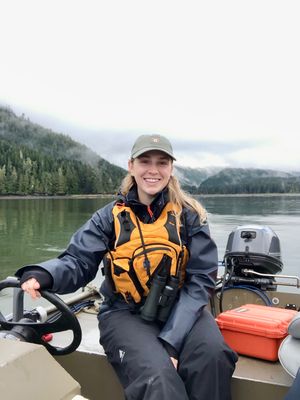
14:25
Transition
14:30
Abstract 236 - Population sex structure and recolonization in the Norwegian brown bear
Pierre Dupont, Norwegian University of Life SciencesHall C
Pierre Dupont, Cyril Milleret, Richard Bischof
1.Population recovery can be a drawn-out process, characterized not only by growing
abundance and expanding range, but also changes in demographic structure. Due to sex
differences in vital rates and dispersal propensity, we expect significant changes in the
population sex structure during population recovery.
2.In Scandinavia, intensive persecution brought the brown bear population to the brink of
extinction in the 1920s. Since then, protective measures and sustainable management have
allowed the brown bear to reclaim much of its former range. In Norway, recolonization started
around the 1970s from areas with higher bear densities in neighboring Sweden, Finland, and
Russia.
3.Using an extensive long-term monitoring dataset and a spatially-explicit population dynamic
model, we estimate and map sex-specific brown bear densities in Norway over the last 11
years. We show how sex ratio evolved over time and demonstrate the decades-long delay in
recovery of this important demographic variable.
4.Due to female philopatry and primarily male-driven dispersal, male-biased sex-ratio
characterized the early stages of the recovery, which was followed by an increase in female
abundance. The speed by which balanced sex-ratio was reached depended strongly on the
distance from the population source.
5.Our findings reveal the important role that of sex differences dispersal and life history play in
shaping the demographic structure and spatio-temporal dynamics of recovering wildlife
populations.

14:45
COFFEE BREAK
Edmonton Convention Centre
15:10
Abstract 250 - The rise and fall? of the Swedish brown bear population
Jonas Kindberg, Scandinavian Brown Bear Research ProjectHall C
Jonas Kindberg, Matthew Grainger, Erlend Nilsen
Effective conservation of the Swedish brown bear population has led to a significant increase in
population size and distribution. Estimates indicate a growth from 130 individuals a century ago
to 3300 individuals in 2008. Consequently, there has been a notable rise in hunting quotas and
protective measures to mitigate depredation. For instance, the number of bears targeted for
hunting has increased from fewer than 100 two decades ago to 750 in 2023, constituting over
25% of the total population.
This rapid escalation has sparked discussions among managers implementing population
reduction strategies without compromising the future conservation status of the population.
Leveraging demographic insights gleaned from research and monitoring, we have developed an
online harvest model specifically tailored for female bears to aid decision-making processes.
This model, constructed as an age-structured population model, features a user-friendly
interface powered by Shiny. This interface empowers managers to input key parameters such
as the population size of females, with 95% confidence intervals from the latest survey, as well
as data on harvested individuals since the last survey and setting a quota for the forthcoming
period. The model outputs projections of female population size for up to five years into the
future.
The rationale behind deploying a web-based model, as opposed to traditional report
dissemination, is to foster greater engagement and understanding of monitoring practices
among stakeholders, thereby enhancing awareness of the repercussions of harvest quotas on
future population dynamics. To facilitate effective utilisation of the model, introductory
seminars and workshops are conducted to address enquiries and solicit feedback for ongoing
refinement of the methodology.
Analysis of model results underscores the need to reassess the sustainability of current harvest
quotas, as they are projected to precipitate a population crash within a few years.

15:25
Transition
15:30
Abstract 313 - New non-invasive method with camera trapping provide data on wild Andean bear body size in Peru
Denisse Mateo, San Diego Zoo Wildlife Alliance / University of San Francisco Quito StudentHall C
Denise Mateo, Russell C. Van Horn, Rebecca Zug
Individual bears vary in body size and condition, which reflect habitat quality, and can influence
their ability to reproduce. Most reports of body size and condition are from direct manipulation
of black bears, brown bears, and polar bears. However, Andean bears are challenging to
capture, and hunting is banned, so there are few direct measures of wild Andean bears. We
present a new non-invasive method to collect body measurements of wild bears from camera
trap photos and videos using horizontal and vertical visual size guides. We demonstrate this
method using data from imagery collected from December 2021 - May 2022 at 3300-3453 masl
in the Manu Biosphere Reserve of SE Peru. As paired cameras were installed there, grid guides
were photographed. In a subset of 149 photo/video sequences, we identified 19 individuals; 13
sequences provided data of known bears of known sex (n=8): 7 males and 1 female. Using the
program ImageJ, we measured 10 body dimensions and repeated each measurement 5 times,
to assess user error. Of those dimensions, we here present one index of body size, horizontal
body length (HBL), and one index of body condition, dorsal-ventral height (DVH), for male and
female bears. Males were on average 17% longer than the female: male HBL averaged (±SD)
127cm (±27.3, 86.8-155.5cm), while the female’s HBL was 105cm (±0.9). Bartareau’s (2017)
data measured directly from American black bears showed that males were on average 11%
larger than females (163.4cm vs 146.1cm) but were 23% longer than the males in our data. The
DVH of male Andean bears was on average 32% larger than the female’s: 40cm (±7.51, 28.9-
46.8) versus 27cm (±1.2), suggesting that males may have been in better condition. We
continue to collect data in this landscape, and in other areas of Peru, to compare data from
bears within and among populations. This method also illustrates a potential use of photos
from other mammal species that are difficult to capture.

15:45
Transition
15:50
Abstract 323 - Building a biometric: Leveraging pose-aware imagery to develop a robust photo-identification for an unmarked species (Ursus arctos)
Beth Rosenberg, Alaska Pacific University StudentHall C
Beth Rosenberg, Mu Zhou, Nathan Wolf, Bradley P. Harris, Alexander Mathis
The importance of distinguishing between individuals of a species is critical for answering a
range of biological and ecological questions. Despite current success in identifying individuals
with patterns or intra-species markings, numerous species exist for which the use of visual
individual identification is restricted or prevented by a lack of obvious uniqueness (e.g. a non-
patterned species in which a readily observable individual identifier is not apparent). Alaskan
coastal brown bears (Ursus arctos) are an example of a species for which the development of
successful and practicable visual individual identification methods is hindered by a lack of
obvious unique or permanent biometric traits. In addition to lacking intra-species markings,
individuals undergo weight gain, fur shed, and scarring which alters appearance and makes
identifying a non-patterned brown bear even more challenging. Robust individual identification
of this species requires the development of a novel technique or the building of a new
biometric. In this study, we take into consideration the physiology, morphology, and behavior
of the species to place conditions on an image dataset, mainly using a pose-aware framework.
We formulate a conditional neural network to provide “permanence” through a multiplicity of
image comparisons, utilizing images and postures that might otherwise be unusable. The
images required for individual brown bear identification are not limited to any one pose or
view, and can handle both occlusions, as well as unknown individuals. Leveraging a large
number of known individual brown bears over time in a unique data set, we demonstrate that
an individual ID for brown bears can be successfully predicted not only over time, but also
across the landscape at locations other than where a bear was first observed or where the
dataset was compiled.

16:05
Transition
16:10
Abstract 278 - Structural connectivity of Sloth bears in Western Maharashtra India
Neelu Soni, Sant Gadge Baba Amravati University StudentHall C
Neelu Soni, Kaushal Patel, Aniruddha Dhamorikar, Prachi Thatte Prashant Thakare
Landscape level connectivity is only possible by conserving corridors. For a species like Sloth
bear whose distribution has become very patchy and fragmented, such measures will be very
effective. Hence, identification of area used by Sloth bears and challenges faced by them is
very important. Here we present an important corridor profile used by sloth bear between
Melghat Tiger Reserve (MTR) and Yawal Wildlife Sanctuary (YWS). Sign survey for sloth bear
was conducted and 200 scat samples of Sloth bears were collected from MTR to YWS including
the non-protected area forming part of this corridor indicating the use of the corridor by Sloth
bears. An easily accessible and dynamic corridor profile with all the information of the corridor
was then made with Coalition for Wildlife Corridors CWC) a network of individuals and
organizations working on corridors across India. A crude delineation of the corridor boundary
using a circuit-theory based modelling approach was done which is around 11241 km2. All the
information available in news articles, literature, and forest department management and
working plans were then collected and reviewed. The information was then arranged in a
designed format for a corridor profile having sections like corridor significance, corridor
characteristics (Physical and Biological), stakeholders and management. We also identified
linear infrastructure as one of the major challenges in the corridor. The corridor is a mosaic
landscape of ~69.23% of agricultural land and ~29.27% forest with some interspersed villages
with nearly 269 persons/km2. Using GIS, the GPS coordinates of scats were used to map their
location to understand the area utilized by them and we identified 4 critical areas as a priority
region in the corridor. This profile highlights the need to declare it as a wildlife corridor and will
provide in depth knowledge to the stakeholders and will also be helpful for planned
development and policy interventions for Sloth bear conservation.

Habitat Relationships - Session Chair Lorraine Scotson
Hall C
16:25
Transition
16:30
Abstract 283 - Huckleberry habitat and its importance to Cabinet-Yaak and Selkirk Ecosystem grizzly bears (Ursus arctos)
Justin Teisberg, US Fish and Wildlife ServiceHall C
Justin Teisberg, Wayne Kasworm, Michael Proctor, Thomas Radandt, Jennifer
Fortin-Noreus, Hilary Cooley
Huckleberries (Vaccinium spp.) are a food of nutritional importance to grizzly bears (Ursus
arctos) within interior populations of North America, providing sugar-rich calories in the late
summer and fall seasons prior to denning. We developed a resource selection function of high-
quality huckleberry habitat important to Cabinet-Yaak and Selkirk grizzly bears, using field-
verified huckleberry foraging radiolocations acquired during prime months of huckleberry
fruiting (July 15 – September 15, 2010–2019, from 22 female grizzly bears). Stepwise logistic
regression analysis identified 12 significant variables in predicting huckleberry habitat
important to female grizzly bears; all were included in a predictive model (Somers’ D = 0.729; K-
S statistic = 0.570, P < 0.00001). Most influential variables (P < 0.00001; positive [+] or negative
[-] relationship) include canopy closure (-), moisture deficit (-), time since last wildfire (-), solar
radiation (+), snow water equivalent (-), and growing degree days above 5°C (-). On average, 28
percent of an adult female annual home range includes predicted huckleberry habitat (x̄ = 61 ±
6.4 [SE] square kilometers). Seasonal ranges of females overlap extensively within predicted
huckleberry habitat, and degree of overlap trends with quality of habitat. Mothers and
daughters display similar selection patterns for predicted huckleberry habitat, suggesting
huckleberries are an important component to range expansion of these populations. Using
energetic predictions of huckleberry foraging in these areas, we find that a smaller average
body size of Cabinet-Yaak and Selkirk adult females (x̄ = 94 kilograms lean body mass) lessens
the energetic constraints of a huckleberry-dominant diet and may be a direct outcome of
huckleberries being a primary food resource for these populations.

Tuesday 17 Sep 2024
07:00
BREAKFAST
Edmonton Convention Centre, Assembly Foyer
08:00
Abstract 12 - Managing Bear Attack Incidents in Canadian National Parks
Steve Michel, Parks Canada AgencyHall C
Steve Michel, Sonia Nicholl, Claire Ewards, David Gummer
Injurious bear incidents occur infrequently in Parks Canada’s protected areas (n=154; n=184
total human victims). From 1900-2023, human fatalities were caused by grizzly bears (Ursus
arctos, n=10) and black bears (U. americanus, n=1). Additional non-fatal injuries (n=147) were
caused by grizzly bears (n=50), black bears (n=91), polar bears (U. maritimus, n=2) and
unidentified bear species (n=4). Bear attacks in Canada’s national parks are extremely rare
(approximately one attack per 13.5 million visits). Bear attack rates have declined by 80%; from
an average of 5.5 attacks/year (1970-79) to 1.1 attacks/year (present). Before garbage
management measures were enacted (circa 1981) human food and garbage were freely
accessible to bears. Most attacks were from black bears in front-country areas (n=55), that
were predominantly food conditioned. Since 1981, bear attacks are more commonly
attributable to grizzly bears in backcountry locations (n=21), including all recorded human
fatalities (n=4). Defense of offspring caused a significant number of bear attacks (n=32);
predatory behaviour was less frequent (n=11). Parks Canada employs emergency procedures to
respond to incidents, prevent further escalation and evaluate contributing factors. Responses
ensure: 1) personnel safety; 2) exclusion of people from incident area; 3) rapid victim
evacuation and treatment; 4) determining attack circumstances; 5) management of animals
involved; 6) collection and documentation of evidence and response actions; 7) accurate and
timely information for agency communications. Staff expertise, supporting agencies, the private
sector, and internal coordination ensure emergency response objectives are achieved. Staff are
trained in Incident Command System wildlife attack response procedures via multi-agency
training courses and tactical response training scenarios. Implementing a national human-
wildlife coexistence strategy will improve agency policy, procedures, and emergency response
capacity.

Human-Bear Conflict & Coexistence - Concurrent Session Chair Rob Gau
Hall C
Abstract 67 - Developing new tools for population estimation: Insights from thermal imaging drones and Kodiak brown bears
Shannon Finnegan, Koniag IncSalon 4
Shannon Finnegan, Peter Olsen, William Wall
Estimating wildlife population densities remains one of the biggest challenges in wildlife
management and conservation. Many species are widely dispersed and occur in remote areas,
making assessments of population sizes and trends very difficult. Without repeated quantitative
estimates of populations, management bodies may face difficulty setting harvest quotas
reflective of realized population sizes. Kodiak brown bears (Ursus arctos middendorffi) are an
important environmental, economic, and cultural resource throughout the Kodiak Archipelago.
Recently, concerns have been raised about potential population declines of brown bears in the
Southern portion of the Archipelago. However, current population estimates were derived from
Intensive Aerial Surveys (IAS) which are expensive and subject to limitations. Financial
constraints result in only small areas of the island surveyed each year, while the ability to detect
bears during aerial surveys can be greatly reduced by vegetation, plane disturbance, weather
conditions and observer experience. Drones (Unmanned aerial vehicles) may provide a new
efficient and cost-effective tool for estimating populations, while overcoming some of the
limitations associated with traditional IAS. Using a thermal imaging drone, we carried out
brown bear surveys along the Sturgeon and Karluk River sheds on Kodiak Island during 2023
and 2024. We explored the use of artificial intelligence for subsequent image processing and
analysis. We discuss the benefits and limitations of this emerging technology for brown bear
management.
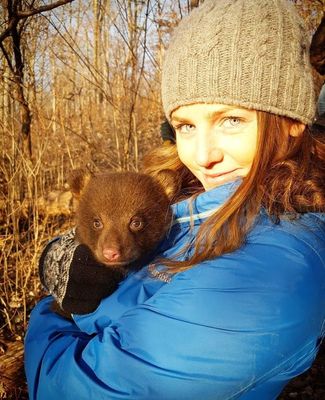
Population Estimation - Concurrent Session Chair Mia Valtonen
Salon 4
08:15
Transition
08:20
Abstract 112 - Identifying the drivers of polar bear-human interactions using remote cameras
Douglas Clark, University of SaskatchewanHall C
Danielle Rivet, Ryan Brook, Alex Crawford, Corey Kramer, Michel P. Laforge,
Julienne Stroeve, Douglas Clark
Polar bear-human conflicts have increased across the Arctic as a warming climate diminishes
their sea ice habitat. However, the mechanisms driving such conflicts remain unclear. Using
remote cameras we observed 580 polar bear visits to three intermittently-occupied fixed camps
and a research station occupied year-round, all near the Hudson Bay coast, from 2011-2021.
We quantified the influence of the timing of sea ice break-up, bear body condition, and human
activity on frequency of polar bear visitation to those four sites. Time since ice breakup drives
polar bear visits but neither poor body condition, which is a known risk for polar bear attacks
on humans, nor human activity, have a significant effect. The likelihood of polar bear-human
interactions was therefore governed by sea ice but independent of nutritional stress.
Consequently, below-average body condition may only mediate which polar bear-human
interactions escalate into conflicts rather than causing the interactions themselves. These
insights resolved discrepancies in previous studies and between scientific and Indigenous
explanations for polar bear-human conflicts. Moreover, the polar bear-sea ice system could be
a useful model for understanding the broader emergent phenomenon of climate change as a
new driver of human-bear conflicts.

Abstract 102 - Genetic Diversity and Population Structure in Ecuadorian Andean Bears
María José Pozo, Universidad San Francisco de QuitoSalon 4
Maria de Lourdes Torres, María José Pozo, Dario Cueva, Rebecca Zug, Santiago Molina, Rodrigo Cisneros, Martín Bustamante
Despite their rich biodiversity and high levels of endemism, Andean countries struggle with
wildlife conservation due to limited resources, hindering conservation effectiveness. Focusing
on charismatic species like the Andean bear (Tremarctos ornatus) has become a strategic
priority, serving as a flagship species for Ecuador and other highly biodiverse countries. This
species is the last living member of the ursid Tremarctinae subfamily and the only bear native
to South America. It plays an important ecological role in maintaining healthy ecosystems by
dispersing seeds and renewing vegetation layers. However, the IUCN classifies it as vulnerable
with a declining population. Genetic studies on threatened species are crucial for
understanding their ecology and resilience to environmental and anthropogenic pressures. Few
previous studies report low genetic diversity in the Andean bear and suggest that populations
are well connected. The results from these studies might be attributed to ascertainment bias as
they were performed with heterologous molecular markers. Our research focuses on three
Ecuadorian populations of Andean bears using species-specific markers. Seven mtDNA markers
and ten microsatellite markers were designed to analyze non-invasive samples from Andean
bears. Our findings reveal a higher genetic diversity in the Andean bear populations studied
than previously reported. Additionally, a population structure was found, suggesting that
Andean bears in Ecuador are not a single, homogenous group but genetically distinct
populations. This highlights the need for addressing habitat fragmentation and promoting
connectivity to ensure long-term survival. The genetic differentiation identified in the three
populations from this study underscores the importance of tailoring conservation strategies to
the specific needs of each population.

08:35
Transition
08:40
Abstract 57 - Ecology of conflict between baiting-dependent bear tourism and reindeer husbandry
Ilpo YJ Kojola, Natural Resources Institute FinlandHall C
Ilpo YJ Kojola, Ville Hallikainen, Samuli Heikkinen, Mikko Jokinen, Jouko Kumpula,
Vesa Nivala
Feeding brown bears by ecotourism enterprises has evoked criticism by some local resident
communities. In Finland where feeding is practiced also in reindeer husbandry region, reindeer
herders are worried about its potentially negative impacts on their livelihood. One relevant
aspect we examined in three-years project (2020-2022) was herders’ concern for loosing parts
of traditional summer ranges owing to spatial avoidance of bear clusters by reindeer. We
estimated that ca. 75-80 bears (68 identified from DNA in scat samples) visited 11 feeding sites
within 3 herding cooperatives in 2021, and 90% of these bears were visitors of 7 sites
established for tourism purposes. All these commercial feeding sites were located at the edge
of a high-density Russian bear population. Statistical analyses provided evidence that GPS-
collared female reindeer avoided Finland-Russia border zone area and, also feeding sites up to
ca. 10 km distance. Avoidance was positively related to the site-specific number of visiting bears
and appeared to have an effect because only a few bear-killed reindeer were found within this
avoidance zone. Genetic analyses indicated that visiting bears moved mostly east (Russia) –
west (Finland) direction because sites locating >12 km from each other did not share same bear
individuals. We propose re-evaluation of the present, very liberal decrees concerning feeding
large carnivores in Finland.

Abstract 152 - 96 SNPs later – the harmonizing and augmenting of the DNA-based brown bear transnational monitoring in northern Europe
Alexander Kopatz, Norwegian Institute for Nature ResearchSalon 4
Alexander Kopatz, Anita J. Norman, Helena Johansson, Mia Valtonen, Ilpo Kojola,
Jouni Aspi, Øystein Flagstad, Oddmund Kleven, Jonas Kindberg, Göran Spong
Brown bears (Ursus arctos) in Fennoscandia comprise two subpopulations, the Scandinavian
(Sweden, Norway) and the Karelian (Finland, northeastern Norway), with roughly 2,700 bears in
each. Isolated in the recent past, their connectivity is now restored. Concurrently, government
bodies of Finland, Norway, and Sweden have increased their transboundary monitoring and
research of brown bear. DNA-based monitoring has long been a crucial component of this work,
but the expanded population range now necessitate method alignment between the two
subpopulations. For more than a decade, the monitoring between Norway and Sweden has
been largely harmonized, but not for the Karelian subpopulation. Our primary objective was to
create an effective and flexible genetic resource that supports management, research, and law
enforcement across multiple countries. We previously tested the established Scandinavian SNP-
panel across the three countries. Results show high resolution for individual identification and
relatedness estimation in Finland, but with signs of ascertainment bias, which can affect many
types of analyses. We therefore sequenced individuals across the target range to identify
markers that provide good resolution at the individual and population level. Based on the
screening, we developed a new SNP panel, including sex chromosome markers. Here we
present lessons learned from more than a decade of DNA-based, transnational monitoring,
including challenges when expanding the range and populations assessed. For wide-ranging
species, such as the brown bear, the appropriate spatial scale for robust inferences often
traverse administrate boundaries, calling for harmonized methods and joint analyses.

08:55
Transition
09:00
Abstract 65 - Resource sharing between human and sloth bear in non-protected forests: A prime reason for human-sloth bear conflicts
Pratikkumar Desai, WCB Research lab, Department of Life Sciences, Hemchandracharya North Gujarat University StudentHall C
Pratikkumar Desai and Nishith Dharaiya
Sloth bear is considered among the most unpredictable large mammal and on an encounter, in
an attempt of self-defence attacks on humans. People living in and around the forest, share
resources with sloth bear which often resulting into conflicts and causing human casualties. A
rise in anthropogenic activities in the non-protected forests has led to degradation of habitat,
reduced forest cover and food broadly supporting our finding that most of the sloth bear
attacks are due to penetration of sloth bears in human dominated areas for food and water. A
total of 234 incidents of sloth bear attacks in last twelve years (2008-2020) from central Gujarat
were recorded. Out of these, more than 80% of attacks caused minor injuries suggesting the
attacks were in response to attempt of self-defence by a bear. The analysis of data reveals
three key reasons for the sloth bear attacks: sharing of resources, fragmented bear habitat and
bear movement near the village. However, the highest conflict occurred due to resource
sharing (47%) followed by fragmentation (33%) and movement of sloth bear near villages
(20%). We found that the conflicts are more significant due to resource sharing compare to
habitat fragmentation and sloth bear movement. Most of these areas are used by local people
for common resources, as they are depended on the forest products and water being a limiting
factor in summer forcing the bear to visit the villages. Chi2 test shows significant difference
between these groups (X2=10.96; df=4; p=0.027). A thorough study of spatio-temporal overlap
between locals and bears helps to identify the areas for regulating human activities to reduce
the sloth bear encounter. Creating the water accumulation points inside the forest area can
also help regulating bear movement in the summer. Maintaining the remaining forest cover and
restricting anthropogenic pressure may enhance the harmonious living with the neighbouring
sloth bears in this important sloth bear corridor.

Abstract 154 - Demographic portrait of the brown bear population in the Western Carpathians.
Nikola Tkáčová, Charles University StudentSalon 4
Nikola Tkáčová, Jana Šrutová, Barbora Černá Bolfíková, Veronika Kornová, Mária
Apfelová, Michal Kalaš, Vladimír Antal, Slavomír Finďo, Marián Hletko, Pavel Hulva
In recent years, ecology has undergone a paradigm shift, recognizing the crucial role of large
mammals including bears, as keystone species. The Western Carpathian population of brown
bear (Ursus arctos) represents a phylogeographic lineage split from the continental lineage,
which differs from populations in the rest of the Carpathians. The Present study aimed to assess
the population size and genetic diversity of this population. A total of 2172 samples were
collected within Slovakia between 2019 and 2021. A combination of non-invasive genetic and
closed model capture-mark-recapture methods was utilized. Eight microsatellite loci and one
sex marker (SRY gene) were amplified, with 48% of genotypes meeting the quality criteria
ensuring sufficient statistical power of the dataset. The Slovak brown bear population
demonstrates a comparable level of heterozygosity (Ho = 0.69) to that observed in regions
characterized by robust conservation efforts and pristine landscapes. The sex ratio was skewed
in favor of females after modeling. Population size estimates were determined using several
approaches, yielding consistent results, and respective hypotheses were tested through
simulation procedures. For instance, employing the TIRM model yielded estimates ranging from
1012 to 1275 individuals. Population density was determined utilizing the resulting abundance
estimates and the total area of confirmed bear occurrence. The resultant value is approximately
10 individuals per 100 km². The effective population size was estimated using the linkage
disequilibrium method to be 144—230 individuals. This value does not exceed commonly
reported recommendations for minimum viable population size, so it is important to consider
also potential future scenarios involving loss of genetic variation due to inbreeding, genetic drift
and genetic erosion.

09:15
Transition
09:20
Abstract 70 - Targeting 'Social Carrying Capacity' with Risk Preference Elicitation During Predator Recovery
Chandler Hubbard, University of Wyoming StudentHall C
Chandler Hubbard, Ian Fletcher, Todd Cherry, Jacob Hochard, David Finnoff
Large predators worldwide are returning to landscapes where they have been extirpated for
centuries. In communities intolerant of recovery, the ``Social Carrying Capacity" is often more
restrictive that its biological analogue and diverse human preferences complicate traditional
conservation approaches. Yet, wildlife managers often lack formal preference elicitation
training and the social carrying capacity concept tends to be used as an academic metaphor,
rather than a pragmatic management tool. We evaluate individual risk preferences in a
nationwide context where federal agencies have published management guidelines for
responding to property-damaging and human-threatening grizzly bears (Ursus arctos horribilis).
Respondents ($n=2,433$) reveal a desire for more management tolerance following both
violent and non-violent encounters than is currently afforded. Unfamiliarity with federal
guidelines leads respondents to believe that grizzly bear encounters are managed more
consistently with their own desires than occurs in reality. We offer a nationwide prediction of
risk management preferences across all contiguous United States zip codes using social,
geographic, landscape and demographic indicators. The general approach holds promise for
identifying new predator reintroduction and recovery sites, modernizing place-based guidance
for predator management and predicting the intensity of human-wildlife conflict and its
associated management costs from natural predator dispersal.

Abstract 19 - Predicting the potential habitat of bears under a changing climate in Nepal
Rishi Baral, Hokkaido University, Laboratory of Wildlife Biology and Medicine, Sapporo, Japan StudentSalon 4
Rishi Baral, Rajan Prasad Paudel, Binaya Adhikari, Rabin Kadariya, Naresh Subedi,
Bed Kumar Dhakal, Michito Shimozuru, Toshio Tsubota
In Nepal, the distributions of three bear species vary: sloth bears (Melursus ursinus) in the
lowlands, Asiatic black bears (Ursus thibetanus) in the mid-hills, and brown bears (Ursus arctos)
in the high Himalayas. We utilized 179 occurrence points for sloth bears, 199 for Asiatic black
bears, and 41 points for brown bears to construct a habitat model incorporating climate and
topographic variables. Employing various species distribution modeling algorithms in BIOMOD2,
the model predicts suitable habitats spanning 10,971.75 km2 for sloth bears, 29,470.75 km2 for
Asiatic black bears, and 6,152.97 km2 for brown bears. Within protected areas, the habitat for
sloth bears is 4,120.56 km2, that for Asiatic black bears is 9,688.67 km2, and that for brown
bears is 4,538.67 km2. Chitwan National Park emerged as the prime sloth bear habitat with a
core area of 918.55 km2 and a buffer zone of 726.485 km2. The Annapurna Conservation Area
was deemed suitable for Asiatic black bears and brown bears, covering 2,802.23 km2 and
2,795.91 km2, respectively. The models projected a significant reduction in the habitat of these
bear species both inside and outside protected areas. As predicted under the Shared
Socioeconomic Pathways (SSP)2-4.5 scenario, sloth bears may experience 54.9% (2050) and
44.7% (2070) losses, respectively, of habitat; Asiatic black bears, 11.2% (2050) and 16.8%
(2070); and brown bears, 68.41% (2050) and 82.20% (2070) losses. The overlap between sloth
bears and black bears spans 38.7 km2, and that between brown bears and black bears is 26.6
km2. Notably, all three bear species exhibited suitability correlations with the intermediate
temperature of the driest quarter. Examining current and projected habitats provides essential
information for guiding conservation strategies and ensuring the conservation of these bear
species in the face of climate change.

09:35
Transition
09:40
Abstract 78 - A forecast of human-wildlife incidents could help authorities anticipate risk and early react in Europe's largest brown bear (Ursus arctos) population
Ancuta Fedorca, National Institute for Research and Development in Forestry “Marin Dracea”Hall C
Ancuta Fedorca, Pino Maria Sanchez, Mihai Fedorca, Marius Popa, Georgeta
Ionescu, Ovidiu Ionescu, Ramon Jurj
Human-wildlife coexistence is one of the central concerns in species conservation worldwide.
The increasing interactions between large carnivores and humans directly impact social
development strategies, which resonates in the public perception of these species and
unleashes negative consequences on ecological connectivity. In recent years, the increased
brown bear population within the Romanian Carpathians calls for urgent action to address
conflict management. We applied a holistic approach combining theoretical and practical
grounds to spatially predict the risk of human-bear conflict at Romania’s regional and national
levels. Two-fold analyses were performed based on i) the maximum entropy algorithm,
analysing data collected from emergency calls that reported brown bear incidents from 2017 to
2023, and ii) circuit theory, using practitioners’ knowledge to assign resistances to features that
characterize the hunting grounds. In addition, we analysed bear movement pathways
connecting conflict hotspots with the surrounding landscape. Higher risk indicators of human-
bear conflict correlate to human settlements in mountain valleys, agroforestry systems and
broadleaved forest patches adjacent to localities with significant fragmentation levels, reaching
0.9-0.8 rates. The results outline that medium and low-risk areas surrounding small towns and
communes are top-priority areas for prevention measures before conflict reaches high-risk
points, covering 15% area of the national extent. The designed spatial approach intends to help
managers implement carnivore deterrents and improve the efficiency of emergency
interventions to mitigate conflict.

Abstract 157 - Population estimation of Gobi brown bear and their movement in the Great Gobi A Strictly Protected Area, Mongolia
Battogtokh Nasanbat, Czech University of Life Sciences Prague StudentSalon 4
Battogtokh Nasanbat, Francisco Ceacoero, Petr Matějů, Ariunbuyan Khurelbaatar,
Barbora Černá Bolfíková, Samiya Ravchig
Robust population estimation of rare or elusive threatened species lacking distinct identifiable
features poses a challenge in the field of conservation and management. The Gobi brown bear
(Ursus arctos) is one of such species living in geographically isolated and inaccessible harsh
desert areas of Great Gobi A Strictly Protected Area. Population size is one of the primary
parameters determining urgency of conservation action, and it provides baseline data against
which to measure progress toward recovery. We designed a camera-based approach to
estimate population during period of greater activity of the bear from June to September at the
main 13 natural springs in the whole protected area based on our previous study and also
combined with meta-barcoding analysis based on hair samples 2022 and 2024. We used criteria
to identify individual Gobi brown bears based on shoulders-mark patterns and tested the level
of congruence among 3 independent observers using a set data of photographs collected in
2018, 2020, 2022 and 2024.
We grouped the main 13 natural springs into three mountain ranges: Tsagaan Bogd, Shark
Khulst, and Atas Inges mountains. In 2018, 4451 pictures were evaluated by the researchers,
and average congruence among observers resulted in 33-36 individuals. Only 4 males and 1
female were observed in more than one mountain ranges. In 2020, 1094 pictures of the brown
bear have been evaluated and average congruence among observers resulted in 27-31
individuals: 10-12 adult males, 6-8. Only 3 males were observed in more than one mountain
ranges. In 2022, the average congruence among observers resulted in 22-25 individuals. Only 1
male was observed in more than one mountain ranges. We will carry out similar survey this
year (2024) and will also collect hair samples. The molecular biological analyses on the hair
samples are still in progress and results will be presented at the conference combining different
sampling techniques.

Habitat Relationships - Concurrent Session Chair Matthew Gould
Salon 4
09:55
COFFEE BREAK
Edmonton Convention Centre
10:20
Abstract 79 - Understanding ecological and anthropological determinant to devise effective human-sloth bear conflict mitigation strategies in Gujarat, India
Aditya Dharaiya, Department of Geology, Savitribai Phule Pune University StudentHall C
Aditya Dharaiya, Pratikkumar Desai, Nishith Dharaiya
The burgeoning human-wildlife conflicts, particularly those involving sloth bears, underscore
the pressing need to understand the intricate interplay between human activities and wildlife
habitats. Sloth bear attacks in Gujarat, India, are on the rise due to expanding human
populations encroaching into sloth bear habitats, a thorough assessment on the relationships
between these ecological and anthropological determinants to understand and develop
effective conflict mitigation strategies. The study aims to focus on the sloth bear distribution
with respect to the change in land cover and land use over 30 years, alongside the impact of
anthropogenic activities over sloth bear habitat, might lead to conflict will be taken into
account through census and field surveys. This research adopts a multifaceted approach,
leveraging remote sensing data from satellite sensors like LANDSAT, SENTINEL, and CARTOSAT
through which, the extent of forest fragmentation, overlaid on the conflict locations and bear
presence data. Overlaying conflict data and human population onto these spatial analyses
offers crucial insights into the relationship between habitat fragmentation, human presence
and the emergence of conflict hotspots. In these 30 years (1993 – 2023), more than 500 conflict
cases have been recorded and the total human population has been increased from ~9 million
to 17 million alongside, the sloth bear population have also increased ~60%. We found that, the
dense forest has been decreased by ~35% with increase in Builtup area (7%) and open forest
and barren land (10%). Here we will present how the habitat fragmentation have accelerated
conflict issues and the science-based mitigation measures. Our results were used in identifying
potential sloth bear corridors, we delineate pathways crucial for their movement and dispersal,
thereby aiding in the formulation of a robust conflict mitigation plan tailored to the Gujarat
context.

Abstract 25 - Brown bear occurrence along a proposed highway route in Romania’s Carpathian Mountains
Csaba Domokos, Milvus Group Bird and Nature Protection AssociationSalon 4
Csaba Domokos, Sebastian Collet, Carsten Nowak, Ferenc Jánoska, Bogdan
Cristescu
Major road developments are planned or ongoing throughout the range of the Romanian
brown bear (Ursus arctos) population, which is numerically the largest in the European Union.
The planned A8 (Tîrgu Mureș–Iași–Ungheni) highway crosses the Romanian Eastern Carpathians
on their entire width, posing a risk to the Romanian and broader transfrontier Carpathian bear
population. In the summers of 2014, 2017 and 2020, we surveyed an 80 km-long section of the
planned highway using baited hair traps (n = 68 throughout all sessions, with three additional
traps active only in 2020) mounted in pairs along the route. We aimed to assess bear
occurrence, movement, and to estimate the minimum number and sex ratio of bears present in
the area. With an effort of 3,519 hair trapping days (17 days / trap / session), we identified 24
individuals from the collected hair samples (n = 45), with a higher prevalence of female bears
(male:female sex ratio of 1:1.3). We did not document individual bears crossing the planned
highway, but detected functional connectivity across the planned highway through parent-
offspring (4 cases), full-sib (2 cases) and half-sib (24 cases) genetic relationships among sampled
individuals. We analyzed habitat characteristics and human-related covariates associated with
hair trap locations to identify influences on bear presence and found that terrain ruggedness
and longitude were the most important predictors of bear occurrence. Bears consistently
occurred in rugged terrain in the Western part of the study area, and were often detected close
(< 1 km) to human settlements. Even before the construction of the A8 highway, connectivity is
likely already limited by the existing extensive network of settlements, being restricted to a few
important linkage areas still free of developments. Additional threats to bears and other wildlife
in the area include poaching and large numbers of free-ranging dogs. We provide
recommendations to mitigate these threats.
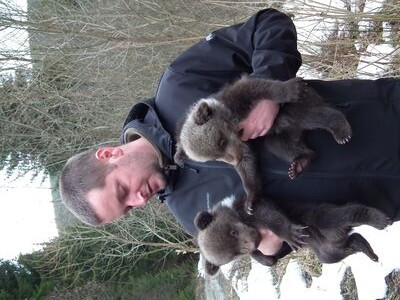
10:35
Transition
10:40
Abstract 83 - Drones outperform dogs hazing bears: community-based carnivore scare tactics
Wesley Sarmento, Montana Fish, Wildlife and ParksHall C
Wesley Sarmento
Human-wildlife conflict can result in harm to people, their livelihoods, and frequently ends in
reduced tolerance for species and/or removal of animals. Preventing conflicts is essential for
conserving carnivore populations. Here I conduct a six-year study of the efficacy of a hazing
methods to prevent conflicts at deterring grizzly bears (Ursus arctos) away from people on the
prairies of North-Central Montana. I tested a burgeoning technology, drones, and traditional
methods of hazing bears including dogs, projectiles, and vehicular pursuit. Hazing stopped
undesirable behaviors and caused a significant increase in avoidance behavior and distance to
human infrastructure. Results suggest aversive conditioning occurred over longer time scales as
older bears required less hazing and hazing events decreased over each calendar year. Drones
outperformed other hazing techniques where the odds of a pursuit being possible increased
122 times relative to vehicular chasing due to accessibility issues. Dogs required high
maintenance and had an 85% reduction in the odds a hazing event would be successful relative
to vehicular pursuit. Grizzlies selected for flight locations further from roads and closer to
waterways. To broaden our understanding of deterrence techniques I conducted a systematic
literature search of peer-reviewed studies assessing hazing efficacy on predators globally.
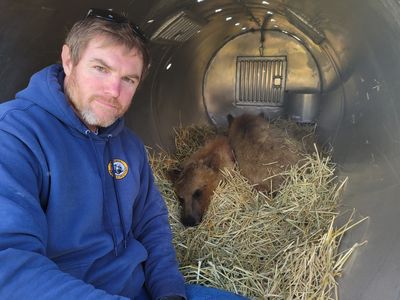
Abstract 35 - Past and Present Distribution Ranges of the Asiatic Black Bear (Ursus thibetanus)
Unza Waqar, Pir Mehr Ali Shah Arid Agriculture University, Rawalpindi, Pakistan StudentSalon 4
Unza Waqar, Tariq Mahmood, Muhammad Mushtaq, Muzna Kashaf, Shehar Bano,
Ayesha Sheraz, Kainat Zamir, Syeda Qanitah Ayesha, Nuzhat Naseem
The Asiatic black bear, Ursus thibetanus, is a species of ecological importance, yet our
understanding of its historical distribution remains limited. While its current distribution is
available on the IUCN Red List of Threatened Species, there is a lack of information regarding its
past range. Our study aimed to address this gap by investigating the historical distribution of
the Asiatic black bear, mapping its total range, and comparing it with the current distribution.
Additionally, we analyzed protected areas within both historical and current ranges to assess
changes over time.
Using Geographic Information System (GIS) software, we reconstructed the historical range,
utilizing published records of the species' occurrence throughout history. The results revealed a
significant contraction in the Asiatic black bear's range, with the historical span covering
approximately 15.86 million km², compared to the current distribution of about 7.85 million
km² – indicating a reduction of approximately 49.5% (8.02 million km²).
Furthermore, the study explored the network of protected areas, noting a decrease of 27.5% in
the number of protected areas within the historical range, emphasizing the urgent need for
conservation efforts. The total protected area in historical ranges was 9,933, covering 0.946
million km², while the current range comprises 6,580 areas, totaling 0.667 million km².
This research contributes valuable insights into the historical dynamics of the Asiatic black
bear's distribution, providing a foundation for more effective conservation strategies. The
utilization of GIS tools allows for a comprehensive exploration of factors influencing the species'
decline, emphasizing the importance of proactive management and conservation measures.
These findings underscore the critical need for conservation efforts to safeguard the Asiatic
black bear's population and its habitat for the present and future.

10:55
Transition
11:00
Abstract 91 - Bear Management-Related Terms for Standardized Use
Carl Lackey, Nevada Department of WildlifeHall C
Carl Lackey, Dave Telesco, Hillary Cooley, Kim Annis, Dave Battle, Paul Frame,
Lindsey Mangipane, Colleen Olfenbuttel, Mark Vieira, Tammy Waldrop
The ability of North American wildlife agencies to accurately define and share information
about human-wildlife conflict is important for agency conservation efforts, interagency
communications, and public education. To manage human-bear conflict, it is essential that
interagency communication and public messaging be effective and consistent. Yet, defining
human-bear conflicts can be difficult and application is inconsistent. Further, some commonly
used terms used in agency messaging and often repeated by the public are subjective and can
have negative connotations for bears. The International Association for Bear Research and
Management’s (IBA) Management Committee, with members representing nine jurisdictions in
North America, conducted a literature search of terms and definitions used in bear
management and bear research to: (1) identify terms and definitions that were clear, concise,
and used consistently among jurisdictions; (2) identify terms that were inconsistently used and
defined; and (3) identify terms that should be removed from written and verbal agency
messaging that lead to mischaracterization of bears. Here we present ten terms and definitions
that will facilitate clear and consistent communications and allow jurisdictions to better
compare databases. We also identify five terms that should be removed from professional
wildlife management vernacular and publications on human-bear conflicts.

Abstract 42 - Summer diet and energetic balance in Arctic coastal grizzly bears relative to polar bears
Anthony Pagano, US Geological SurveySalon 4
Anthony Pagano, Karyn D. Rode, Kerry L. Nicholson, Nicholas J. Lunn, David
McGeachy, William B. Leacock, Charles T. Robbins
Climate warming is increasing polar bear land use across much of their range. While on land
polar bears are without access to their primary seal prey and have been shown to lose body
mass potentially making them vulnerable to starvation. Yet, in some areas, polar bear land use
overlaps with Arctic grizzly bear habitat, where terrestrial foods are sufficient to sustain grizzly
bears. We measured the energy expenditure, changes in body mass, behavior, diet,
movements, and activity of 12 Arctic grizzly bears on the North Slope of Alaska over 17 – 22
days between August to September to compare to similar measures collected from 20 polar
bears on land in Manitoba, Canada. Across 4 age and sex classes, Arctic grizzly bears largely
gained mass over 3 weeks (mean = 0.2 kg/day, range: -0.20 – 0.65 kg/day), while polar bears
lost mass with the exception of one individual (mean = -0.9 kg/day, range: -1.7 – 1.6 kg/day).
On average, Arctic grizzly bears moved 2.8× greater distances. The mean mass-specific energy
expenditure of two Arctic grizzly bears was 2.7× greater than the mean energy expenditure of
20 polar bears on land and similar to the mean energy expenditure of polar bears on the spring
sea ice. Grizzly bears consumed waterfowl, vegetation, berries, fish, moose, and caribou, while
polar bears consumed waterfowl, vegetation, berries, seal, and beluga. Our findings indicate
that the smaller body size of Arctic grizzlies (50% lower body mass than the polar bears we
sampled) allows them to more efficiently forage on terrestrial foods relative to polar bears.
Nevertheless, although terrestrial foods largely compensated for the energy expended to
acquire them, they provided relatively small energetic surpluses during a period when grizzlies
are typically building fat deposits in advance of winter hibernation. These findings reinforce the
hypothesis that most terrestrial foods within the polar bear’s range are inadequate to prolong
the period they can survive on land.

11:15
Transition
11:20
Abstract 338 - The Canine Conundrum: Is a Dog a Help or Hindrance in Bear Country?
Tom Smith, Brigham Young University, Provo, UT, USAHall C
Tom Smith, Stephen Herrero, Hank Hristienko, Lana Ciarniello, Linda Wiggins
In 2023, a tragic incident occurred in Canada's Banff National Park where two people and their
dog died as a result of a grizzly bear attack. This occurrence revived discussions first reported
by Hristienko and Herrero (2014) as to the potential dangers and benefits of bringing one’s
dog(s) into areas inhabited by bears. To address these questions, we analyzed more than 300
human-bear conflicts, between 1901 and 2023, that involved dogs and the three North
American bear species (Ursus americanus, U. arctos, U. maritimus). This database is currently
being finalized but preliminary results suggest that most of the time, the dog triggered the
attack and when this happened the victims were at least slightly injured. Interestingly, we also
recorded multiple attacks where the dog saved the owner, or at the least lessened the severity
of the attack. Contrary to this finding, there appear to be few attacks where the owner actually
saved the dog. Although the status of the dog being leashed or unleashed is unreported in the
majority of encounters, preliminary results suggest that unleashed incidents outnumber those
involving leashed dogs 4:1. This work will help to inform data-driven guidelines on humans and
dogs in bear country.

Abstract 50 - Black Bear Habitat Use and Movement in Response to Wind Energy
Tawnee Dupuis, University of Alberta StudentSalon 4
Tawnee Dupuis, Jaclyn Comeau, Katherina Gieder, Mark S. Boyce
The American black bear (Ursus americanus) is the most widely distributed bear species in
North America. Historically, black bears occupied the majority of forested areas on the
continent. However, with the growth of the human footprint, the quality and quantity of
forested habitats available to bears has declined substantially. To prevent human-bear conflicts
while maintaining a sustainable black bear population, preserving high-quality habitats is
essential. An emerging threat to habitat quality is wind power development. While the impacts
of wind energy projects on bats, migratory birds, and raptors are well-documented, there is
little research on the potential effects that these developments have on terrestrial mammals,
such as bears.
The objective of this project is to quantify changes in black bear habitat use in response to the
construction and operation of a wind energy facility. Between 2011 and 2020, 40 black bears
were collared and equipped with GPS transmitters in southwestern Vermont, USA, where the
first industrial-sized wind project within a National Forest was built in 2017. This construction
footprint overlapped with areas of previously intact black bear habitat. Geospatial satellite-
derived data from collared bears was collected during all three phases of the wind project
development: before construction, during construction, and during subsequent operation. We
compared used bear locations between the different construction phases using a mixed effect
latent selection difference function. Additionally, step selection functions to describe
movement and habitat selection during the different construction phases. This project aims to
quantify the magnitude and extent to which habitat use is impacted by wind development.
These findings will direct future wind energy development plans to mitigate impacts on black
bears and other terrestrial mammals.

11:35
Transition
11:40
Abstract 59 - Sloth Bear Long Distance Dispersal
Thomas Sharp presenting for Shanmugavelu Swaminathan, Wildlife SOSHall C
Shanmugavelu Swaminathan, Thomas Sharp, Arun Sha, Kartick Satyanarayan,
Geeta Seshamani
Long distance dispersal is requisite to the health and long-term survival of wild bear
populations. Habitat loss and fragmentation as well as human activity and land use make long
distance dispersal more dangerous to bears and other wildlife, due to the possibility of falling
victim to anthropogenic risks such as roads and open wells. We know from DNA studies
conducted in Central India that sloth bears disperse across areas that are not well forested,
however, until now there has been no documentation of a sloth bear long-distance dispersal
across a fragmented landscape. Here we describe the longest documented dispersal journey of
a sloth bear across a fragmented habitat. In 2022 we fitted ten sloth bears with GPS iridium
collars in two Sloth Bear Sanctuaries, Daroji and Gudekote, in the southern state of Karnataka,
India. In 2023 a collared 3–4-year-old female, which we named Bindhu, left her home range in
Gudekote Sloth Bear Sanctuary and traveled 162 kms (139 km straight line distance) over an 11-
day period to eventually settle in Gangapalli Reserve Forest in the neighboring state of Andra
Pradesh. We analyzed movement metrics, directionality, and space use during three behavioral
stages of dispersal, 1) pre-dispersal, 2) dispersal and 3) post-dispersal. We compared
movement during the day to movement during the night as well as how the bear used different
habitat types. We looked at major barriers, such as roads, and any peculiarities in crossing
those barriers. Additionally, we looked at other interesting factors that may have played a role
in Bindhu dispersing from her natal area. Including the fact that while Bindhu dispersed, her
female sibling (Cindhu) stayed in her natal area. Before Bindhu‘s dispersal the home ranges of
these two sisters overlapped to a large degree.

Movement Ecology - Concurrent Session Chair Becky Zug
Hall C
Abstract 54 - Sloth bear den study with reference to their geo-morphology and den selection in the dry deciduous forests of Gujarat state, India
Sarthak Chaudhary, UGC-CAS Department of Biosciences, Saurashtra University StudentSalon 4
Sarthak Chaudhary, Nishith Dharaiya, Suresh Chovatiya, Thomas Sharp
Sloth bear denning ecology is complex and largely unknown. We located maternal and resting
sloth bear den in the forests of central Gujarat, at the western edge of sloth bear range and
collected data on den locations and other physical characteristics. The study area, though
patchy and fragmented and surrounded by agricultural lands with substantial anthropogenic
pressure, acts as a corridor linking two protected areas namely Ratanmahal and Jambughoda
Wildlife Sanctuaries and is a home to roughly 100 sloth bears. Dens were located by gathering
information from the local forest staff and forest dwellers. These dens were then authenticated
by visiting the den site and documenting sign as well as setting up camera traps to collect
photographs of bears using the dens. Out of 62 dens identified, 21 maternal dens and 41 were
confirmed as resting dens. All the dens were found in the naturally occurring caves. Maternal
dens were found at a higher elevation (330 ± 57.64m) and steeper slopes (14.01º ± 4.41) than
resting dens (288.78 ± 51.02m, 12.78º ± 5.16). No significant differences were found in regard
to aspect or ruggedness. The mean distance from water sources to both maternal and resting
dens was closer than the forest boundaries, human settlements, and roads. Resting dens were
observed in open, moderate, and moderately dense forest. Maternal dens tended to be located
close to forest boundaries but far from human settlements. The resulting information of sloth
bear denning in this study area will help with regional sloth bear habitat management as well as
giving further insight into the overall complexity of sloth bear denning across their range. It may
also be useful in mitigating human-sloth bear conflicts by restricting human activities in
identified denning locations.

12:00
STUDENT LUNCHEON
CRAFT Brew House
LUNCH
Edmonton Convention Centre
13:30
Abstract 33 - Spatial Behavior of Grizzly Bears in the US Northern Rockies
Sarah Sells, U.S. Geological Survey, Montana Cooperative Wildlife Research UnitHall C
Sarah Sells, Cecily Costello, Paul Lukacs, Lori Roberts, Milan Vinks
Once-contiguous grizzly bear (Ursus arctos) populations remain largely isolated in the western
US. Research has been needed to understand habitat use and assess potential corridors that
could promote genetic and demographic connectivity among recovery ecosystems. Accordingly,
our objective was to model grizzly bear habitat use, movements, and population connectivity.
We employed GPS data from male and female grizzly bears in Montana’s Northern Continental
Divide Ecosystem (NCDE) and an integrated step selection function approach to test hypotheses
of habitat selection and simulate movements. Results demonstrated highly individualistic
behaviors, with some individuals avoiding and others preferring various features like forest
edge, riparian areas, and secure habitat. Such individualism supported the need for an
individual-based modeling approach to understand and predict grizzly bear behavior.
Simulation of movements using each individual’s model within and near the NCDE produced
habitat maps with high predictive power. Simulated pathways from the NCDE to nearby
recovery areas revealed pathways bears may use under varying levels of exploratory versus
optimal movements. The predicted habitat and pathways identified by our study can be
targeted for proactive conservation efforts such as conservation easements, conflict
prevention, and road mitigations to help recover grizzly bears in western Montana and beyond.

Abstract 298 - Determining the importance of kokanee salmon to grizzly bears in central British Columbia
Shelley Marshall, Government of British ColumbiaSalon 4
Shelley Marshall, Dexter Hodder, Matt Scheideman, Kara MacAulay, Clayton Lamb,
David Breault, Adrian Batho, Morgan Anderson
Conservation and stewardship of wildlife requires an understanding of how landscape and
climate change influence the interactions between wildlife and their environment. Grizzly bears
(Ursus arctos) in central B.C. rely primarily on plant-based foods and terrestrial meat sources to
meet their energetic requirements though are known to sometimes consume kokanee salmon.
Abnormal weather patterns can vary food availability through late spring green-up, berry crop
failures, or droughts constraining fish movement. Climate and landscape change can accentuate
effects on temperatures, water flow, and precipitation. Given the effects of landscape and
climate change on fish spawning, managers must understand if kokanee are important to these
grizzly bears to consider appropriate actions to maintain this food source. Through five years of
non-invasive hair sampling along three kokanee streams, we quantified the use of kokanee by
grizzly bears. As predicted, spawning kokanee were an important food source in our study area.
We detected 89 individual grizzly bears at these streams which reside in two of the lowest
density population units of grizzly bears in B.C. Isotope and mercury analysis demonstrated the
importance of this kokanee resource given its relatively short availability (~30 days). Mark-
recapture analysis found a positive relationship between berry abundance and bear use of the
kokanee streams. This may be an example of macronutrient optimization as the habitat in and
around these kokanee spawning streams was a mosaic of riparian retention and cutblocks
supporting both berry production and kokanee spawning habitat. We recommend protection
measures to maintain the integrity of the spawning grounds, identification of nearby kokanee
spawning streams and similar protections considered, and continued monitoring to provide
additional insights into the importance of kokanee beyond the variability in conditions
(drought, fires, high water) captured during this study.

13:45
Transition
13:50
Abstract 121 - New insights into Andean bear movement ecology across the Ecuadorian Andes
Francisco Castellanos, Fundación Oso Andino StudentHall C
Francisco Castellanos, David Jackson, Stefano Mezzini, Jorge Brito, Armando
Castellanos
The Andean bear (Tremarctos ornatus) is a charismatic yet shy mammal that plays a key role in
maintaining ecosystems along the Andes. Ever since the first trapping and tagging of specimens
with VHF or GPS collars, research on their behavior has heavily relied on home range data as a
proxy to report behavior patterns, often drawn from biased datasets. This study reports the
first GPS-based investigation into the movement ecology and autocorrelated home range
estimates of a metapopulation consisting of 6 female and 3 male Andean bears spanning
various ages, inhabiting the northern and central Ecuadorian Andes. Over a decade, our
research and conservation project has tracked these animals for periods ranging from 5.5
months to 2.8 years, collecting a total of 26,884 unbiased GPS fixes. Remarkably, home range
sizes were considerably variable, ranging from 16.4 – 143.1 km2 in females, and 183.9 – 242.3
km2 in males. Continuous-time movement speeds showcased significant diurnal disparities,
fluctuating between 5.43 – 9.03 km/h during the day versus 0.85 – 2.70 km/h at night. Ongoing
analyses suggest nocturnal movements may be driven by environmental factors like
temperature and precipitation, though further investigation is needed to elucidate these
dynamics. These findings expand our knowledge of female home range occupancy, revealing
sizes up to 10 times larger, and 2 – 4 times larger in males than previously reported. These
differences may be related to the age of the animal, type of habitat, food availability, or estrus
cycles in females. The incorporation of this knowledge into the species’ biology and ecology will
foster protection efforts for this majestic and iconic mammal species native to South America.
Consecutively, safeguarding the protection of larger areas of paramos, cloud forests, and high
grasslands, all habitats that are increasingly threatened by deforestation and livestock farming.

Abstract 14 - When Apex Predators Become Prey: Testing the Risk Allocation and Starvation-Predation Hypothesis in the American Black Bear
Emily Davis, University of Wyoming StudentSalon 4
Emily Davis, Daniel Bjornlie, Ryan Kindermann, Daniel Thompson, Joseph Holbrook
Tradeoffs between risk and reward aid in understanding and predicting behavioral responses
within predator-prey systems. Prey species must balance the risk of predation while acquiring
key resources for survival and reproduction. This balancing act has established key ecological
concepts such as the risk allocation hypothesis and the starvation-predation hypothesis, which
suggests prey temporally avoid risk when spatial avoidance is unattainable and individual
nutritional state modulates anti-predator behavior, respectively. While these foundational
concepts are classically studied in predator-prey systems, and more recently between meso-
predators and apex predators, dynamic sources of risk in human-dominated landscapes have
indicated the importance of extending the classic predator prey-model to a human-prey model.
Mortality risk generated by hunter harvest of American black bears (Ursus americanus)
provides an unconventional system to test and extend foundational hypotheses in predator-
prey ecology. We assessed if black bears balanced mortality risk with the spatially coincident
reward of food-laden bait. According to the risk allocation hypothesis, we assessed if black
bears selected for bait differently according to time of day, sex, and age. We additionally
determined if season, alternative forage around bait, and body fat affected selection of bait to
test the starvation-predation hypothesis. Black bears temporally avoided risk associated with
daytime hunting hours and altered risk taking behavior based on age, sex, and body condition.
We provided support for both hypotheses, and suggest that risk is disproportionally distributed
among individuals. Extending foundational predator-prey understandings to a human-predator
system provided empirical evidence of how large carnivores contend with risk, and supports
management implications of hunter preference when hunting bears over bait.

Bear Behaviour - Concurrent Session Chair Thomas Sharp
Salon 4
14:05
Transition
14:10
Abstract 129 - Asiatic black bear responses to roads: Sex- and season-related variations in road proximity, movement, and crossing
Seungyun Baek, Tokyo University of Agriculture and Technology StudentHall C
Seungyun Baek, Andreas Zedrosser, Tomoko Naganuma, Koji Yamazaki, Shinsuke
Koike
Animals commonly avoid roads and areas close to roads due to the high risk of vehicle collisions
and encountering humans. However, animals can cross roads and/or use roads as well as areas
close to roads to access resources or facilitate movement efficiency. In particular, apex
consumers living in human-modified landscapes must be able to deal with roads due to their
large home range requirements. Understanding how apex consumers respond to roads is
crucial for sustainable human-wildlife coexistence. In this study, we used an integrated step
selection analysis to investigate the selectivity and movement patterns of Asiatic black bears
(Ursus thibetanus) in the Ashio-Nikko Mountains, Japan, in relation to roads (main and minor
roads) and crossing of main roads. During the mating season, adult males preferred areas near
all types of roads but preferred areas further from roads during the day compared to the night.
Adult males also displayed slower movements as well as avoided less dense vegetation near
main roads and showed faster movement near minor roads. Furthermore, adult males
generally avoided crossing of main roads, but this avoidance was lower during the night
compared to the day. In contrast, adult females avoided areas near main roads and preferred
areas near minor roads. In addition, adult females preferred areas further from minor roads
during the day compared to the night. We never observed crossing the main roads by adult
females in the mating season. During the hyperphagia season, neither sex exhibited any
selectivity in relation to roads, but preferred areas further from all types of roads during the
day compared to the night. Moreover, both sexes generally avoided crossing of main roads, but
this avoidance was less pronounced during the night. Our results suggest that Asiatic black
bears generally perceive roads as a risk and that the probability of road crossing and use areas
near roads differed in relation to sex, season, and human activity level.

Abstract 53 - Non-social species are more social than we thought - understanding seasonal patterns in sociality in a solitary carnivore
Rick Heeres, University of South- Eastern Norway StudentSalon 4
Rick Heeres, Martin Leclerc, Shane Frank, Fanie Pelletier, Andreas Zedrosser
The social system of a species describes the pattern of relationships between and among
individuals and social groups, and how these individuals and social groups are distributed across
the landscape. Sociality is the interplay between the spatial and social environment in which
animal populations persist. Using long-term movement data to investigate social associations is
a critical advancement to study sociality in solitary species. We examined the frequency and
main-driver of social associations in a hunted brown bear population using individual-based
movement data of 153 GPS-collared individuals (2003-2022). We used social network analysis
to investigate if inter- and intra-sexual associations are occurring non-randomly during the
entirety of the active period of brown bears based on annual and seasonal social networks. We
found that bears are associating throughout their active period with seasonal distinctive
frequencies. Reproduction was established as the main driver regarding sociality in the
population. Our results show that associations are occurring non-randomly and at a higher
frequency than expected both during and outside the mating season. The results go against the
general assumptions of bears being “non-social” or “solitary-living” species, suggesting that
bears may have a higher degree of sociality then previously acknowledged.
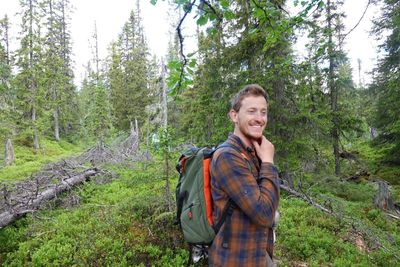
14:25
Transition
14:30
Abstract 131 - Grizzly bears change their behavior near recreation sites in a protected area
Elise Loggers, Montana State University StudentHall C
Elise Loggers, Andrea Litt, Mark Haroldson, Kerry Gunther, Frank T. van Manen
Outdoor recreation is growing, increasing the importance of understanding how animals
respond to low-intensity recreation (i.e., hiking). Bear Management Areas (BMA) in Yellowstone
National Park were established in 1982 as areas important to bears. In BMAs (~21% of the
park), human access is restricted for 2–7 months every year, to protect bears and people,
providing an opportunity to test how low-intensity backcountry recreation influences behavior
of grizzly bears (Ursus arctos). Our objectives were to determine whether grizzly bears select
for, and if greater densities of bears exist in, BMAs. We also explored how bears change their
behavior near trails based on restrictions to human access and time of day. We used GPS
locations of 19 male and 16 female grizzly bears to develop step-selection models to test our
hypotheses. Males were 1.8 (95% CI = 1.3–2.4, summer) and 1.9 (1.1–3.1, hyperphagic) times
more likely to be in a BMA but not while restrictions were in place. Females selected for BMAs,
regardless of human access, during the mating season (1.3 times, 1.0–1.8). Bear density
increased by 0.31 (0.1–0.8) individuals for every 10-km2 increase in area covered by BMAs.
Females moved faster near trails in unrestricted areas and slower in restricted areas during
night and crepuscular hours. Females avoided trails at night in restricted areas (3.1 times,
1.1–9.4). Males moved faster near trails during all times and selected for trails during night and
crepuscular hours. Although individual bears differed in their responses, bears changed their
movement and selection in response to low-intensity recreation, even within a protected area.
Restricting recreation likely reduces human-bear conflict in areas with greater densities of bears
and reduces displacement of bears from important food resources. Restriction of trail use
during certain times (i.e., night) would likely further reduce human-bear interactions.

Abstract 58 - Males disperse, females remain: revealing the dispersal patterns of Asian black bears through genetic analysis
Naoki Ohnishi, Forestry and Forest Products Research InstituteSalon 4
Naoki Ohnishi, Kahoko Tochigi, Tomoko Naganuma, Shinsuke Koike, Koji Yamazaki,
Takeshi Osawa
It is commonly believed that about 95% of mammal species exhibit male-biased dispersal and
females' philopatry, but few species have been studied to confirm this difference in dispersal
systems, especially in large species where it is difficult to track their movements or obtain
sufficient sample sizes. This presentation introduces our genetic studies that used genetic
methods to elucidate the dispersal patterns and seasonal movements of Asian black bears
(Ursus thibetanus).
We estimated parentage using DNA from 550 captured individuals and found that there was a
3.6-fold difference in mean dispersal distance between males and females. Also, 96% of males
dispersed from their natal area, while half of females remained in their mother's home range.
Furthermore, we found that the timing of male dispersal was at 3 years of age.
The female's site fidelity results in a geographic cluster of matrilines, which disappears
temporarily during autumn when there is a shortage of acorns but re-establishes the same
structure the following spring.
As Asian black bears breed during the summer, any temporary autumnal movements are not
expected to affect the genetic structure of the next generation. Female site fidelity is also
suggested by landscape genetic analysis. Not only anthropogenic environments such as
farmland and residential areas, but also natural open areas such as wetlands and bare land,
impede female movement and create a "landscape of fear" for female bears.

14:45
COFFEE BREAK
Edmonton Convention Centre
15:10
Abstract 166 - Fine-Scale Behavioral Patterns of Newly Recolonizing American Black Bears in Texas
Nicole Dickan, Borderlands Research Institute StudentHall C
Nicole Dickan, Justin T. French, Dana L.Karelus, Matthew O. Hewitt, Amanda M.
Veals Dutt, Louis A.Harveson
American black bears (Ursus americanus) began recolonizing western Texas, U.S.A. in the 1980s
after being extirpated from the state. However, recolonization has been slow in this sky island-
desert ecosystem and black bears remain a threatened species in Texas today. Despite their
protected status, little is known about this population and information on their behavioral
patterns is severely lacking. Therefore, we collared 22 bears with GPS collars programmed with
2-hour fix rates. Using hidden Markov models, we segmented the movement paths of 17 bears
(11 M, 6 F) into 4 behavioral states based on probability distributions of step lengths (SL),
turning angles, residence times (RS), and revisitation rates (RV). We found evidence of four
states, consistent with resting, foraging, and dispersive movements, as well as a distinctive
behavior when using point attractants (e.g. deer feeders). The resting and attractant states
both represented localized movement behaviors (x̄SL = 8.2 ± 0.1(SE), 151.4 ± 5.0) but the
attractant state was distinguishable by disproportionally high revisitation rates and residence
times (x̄RT = 41.1 ± 0.6, x̄RV = 6.6 ± 0.1). There were daily and seasonal patterns in the
proportions of fixes in each state. Traveling was most prevalent during early morning, evening,
and in summer. The attractant state was most prevalent in fall during hyperphagia. We then
examined the influence of environmental covariates on the transition probabilities between
states to investigate which abiotic and biotic factors influenced where bears made specific
behavioral decisions. Understanding drivers of bear behaviors can improve our ability to predict
future behaviors in novel environments as they continue recolonization and allow us to predict
future conflict areas. Additionally, understanding habitat characteristics associated with these
behavioral processes will be crucial for identifying key areas in need of protection for long-term
population viability.
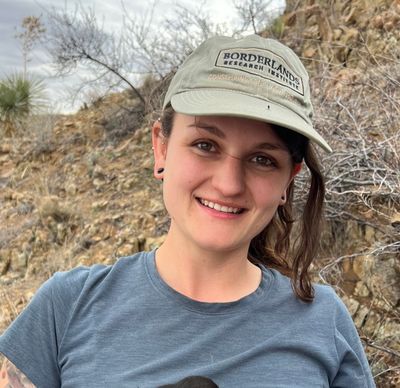
Abstract 61 - Modeling prey & predator: Using army cutworm moth seasonal occurrence to inform grizzly bear foraging
Erik Peterson, Washington State University StudentSalon 4
Erik Peterson, John S. Waller, Don White Jr., James R. Pierce, Daniel H. Thornton
Migratory army cutworm moths (Euxoa auxiliaris; ACM) are one of the most calorie-rich food
resources for grizzly bears (Ursus arctos horribilis) in the Rocky Mountains. Due to the
inaccessible nature of the alpine talus slopes where ACMs reside in summer, the magnitude of
the grizzly bear-ACM relationship is unclear. We undertook a two-part study to better
understand the seasonal significance of this fat and protein-packed food resource for grizzly
bears within 4000 km2 Glacier National Park, Montana, USA. We first conducted ground
surveys of potential ACM habitat to develop presence-absence models of ACM occurrence. We
found that, in particular, geological characteristics (namely dominant geological formation,
surficial talus rock size and talus depth) influenced ACM occurrence. Our model predicted ACM
occurrence across a total area of 12 km2, just 0.3% of the park. Second, we conducted aerial
surveys to map grizzly bear use within potential ACM habitat and develop presence models of
grizzly bear foraging suitability. Using predicted ACM occurrence as a single variable bear
foraging model, we found ACM occurrence drove predicted patterns of grizzly bear foraging.
Spatially, our models showed the overlap of ACM occurrence and grizzly bear foraging for ACMs
was 69%. And temporally, grizzly bear moth consumption aligns with their crucial period of
overeating to sustain winter hibernation. A grizzly has the capacity to consume ~20,000 kcal in
ACMs per day, so individuals could potentially acquire ≥ 50% of their seasonal energy needs by
foraging for moths. Given the significance of this predator-prey relationship and increasing off-
trail human recreation, we recommend Glacier National Park implement site-level access
management strategies at ACM occupied talus slopes to limit grizzly bear disturbance and
minimize impacts to the energy budgets of individual bears utilizing this seasonal, concentrated
food resource.

15:25
Transition
15:30
Abstract 210 - Movement and survival of polar bears in relation to sea ice and harvest in Hudson Bay.
David McGeachy, University of Alberta StudentHall C
David McGeachy, Nicholas J. Lunn, Joseph M. Northrup, Vicki Trim, Evan S.
Richardson, Alyssa M. Bohart, Amélie Roberto-Charron, Guillaume Szor, Corey S. Davis, Andrew
E. Derocher
We estimated movement and survival rates between two neighbouring subpopulations of polar
bears, Western Hudson Bay (WH) and Southern Hudson Bay (SH), in relation to sea ice and
harvest using multistate live/dead recovery models to determine if recent changes in
abundance between WH and SH were due to distributional shifts or different demographic
processes. We collected skin samples from 2667 free-ranging polar bears (WH, 2017-2023,
n=1748; SH, 2021-2023, n=919) and 360 harvested 2017-2023 (WH, n=182; SH, n=178). Our
models included 3 separate geographical states where bears were sampled (A1, Nunavut
border to the Nelson River; A2, Nelson River to the SH/WH boundary; and A3, SH/WH boundary
to James Bay) and the location (western or eastern half of Hudson Bay) of remnant ice when
sea ice extent reached 10% of the winter maximum. Harvest data was used to assess harvest
vulnerability for each state. We found high interannual variability in the spatial distribution of
remnant ice within Hudson Bay which influenced polar bear distribution. In 2021, remnant ice
occurred in the east and 25% of the bears sampled in SH were identified as WH bears. In 2022,
remnant ice occurred in the west and 28% of the bears sampled in SH in 2021 were resampled
in WH. Movement continued from A3 into A2 in 2023 with movements rates higher for adult
males (0.28, 95%CI 0.18 to 0.39) than adult females (0.23, 95% CI 0.13 to 0.37). Movement
rates between the two subpopulations were similar to the increase in SH and decrease in WH
abundance derived from aerial surveys in 2021. Harvest vulnerability was not equal among the
states with A2 having a lower rate of harvest resulting in higher survival rates for bears in this
area. We conclude that the movement of bears between A2 and A3 is influenced by patterns of
remnant ice resulting in distributional shifts that likely influenced abundance estimates and
that variation in harvest vulnerability impacts survival for polar bears in Hudson Bay.

Abstract 289 - Using anomaly detection with radio-collar activity data to determine the presence and timing of grizzly bear parturition
Lori Roberts, Montana Fish, Wildlife & ParksSalon 4
Lori Roberts, Cecily M. Costello, Milan A. Vinks, Daniel D. Bjornlie, Matthew D.
Cameron, Justin G. Clapp, Mark A. Haroldson, Grant V. Hilderbrand, Kyle Joly, Wayne Kasworm,
Jeremy Nicholson, Tom Radandt, Mathew S. Sorum, Justin Tiesberg, Frank T. van Manen
Documenting natality of radio collared grizzly bears (Ursus arctos) is a key component of many
population monitoring programs. Because grizzly bears give birth during hibernation,
observation of litters is not possible until den exit and detection of cubs can be compromised
by low sightability. Using activity data from dual-axis motion sensors, previous researchers
developed methods to confirm parturition based on characteristic changes in activity between
pregnancy and postpartum periods. Unable to replicate their results with data from 3-axis
accelerometers, we developed an alternative technique to detect births by the presence of
spikes in activity likely triggered by prolonged postpartum licking by mothers. Using a test
sample of daily activity counts during 25 Dec–7 Mar (n = 22 known parturient females), we
applied the R routine anomolize and developed presence criteria. To test performance, we
applied the technique to a blind sample of time-series obtained from females in 4 populations
in interior North America (n = 296). We assigned predicted status and compared assignments
to observed status at first visual observation. The true positive rate was 94% (n = 47 observed
parturient females). The false positive rate was 14% (n = 65 females observed with older
offspring). Births were predicted for 47% of females that were never observed (n = 49), 21% of
females observed without offspring (n = 114), and 10% of females considered too young to
reproduce (n = 21). Dates of predicted births varied from 27 Dec to 28 Feb. Our anomaly
detection technique was successful at estimating parturition events, and despite some error,
indicated that a number of litters were born but not observed, likely because of mortality in the
den or shortly after den exit. This technique may provide an additional tool for supplementing
visual observations for natality monitoring and population modeling, provided that potential
biases stemming from increased detection rates are considered.

15:45
Transition
15:50
Abstract 309 - Sea ice dynamics influence movement patterns of adult female polar bears of the Southern Hudson Bay subpopulation
Martyn Obbard, Ontario Ministry of Natural Resources and Forestry RetiredHall C
Martyn Obbard and Kevin R. Middel
To access seals, polar bears (Ursus maritimus) move large distances over the sea ice in winter.
Already documented declines in ice duration for Hudson Bay are predicted to continue, likely
affecting polar bear movement patterns. Using data from GPS collars, 2007-2011, we describe
movement patterns of adult female polar bears of the Southern Hudson Bay (SH)
subpopulation. We tested effects of season and reproductive class on movement rates,
distance travelled, displacement distance and direction, and home range size. Except for
denning females, reproductive class had no effect on movement rates, which were greatest
during freeze-up and least during summer. Across all reproductive classes and seasons, mean
hourly movement rate was 0.63 km/h. Mean annual distance moved by non-denning females
was 4771 km. During freeze-up, bears moved north-easterly from the Ontario coast towards
the Belcher Islands and Québec following the forming ice edge. During breakup, bears moved
southerly towards the Ontario coast and away from the residual ice that occurs north of the
Ontario coast. In fall, denning females moved southerly and inland to den. Mean annual
minimum convex polygon (MCP) home range size was 153, 866 km2, with no effect of
reproductive class nor change over time. Home range estimates from kernel density estimators
and Brownian bridge movement models (BBMM) varied by reproductive class and were smaller
than MCP ones. BBMM estimates likely yield more realistic patterns of space use by polar
bears. Using data from satellite collars, 1997-2003, we compared travel distance and home
range size between periods (1997-2003; 2007-2011). We found weak evidence of a difference
in distance moved between periods, perhaps due to a period of ice stability in the 2000s. Our
results identified patterns of use of extensive areas of Hudson Bay by SH bears in winter..

Abstract 290 - Mitigation and compensation of brown bear predation on semi-domestic reindeer in Scandinavia
Ole Gunnar Støen, Norwegian Institute for Nature Research & Norwegian University of Life SciencesSalon 4
Ole Gunnar Støen, Peter Andersson, Peter Segerström, Jonas Kindberg
The brown bear population in Scandinavia has tripled over the last three decades. However,
due to hunting, bears remain classified as near-threatened (NT) in Sweden and endangered
(EN) in Norway. Sámi reindeer husbandry is essential to Sámi culture in Scandinavia, and
compensation is provided for reindeer losses. Due to the increased bear population, the extent
of this compensation is disputed, prompting both countries to revise the compensation system.
Amidst the ongoing controversy, there is a lack of data on bear predation on reindeer.
With funding from the governments of both countries and the Sámi Parliament in Sweden, we
initiated a unique collaborative research project with three Sámi reindeer herding communities
in Sweden to quantify the annual brown bear kill rate on reindeer.
We monitored > 60 GPS-collared bears and > 2500 adult female reindeer over a span of 9 years.
Using proximity collars and a ‘virtual fence,’ the GPS collars tracked the bear's position every 1
or 5 minutes as they traversed reindeer calving grounds. Field teams, consisting of a bear
scientist and a Sámi reindeer herder, systematically visited all locations where bears spent more
than 3 or 10 minutes. This allowed the teams to identify freshly killed reindeer carcasses,
enabling a precise assessment of kill rates for both calves and adult reindeer.
Brown bears primarily targeted reindeer calves, especially during the peak of calving. The
estimated kill rate of 0.3-0.5 calves per day during calving in May to mid-June suggests that
brown bears might account for most of the annual calf losses in the reindeer herding districts.
Adult reindeer were infrequently preyed upon, with a rate one-tenth of that of calves. After
mid-July, when berries become abundant, bear predation on reindeer ceased.
Our result indicates effectiveness of localized mitigation strategies, such as increased hunting
quotas within confined calving grounds or selectively culling during calving.

16:05
Transition
16:10
Abstract 330 - How far is the female den
Slaven Reljic, Oikon Ltd., Faculty of Veterinary Medicine, University of Zagreb, CroatiaSalon 4
Slaven Reljic, Goran Guzvica, Lidija Sver, Gaja Hana Francky, Laura Schulte, Ratko
Popovic, Djuro Huber
If you see a bear family with newborn cubs, the typical question is: How far away is their den?
The answer is particularly important if new infrastructure (such as wind turbines) is planned in
the area. The Environmental impact assessment is expected to determine the minimum safe
construction exclusion zone. We know that bears tend to choose remote areas with no human
influence, which are usually difficult to access and/or at higher altitudes. It is of utmost
importance to preserve the brown bears’ denning areas. In Croatia, the construction of wind
farms in these areas has been rising in recent years.
In this study, we wanted to answer the question of how far a female bear, alone, with cubs of
the year (COYs) or yearlings, moves away from the den in the moment of the observation (with
an automatic camera or by a human). In this way, we can make the best possible estimate of
the minimum distance at which the wind turbine can be built. We collected the telemetry data
of 11 female brown bears tracked in Croatia in a period from 2010 to 2024. For each of the
females, we have verified data on their reproductive status. We analyzed the GPS data for four
standard seasons and compared the size (MCP 100%) of the females' seasonal ranges in terms
of the presence or absence of COYs or yearlings. We also measured the greatest distance from
the den to the edge of the range in certain seasons. The smallest home ranges and the smallest
distance from the den occurred in spring after females had emerged from the den with cubs of
the year, on average 6.5 km2 and 3.9 km, respectively. The seasonal range size of females with
COYs increased in summer (22 km2; 5.7 km) The largest range and the greatest distance from
the den was in the autumn (females with COYs making excursions; 349 km2 and 47 km,
respectively). Excursions occurred mostly in September or October, except for one female who
made it in the spring season. The length of the trips ranged from 10 to 38 km.

16:25
Transition
16:30
IBA Members' Meeting
Salon 4
Wednesday 18 Sep 2024
07:20
Field Trip - Elk Island National Park
Meet at Edmonton Convention Centre
Meet at Edmonton Convention Centre for trip to Elk Island National Park. Lunch included. Must be registered.
Thursday 19 Sep 2024
07:00
BREAKFAST
Edmonton Convention Centre, Assembly Foyer
08:00
Abstract 127 - Comparison in the ecology of two polar bear populations experiencing sea ice loss
Karyn Rode, US Geological SurveyHall C
Karyn Rode, Todd Atwood, Ryan Wilson, Jeff Bromaghin, Anthony Pagano, Dave
Douglas
Polar bears are recognized in 19 populations across the circumpolar Arctic. Across their range
they occupy habitats that vary in annual sea ice dynamics, ecology, and rates and degrees of
sea ice loss. Over the past decade, a wide range of studies have been conducted that shed light
on polar bear ecology and their limits to adapting to environmental change. The two adjacent
populations with ranges in Alaska have provided informative case studies. Both populations
occupy habitats in which sea ice is available year-round but retreats northward in the summer.
As sea ice loss has occurred, both populations have increasingly summered on land. In the
southern Beaufort Sea (SBS), bears come onshore in northern Alaska where most bears feed on
the remains of subsistence-harvested bowhead whales. In the Chukchi Sea (CS), the majority of
bears that summer on land come to Wrangel and Herald islands as sea ice retreats, the
northernmost land masses. In contrast to SBS bears, CS bears largely rest along the immediate
coastline. However, despite access to a consistent and predictable food resource on shore in
the SBS, the population declined in recent years whereas the CS population has appeared
stable. Studies of bear behavior and ecology on the sea ice suggest that SBS bears had a series
of years with poor access to prey over the narrow continental shelf leading to low cub survival
and subsequent population decline. In contrast, polar bears in the CS occupy habitat over a
vast, shallow continental shelf that appears to support higher densities, abundance, and wider
distribution of bearded and ringed seals. As summer and spring sea ice loss have occurred in
the CS, bears appear to have maintained access to their prey. This presentation will synthesize
multiple studies conducted in the two populations that suggest that differences in regional
ecology and geography play important roles in determining polar bear sensitivity to sea ice loss.

Habitat Relationships - Concurrent Session Chair Terry Larsen
Hall C
Abstract 40 - Vitek® analysis of sloth bear scats from wild and captive populations reveals differences in their gut microbiota and antibiotic resistance
Sakhi Dabhi, WCB Research lab, Hemchandracharya North Gujarat University StudentSalon 4
Sakhi Dabhi and Nishith Dharaiya
Sloth bear is considered as one of the largest myrmecophagous mammals. In addition to their
consumption of ants and termites, they also consume a large variety of plant food. The present
study compared the presence of selected bacterial species within the wild and captive sloth
bear populations, and investigated the incidence of antimicrobial resistance for both
populations. The antibiotic susceptibility test would be helpful for veterinary care protocols, but
will also indicate any presence of resistance in the wild population. The study was conducted
using a non-invasive method, by isolating microorganisms from fresh scat samples collected
from Jessore Wildlife Sanctuary of Gujarat (wild) and Bannerghatta Bear Rescue Centre and
Bannerghatta Zoo (captive). Standard microbiological techniques were used for isolation,
growing bacteria on differential media, followed by Gram staining. The Vitek 2 compact system
(bioMerieux®) was used to identify the isolated microorganisms and to determine their
antibiotic susceptibility. A total of 19 and 22 colonies were isolated from wild and captive sloth
bear scats respectively. Of these colonies, eight microorganisms from the wild and nine from
the captive sloth bear scats were identified. Further, two organisms were found in common for
both populations. Apart from the bacteria, one scat collected from the wild was found to
contain Candida albicans fungi. The antimicrobial susceptibility test revealed that ten out of 22
organisms from captive population are resistant to 38 different antibiotics, whereas, in case of
wild population, only two out of 19 organisms were found resistant to 34 different antibiotics.
It is therefore recommended that susceptibility should be tested before antibiotic treatment is
given. In addition, the significant daily use of Jessore Wildlife Sanctuary by livestock and local
villagers, our finding of little antibiotic resistance is reassuring, though further studies in this
area would be helpful.

Captive Bears, Zoos, & Physiology - Concurrent Session Chair Dong-Hyuk Jeong
Salon 4
08:15
Transition
08:20
Abstract 159 - Sea Ice Phenology and Polar Bear Habitat Selection at the Southern Extent of the Species’ Range
Tyler Ross, York University StudentHall C
Tyler Ross, Gregory W. Thiemann, Martyn E. Obbard, Kevin R. Middel, Joseph M.
Northrup
Accounting for differences in habitat use among individuals within sympatric populations is
important for identifying appropriate scales of management, particularly in the context of
climate change, which may differentially impact wildlife based on their spatial distribution. This
is especially relevant in the Arctic where temperatures are warming faster than the global
average. For sea-ice-dependent species such as polar bears (Ursus maritimus), understanding
regional differences in habitat use is essential for crafting adaptive conservation strategies that
reflect the different scales at which climate change may be affecting the species across its
range. Here, we examined long-term trends in sea ice phenology, and habitat selection of polar
bears in James Bay, the southern-most continuously occupied area of the species’ range.
Between 1979-2022, duration of the ice-free season increased at a rate of 2.9 days decade-1,
slower than the broader Southern Hudson Bay area, which experienced an increase of 4.7 days
decade-1 over the same period. Polar bears equipped with GPS-satellite collars between 2012-
2015 varied in the extent of their geographic home ranges, ranging from 23,596-263,679 km2.
The population-level home range encompassed 121,338 km2, and included areas extending
from the Belcher Islands to southern James Bay. Polar bears exhibited seasonal variation in
selection of finer-scale habitat characteristics within their home range. Bears routinely selected
areas with higher sea ice concentration, and appeared to prefer areas further from the coast
during the early winter, then switched to areas closer to shore during spring when prey
availability peaks. Documenting sea ice conditions and patterns of polar bear habitat selection
is important to establish baseline information against which future changes can be compared.
This is particularly important for polar bears at the southern extent of their range where near-
term changes are expected to be greatest.

Abstract 44 - Using photographs from remote cameras to estimate bear body condition
Garth Mowat, University of British ColumbiaSalon 4
Garth Mowat, Troy Malish, Laura Smit, Bruce McLellan
Body condition of individual large mammals is a highly labile parameter that is influenced by
the recent nutritional plane, the seasonal hormonal cycle, intrinsic traits such as age and
reproductive status, food availability and quality, and extrinsic stress factors such as predation
risk, social dominance or human disturbance. Body condition thus integrates many population
and individual level factors into a single measure of performance which makes it ideal for long-
term population monitoring. Long-term longitudinal studies are often the best way to learn
about how the vagaries of the environment affect population performance because they can
contrast short-term fitness with interesting covariates across time. In temperate environments
climate and weather interact to create good and bad periods for animals that are often
autocorrelated. Large mammals in temperate environments bet-hedge against future stress
periods by storing energy, usually as fat. We measured body condition of bears using remote
cameras and compared this data to live capture derived measures from the same study area.
We found that photograph derived measures of body condition were similar to weight per
length measures derived from bears in hand; both metrics were seasonally different from
measures of body fat. Photographs allow the comparison of body condition among individuals,
seasons, and populations through time, while also considering the variation within the sample.
The option to collect many samples should enable the examination of novel aspects of the
dynamics of population fitness of bears, and perhaps other species.
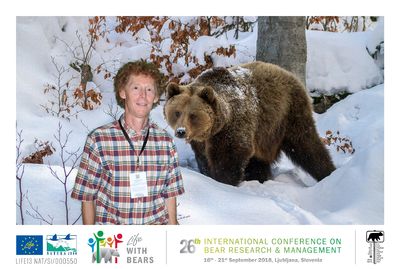
08:35
Transition
08:40
Abstract 186 - A life-cycle based bioenergetic model can explain the decline of a polar bear population across four decades of sea-ice loss
Louise Archer, University of TorontoHall C
Louise C Archer, Stephen N Atkinson, Nicholas J Lunn, Stephanie R Penk, Péter K
Molnár
The Arctic is the fastest warming region on Earth, threating the persistence of Artic species.
Polar bears are particularly vulnerable because warming leads to declines in their essential sea-
ice foraging habitat. Longer ice-free periods have been linked with declining metrics of
population health, but a data-validated framework quantifying the processes linking sea-ice
dynamics to polar bear vital rates is lacking, limiting our ability to quantify risk and proactively
manage populations. To determine the quantitative links between physiology, population
dynamics, and environmental change, we developed an individual-based bioenergetic model
that incorporates key energetic processes across a polar bear’s lifecycle. We used the model to
reconstruct the dynamics of polar bears in Western Hudson Bay across four decades under
observed sea-ice conditions. We then compared outputs from model hindcasts to long-term
population monitoring data (1979-2016) and found that the model was able to successfully
capture empirical trends in individual morphometrics, reproduction metrics, and overall
population size. The modelling framework demonstrates that an observed decline in a sentinel
population of polar bears can be mechanistically explained by the effects of sea-ice loss on
individual energy budgets, which scale up to influence population vital rates.

Abstract 72 - Successfully returning American black bear (Ursus americanus) cubs-of-the-year to the wild after being orphaned and raised in captivity
Paul Frame, Government of AlbertaSalon 4
Paul Frame
Prior to spring 2018, provincial policy in Alberta prohibited the captive rearing and release
(CRR) of orphan black bear (Ursus americanus) cubs (OBBC), a practice referred to as
rehabilitation. Even with black bear populations reported to be stable or increasing range-wide
in North America, Alberta responded to public pressure and officially allowed CRR of OBBCs by
developing the Alberta Orphan Black Bear Cub Rehabilitation Protocol. This protocol guides
details around the intake, care, and release of OBBCs in Alberta. The preferred strategy
described in the protocol is to release cubs-of-the-year (COY) in late October of their first year,
thus allowing them to den in the wild and emerge in spring as free-living bears. This strategy
has met resistance from the public, who raise concerns about the age of self-sufficiency in black
bears. In Alberta, all CRR OBBC released since 2018 (n= 18) have been monitored with GPS
tracking collars to evaluate over-winter survival. To date, 12 COY have been released in late
October (average 157 days in captivity, range 93-204 days), and all 12 successfully denned and
emerged in spring. Cubs denned an average of 7 days (range 3-19 days) after release. The
denning period of CRR cubs averaged 166 days (range 154-184 days), similar to that reported
for all age and reproductive classes in Maine (Range 134-197). Although our sample is small and
the cubs were artificially fed and in abnormally good body condition, all 12 COY released in late
October successfully overwintering without their mother provides some insight to the age of
self-sufficiency in black bears. These results also support the Alberta strategy to release COYs in
late October and may be relevant to other jurisdictions facing similar pressures.

08:55
Transition
09:00
Abstract 215 - Camera trapping in southeast Peru shows no obvious evidence of seasonal habitat use by Andean bears
Russell Van Horn, San Diego Zoo Wildlife AllianceHall C
Russell Van Horn, Denisse Mateo Chero, Fernando Hancco Pacha, Flynn B
Vickowski, Ronald R Swaisgood, Mathias W Tobler, Megan A Owen
It is not well known what determines the Andean bear’s current habitat use. Thus, we cannot
predict its future habitat use, because Andean forest composition is shifting under climate
change. In addition, although seasonal habitat use has been predicted for Andean bears, there
have been few data to test this prediction. To begin addressing these questions, we installed
camera traps at 102 locations within the Manu Biosphere Reserve of SE Peru, descending from
treeline (~3750masl) to the Amazon rainforest (532masl). From 2016–2022, across 84,266
camera-days (c-d), we recorded 597 independent detections of 25 adult bears. Although 21%
of sampling effort (18,223 c-d) was below 1500 masl, <1% of bear detections (n=4) were
recorded at that elevation. To begin evaluating seasonal shifts in habitat use, we split data into
the dry season (May–Oct; 42,115 c-d) and the wet season (Nov–Apr; 42,151 c-d). We recorded
249 independent detections of bears in the dry season (0.59 detections/100 c-d), at an average
elevation of 2992 masl (839-3586, SD=664.7). We also recorded 348 independent detections of
bears in the wet season (0.83 detections/100 c-d), at an average elevation of 3031 masl (811-
3586, SD=628.5). Neither the rate of detections (p=0.49), nor their elevations (p=0.46), varied
between seasons. Thus, unless future individual-based analyses show the contrary, we see no
seasonal changes in elevation by bears in this landscape. The entire forested gradient above
1500masl appears to be year-round bear habitat, possibly due to the high diversity and
heterogeneity of these forests. In contrast, although lowland Amazonian forests are more
biodiverse, they appear unsuitable for bears, possibly due to the presence of jaguars, or due to
an unknown combination of abiotic factors. Without knowing what factors restrict these bears,
we cannot predict how their distribution will change, or suggest interventions. Future
collaborative large-scale analyses may guide mitigation plans.

Abstract 96 - Species-specific validation of commercial immunoassays for accurate hormone quantification in polar bear serum
Erin Curry, Cincinnati Zoo & Botanical GardenSalon 4
Erin Curry, Emily Virgin, Adrianna Tompros, Jessye Wojtusik
Although steroid and thyroid hormones are frequently studied in polar bears, there is growing
interest in evaluating less commonly investigated protein hormones and their roles in
reproduction, health, and metabolism. Due to limited availability of antibodies specific to polar
bear analytes, commercial assays designed to quantify hormones in domestic species may be
considered; however, it is crucial to validate these assays using polar bear samples to ensure
cross-species accuracy and reliability. Utilizing sera (n=435) collected from zoo polar bears
(n=91) of both sexes, a range of ages (0-31y), and across seasons, antibodies (n=80) from
commercial single-plex and multiplex enzyme-linked immunoassays targeted to canine (n=25),
feline (n=15), human (n=22), mouse (n=13), or rat (n=5) analytes were evaluated. Validation
steps included parallelism of serially diluted pooled samples to the assay standard curve,
dilution linearity, and recovery of spiked analyte. Of the 80 antibodies analyzed, only 27 (34%)
met validation criteria in polar bear serum; these included hormones involved in reproduction
(AMH, FSH, LH, oxytocin, prolactin), immunity/inflammation (IFN gamma, IL-2, IL-10, IP-10) and
metabolism (growth hormone, leptin, ghrelin), among others. Assays targeting canine analytes
resulted in 80% successful validation, followed by mouse (31%), rat (20%), human (9%), and
feline (0%). Preliminary data from individual samples revealed expected differences in hormone
trends between sexes, by age, and across seasons, indicating biological validation. Additionally,
several inflammatory markers were higher in individuals with known pathology compared to
healthy individuals, suggesting they may serve as biomarkers of health. These findings
underscore the critical importance of performing species-specific assay validations and have
resulted in a suite of tools that may be incorporated into polar bear monitoring surveys, both ex
situ and in situ.

09:15
Transition
09:20
Abstract 336 - Assessing Dietary Importance of Army Cutworm Moths to Grizzly Bears in the Greater Yellowstone Ecosystem
Jennifer Fortin-Noreus, US Fish and Wildlife ServiceHall C
Jennifer Fortin-Noreus, Dan Tyers, Andy Pils, Justin E. Teisberg, Joy Erlenbach,
Hilary Cooley
Grizzly bears in the Greater Yellowstone Ecosystem (GYE) are opportunistic omnivores that
move seasonally within their home ranges depending on food abundance. While grizzly bears
supplement their diet with lower-caloric foods that tend to be widely distributed and readily
available (vegetation, insects, fungi, berries, small mammals), the availability and distribution of
high-caloric foods in the GYE (e.g., ungulates, army cutworm moths, whitebark pine seeds) has
the potential to influence seasonal movements of grizzly bears. Previous studies have
investigated grizzly bear use of whitebark pine seeds and ungulates, yet little is known about
grizzly bear use and availability of army cutworm moths. Some grizzly bears whose home
ranges overlap with army cutworm moth aggregation sites appear to forage extensively on
moths during mid-to-late summer when the moths aggregate on remote, high-elevation talus
slopes, but many questions remain regarding the importance of this food source to the GYE
grizzly bear population. The Interagency Grizzly Bear Study Team annually monitors trends in
grizzly bear presence at confirmed moth sites through aerial observations, providing an indirect
measure of the importance of moths in a given year. Using stable isotope analysis (δ15N, δ13C,
δ2H), we present a method to instead directly estimate the proportion of assimilated diet
composed of army cutworm moths. Likely because of their migratory life history, the hydrogen
isotopic ratio (δ2H) of army cutworm moths at confirmed aggregation sites is unique when
compared to other food items in the GYE. Additionally, hair samples were collected and
analyzed from 1) bears at or near confirmed moth sites and 2) collared bears with no GPS
locations at confirmed moth sites. Moths, other dietary items, and hair samples will be
collected from additional peaks during 2020 for expanded analysis.

Abstract 107 - Ending Bear Bile Farming in Vietnam by 2026 as a conservation measure to protect Asiatic black bears
Tuan Bendixsen and Jill Robinson, Animals Asia FoundationSalon 4
Tuan Bendixsen, Heidi Quine, Jill Robinson
Bear farming in Vietnam, fueled by the demand for bear bile for use in traditional medicine, has
threatened bear conservation and raised significant concerns for the welfare of farmed bears.
To end bear farming, strategies that address law enforcement, demand for bile, and provide
lifelong care for rescued bears in sanctuaries are needed. This presentation describes Animals
Asia’s holistic approach in partnering with the Vietnamese government to close down bear
farms and eliminate bear bile demand through public education and the promotion of herbal
alternatives. Collaborative actions with the government in law enforcement and rescuing bears
from bile farms have resulted in a gradual reduction of farmed bear numbers from 4349 in
2006, to 3000 in 2010, to 1284 in 2014, to 916 in 2000, and to less than 250 in 2024. Education
regarding the cruelty of bear farming, the illegality of bile extraction and trading, and the
community’s uptake of herbal alternatives to bear bile has caused a collapse of the bear bile
market, where the price of one milliliter of bile dropped from $20 US in 2007 to less than $5 US
in 2024. The partnership with the Vietnam Traditional Medicine Association has produced a
herbal balm composed of extracts of herbal plants that are used in traditional medicine to
replace bear bile. Public attitude surveys of this herbal balm in the most concentrated bear
farming communities in Hanoi showed that 80% of the community was satisfied with the herbal
alternative to bear bile, and 92% indicated that they would use the herbal balm again. Providing
consumers of bear bile with a valid alternative is a long-term solution to end bear bile demand
and eradicate the suffering and abuse of bears on farms. In summary, a combination of
perseverance and sustained holistic approaches by Animals Asia has resulted in the government
enacting a Directive that bear bile farming in Vietnam will end by the end of 2026.

09:35
Transition
09:40
Abstract 233 - Fundamental versus Realized Niche of Grizzly Bear Denning Habitat Across Canadian National Parks; Implications of Anthropogenic Disturbance
Ramona Maraj, Parks CanadaHall C
Ramona Maraj, Nolan Waters, Emily Gavey, Peter Demontigny, Erin Henderson,
Rachel Stapleton
Expansion of and increase in human modification between 1990 and 2015 resulted in
1.6 million km2 of natural land lost globally. We examined the implications of this on grizzly
bear denning habitat in seven Canadian national parks. We used 417 den locations across seven
western Canadian national parks, ranging through British Columbia, Alberta, the Northwest
Territories and Yukon. Den locations were obtained from aerial sightings, staff or public
sightings, and collared bears. We used MaxEnt to model the influence of 21 covariates on third
order den site selection across the extent of the study area. To model the fundamental niche
for den selection, we considered a model without any anthropogenic influence. We
subsequently considered a realized niche den model that incorporated distance to linear
features and global human modification as explanatory variables. Our fundamental niche model
showed that across grizzly bear range, the visibility of the sky and solar radiation were
important factors that drive den selection. Our models also showed that denning habitat
availability decreases with latitude, until the Arctic coast, where availability becomes
widespread again. Our realized niche model showed that anthropogenic influences were the
most important factor influencing den site selection, with global human modification
contributing almost 50% explanatory power to the model and creating a disproportional loss of
denning habitat across all parks. At current rates of human modifications, availability of denning
habitat may become limiting for bears, even in protected areas.

Abstract 293 - Insight on the inside: histomorphological study of brown bear adrenal glands
Agnieszka Sergiel, Institute of Nature Conservation of Polish Academy of SciencesSalon 4
Agnieszka Sergiel, Abbey E. Wilson, Ewa Serwa, Joanna Macur, Łukasz
Paśko, Bartosz Leszczyński, Andrzej Wróbel, Jerzy Wiater, Jumpei Tomiyasu, Heather
Bacon, Robert Maślak, Slaven Reljić, Djuro Huber
Brown bear physiology is closely tied to seasonal changes. Hypothalamic-pituitary-
adrenal (HPA) axis plays an important role in regulating physiologically distinct states
related to those, and adrenal glands are the effectors. They produce and secrete
glucocorticoid hormones (e.g., cortisol and corticosterone), which play a key role in
regulating vital physiological processes. Morphologically the adrenal glands exhibit a
high degree of variation, with significant asymmetry observed between the right and left
glands within species and interspecifically. Adrenal gland variation is also related to the
zonation of the cortex. Parameters related to its shape and size have been used as a
principal criterion for differentiating a normal gland from adrenal hyperplasia. Our
objectives were to describe histomorphology of brown bear adrenal glands, establish
reference measurements to estimate adrenal size, and to assess the effects of season,
body mass, structural body size, age, and sex of individuals on adrenal parameters. We
used 325 formalin-preserved adrenal glands collected from 173 individuals of the
Dinaric-Pindos brown bear population. The mass, length, width, thickness, and volume
of glands were measured and allometric scaling was examined. Adrenal length, width
and thickness showed negative allometry with total body length (univariate allometric
coefficients: 0.76, 0.63 and 0.8 for the right gland, and 0.64, 0.74 and 0.73 for the left
gland, respectively). On average, the mass of adrenal glands was 0.006% of the
individual body mass. Additionally, we conducted histological analysis of 21 freshly
collected adrenals of 16 individuals. Eight pairs of adrenal glands were also micro-CT-
scanned, resulting in visualizations of size, shape and surface, virtual cross-sections,
and volumetric analysis. Our study presents the first database of normal physiological,
anatomical, and histological values of adrenal glands for this species for use in health
assessments.
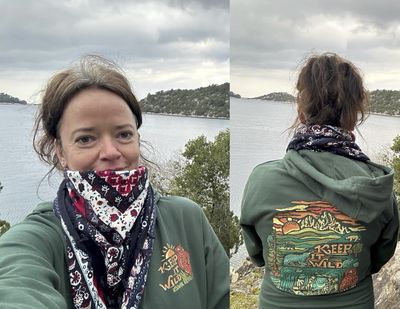
09:55
COFFEE BREAK
Edmonton Convention Centre
10:20
Abstract 249 - Forestry practices influence black bear and grizzly bear occurrence and co-occurrence with prey species in harvest blocks
Tracy McKay, Parks CanadaHall C
Tracy McKay and Laura Finnegan
Forest harvesting is a primary agent of change across the boreal forest of Canada, altering black
bear and grizzly bear habitat. Silviculture practices applied after forest harvesting directly
impact forage availability for bears, but there is limited research on how specific silviculture
treatments (preparation, planting, tending) influence bear use of harvest blocks and co-
occurrence with other species. We used camera detections, silviculture data, landscape
characteristics, and vegetation data from 117 harvest blocks sampled in Alberta, Canada during
2018-2020 to assess the influence of silviculture practices, block characteristics, surrounding
habitat, and forage abundance on black bear and grizzly bear occurrence and co-occurrence
with prey species. We found black bear occurrence was higher in blocks that had been planted,
and grizzly bear occurrence was higher in blocks that had been stand tended and with higher
tree-planting densities. Black bear occurrence was higher in smaller blocks, and grizzly bear
occurrence was higher in blocks where the surrounding area had lower densities of linear
disturbances and harvest blocks. Black bear occurrence was higher in blocks with greater
availability of fireweed, and both black and grizzly bear occurrence was higher in blocks with
greater availability of rose. Co-occurrence analysis indicated that black bear occurrence was
higher in blocks where white-tailed deer were detected, and grizzly bear occurrence was higher
where mule deer were detected. Our study indicates that bear use of harvest blocks is driven by
fine-scale block characteristics and silviculture practices as well as the habitat surrounding the
block, and harvest blocks may directly influence predator-prey dynamics. The results of our
study may be used to inform sustainable forest management that considers the impacts of
forest harvesting practices on black bears, grizzly bears, and their prey species.

Abstract 126 - Validation of a hair-hormone tool kit for long-term monitoring of grizzly bears
Abbey Wilson, Government of Northwest TerritoriesSalon 4
Abbey Wilson, Sarah A. Michaud, Jun Han, Gordon Stenhouse, Kristenn
Magnusson, Karen Graham, Darío Fernández-Bellon
Population surveys using non-invasive grid-based DNA hair-snag sampling are a common tool
for managers to determine density, distribution, and sex ratios of bear populations. Measuring
hormones in hair samples may complement this approach by providing biomarkers indicative of
physiological state that cannot be addressed by genetic methods alone. This study aimed to
determine if an established targeted hormone profile measured in hair samples collected from
live captured grizzly bears (Ursus arctos) in Alberta, Canada can assist in population monitoring
and support management decisions. We hypothesized that the concentration of hormones can
be used to determine demographic parameters for grizzly bear populations, including age-class
ratios and rates of pregnancy and lactation. Approximately 25mg of hair (equivalent to about
80 guard hairs) was washed with methanol, homogenized, and extracted for liquid
chromatography-mass spectrometry analyses. We detected and quantified 15 hormones with
high precision and accuracy that were classified by biosynthesis pathway: progestogens,
mineralocorticoids, glucocorticoids, androgens, estrogens, and thyroid hormones. We
compared individual hormone concentrations and individual hormone ratios to identify
biomarkers of demographic parameters. We further calculated biosynthesis pathway group
means and group ratios to create a metric that represented the entire profile. Preliminary
analysis revealed that multiple hormones, hormone ratios and group ratios may be indicators of
age class. These results aligned with previous research completed on captive bears, where
reproductive and stress hormones were identified as predictors of age class. Androgens and
mineralocorticoids were found to be related to pregnancy and lactation, respectively. By
applying this metabolomic approach to hair samples collected from captured grizzly bears, we
demonstrate the potential use of this method in non-invasive monitoring of grizzly bear
populations.
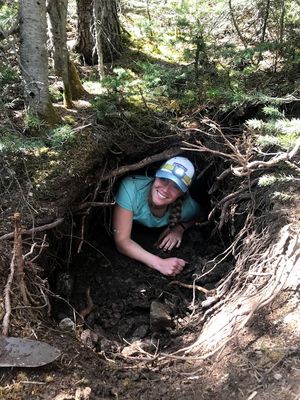
10:35
Transition
10:40
Abstract 344 - Space use of brown bears across Europe’s human dominated landscape: Insights from a multi-population study
Anne Hertel, Ludwigs-Maximilians University MunichHall C
Anne G. Hertel, Aida Parres, Shane C. Frank, Julien Renaud, Nuria Selva, Andreas
Zedrosser, Niko Balkenhol, Luigi Maiorano, Ancuta Fedorca, Trishna Dutta, Neda
Bogdanović, Silviu Chiriac, Duško Ćirović, Paolo Ciucci, Csaba Domokos, Mihai Fedorca, Stefano
Filacorda, Claudio Groff, Miguel de Gabriel Hernando, Djuro Huber, Georgeta Ionescu, Klemen
Jerina, Alexandros A. Karamanlidis, Jonas Kindberg, Ilpo Kojola, Yorgos Mertzanis, Santiago
Palazon, Mihai I. Pop, Maria Psaralexi, Pierre Yves Quenette, Agnieszka Sergiel, Michaela
Skuban, Diana Zlatanova, Tomasz Zwijacz-Kozica, Marta De Barba
Species often occupy wide-geographical ranges with contrasting environmental conditions that
shape intraspecific variation in space use. Three-quarters of the planet's land surface have been
altered by humans with consequences for animal movement and related ecosystem
functioning. Yet, limited data availability across species' ranges has constrained our
understanding of intraspecific movement variation in highly anthropized landscapes. Leveraging
a unique dataset of 751 brown bear (Ursus arctos) GPS-movement trajectories that included
almost the entire geographical range of this species in Europe, we investigated intraspecific
variation in space use along a gradient of human impact and resource availability. We
quantified individual space use at different temporal scales, from home range sizes to 10-day
and 1-day displacement distances. We found large intraspecific variation in space use across all
temporal scales, with males roaming farther than females. This variation was profoundly
affected by human activity (i.e., human footprint index) and resource availability (i.e., annual
vegetation productivity and forest disturbances). Bears occupied smaller home ranges and
moved less in more anthropized landscapes and in areas of higher resource availability. Bear
home ranges overlapped little with protected areas, e.g., only 8 bears had their entire home
ranges within protected areas, demonstrating that protected areas in Europe are too small to
sustain brown bear populations. On a population level, bears from the Carpathian, Dinaric
Pindos, and Eastern Balkan moved most, followed by bears from Fennoscandia, while bears
from the Alpine and Apennine moved most. Restricted bear movements in areas of high human
footprint hinders connectivity among some populations in south-central Europe which are close
in proximity. In areas of high human footprint, such as the Italian Alps or Serbia, establishing
and maintaining movement corridors is essential to promote connectivity.

Abstract 147 - Forest skill patterns of rehabilitant sun bears (Helarctos malayanus) at the Bornean Sun Bear Conservation Centre, Sabah, Malaysia
Laura Sanders, University of Portsmouth StudentSalon 4
Laura Saunders, Elvia Chong Qi Ern, Leanne Proops, Ana Gheorghiu, Augustine
Tuuga, Siew Te Wong, Marina Davila-Ross
Rehabilitant bears undergo behavioural and ecological rehabilitation to help them acquire the
skills necessary to adapt to the forest and survive independently. An important set of skills for
sun bears to attain is the ability to climb trees, build nests or burrows, and forage for natural
resources. Although these skills may improve with time and experience, through increasing
exposure to a forest environment, additional factors, including orientation to humans and
personality traits, have shown to hinder rehabilitant individuals' improvement in such skills. To
identify exact patterns of rehabilitant bear’s forest skills, it is important to have a method which
can capture these behavioural aspects and be readily available to rehabilitation centres. Rating
instruments can be deployed quickly, easily, and thus may also be optimal to identify
improvement in skills over time. In this study, we adapted (Rocque et al. 2022; Saunders et al.
in prep) a questionnaire to capture sun bear forest skills (climbing, nest building and foraging)
but also personality and human oriented behaviours. Part one of the study aimed to examine
the reliability and validity of the questionnaire, which was tested through inter-rater reliability,
test retest and correlations between questionnaire and observational scores. So far, the
questionnaire has demonstrated predominant reliability and validity. The second part of the
study aimed to analyse the scores from the questionnaire to understand how sun bear forest
skills may improve. To observe this and account for additional factors, we modelled forest skills
with sun bear age, years undergoing rehabilitation, and rehabilitation stages. Follow up models
also considered personality and human orientation scores. Gathering this information and
identifying trends in rehabilitant sun bear forest skills could help to inform future release
decisions, through identifying capable independent individuals and appropriate timings for their
release.

10:55
Transition
11:00
Abstract 176 - A Unified Approach to Long-Term Population Monitoring of Grizzly Bears in the Greater Yellowstone Ecosystem
Matthew Gould, U.S. Geological Survey - Interagency Grizzly Bear Study TeamHall C
Matthew Gould, Justin G. Clapp, Mark A. Haroldson, Cecily M. Costello, J. Joshua
Nowak, Hans W. Martin, Michael R. Ebinger, Daniel D. Bjornlie, Daniel J. Thompson, Justin A.
Dellinger, Matthew A. Mumma, Paul M. Lukacs, Frank T. van Manen
A challenge for long-term wildlife research and monitoring programs is maintaining a cohesive
monitoring system. Interruptions or changes in data collections can reduce compatibility of
data sets. Integrated population models (IPMs) can address these limitations by combining data
sources that may be temporally disjointed into a unified statistical framework while providing a
holistic view of population dynamics. We developed an IPM in a Bayesian framework for grizzly
bears (Ursus arctos) in the Greater Yellowstone Ecosystem. We coupled demographic data with
multiple, independent, and temporally disjoint population count data to link annual changes in
population size with vital rates over 4 decades (1983–2022). Parameter estimates indicated
survival of bears ≥2 years of age was high, contributing to robust population growth during the
1980s and 1990s (λ = 1.030–1.058). A slowing of population growth started around 2000
(2000s: λ = 1.023) and continued into the 2010s (λ = 1.009), due primarily to reductions in
survival of bears <2 years of age. These findings corroborate previous research that identified
density-dependent effects as a likely cause. The IPM framework provided greater certainty and
understanding regarding the dynamic demographic characteristics of the grizzly bear
population and serves as a powerful monitoring tool for this long-lived species. Through
implementation of the IPM, we can now disseminate timely information and inference to help
inform adaptive management strategies and policy decisions necessary for the continued
management and conservation of this population. This robust and flexible monitoring system
allows us to investigate the effects of a changing ecosystem on population dynamics,
incorporate new data sources and statistical models, and respond to changes in monitoring
needs for the population.

Population Estimation - Concurrent Session Chair Paul Frame
Hall C
Abstract 180 - American black bear cub rehabilitation and release: Jurisdictional practices across North America
Andrea Morehouse, Winisk Research and ConsultingSalon 4
Andrea Morehouse, Mark Mallory, Andrew Derocher, Mark Edwards, Tricia
Fleming, Martyn Obbard
Rehabilitation and release back to the wild of orphaned American black bear (Ursus
americanus) cubs is a management option used across North America. We reviewed the
literature and surveyed wildlife managers and biologists within North America to gather
information on their policies and practices regarding rehabilitation and release of orphaned
black bear cubs. We define cubs as bears <1 year old but note that most releases happen when
the animals are yearlings. The literature suggests that when rehabilitation follows science-
based protocols, it is a feasible management option, and rehabilitated cubs survive at rates
similar to those of their wild counterparts, die of similar causes, and generally have low rates of
conflicts with humans. Repeatedly mentioned within both the literature and survey results was
the importance of minimizing human contact and selecting appropriate release sites that
consider habitat, food availability, proximity to humans, and the age structure, genetics, and
density of black bears in the release area. We received 99 responses from 63 different
jurisdictions. Rehabilitation of orphaned black bear cubs was allowed in 72.5% of surveyed
jurisdictions with a breeding black bear population. In 82.3% of jurisdictions, a government
agency was responsible for selecting release sites. The most common causes identified by our
survey for cubs being orphaned were vehicle collisions (50 of 63 responses) and removal of
mothers because of conflict behavior (35 of 63 responses). Almost all (96.9%) jurisdictions
required rehabilitation centers to be licensed. On average, over the past 5 years (2018–2022),
most (70.8%) jurisdictions rehabilitated <25 orphaned cubs. Lack of rehabilitation centers
following strict, science-based protocols was a frequently mentioned challenge, as was
managing public expectations. Despite these challenges, most (61%) respondents said
rehabilitation of orphaned black bear cubs was either somewhat or very successful.

11:15
Transition
11:20
Abstract 201 - Large-scale estimates of Arctic grizzly bear abundance using spatial capture recapture methods.
John Boulanger, Integrated Ecological ResearchHall C
John Boulanger, Murray Efford, Malik Awan, Kim Poole
One of the challenges of estimating grizzly bears is obtaining estimates of abundance for large
regional areas given the low densities and wide-ranging movements of bears. Traditionally,
practitioners have extrapolated estimates from smaller grid-based sampling areas to larger
regions, which can create uncertainty in how well the smaller area represents the region. This
challenge is very apparent in the Arctic where grizzly bears have large ranges and occur at low
densities, making it problematic to obtain regional estimates given that all sampling areas
require helicopter access. In this study, we developed a sub-grid cluster sampling method to
estimate grizzly bear abundance across a 156,500 km2 regional area (approximately the size of
Illinois) in the Kitikmeot Region, Nunavut, using DNA-based spatially explicit capture recapture
methods. In the initial phase of the study optimization methods were used to estimate sub-
grid dimension, numbers of sub-grids, and number of sampling sessions required to equal the
precision of previous grid-based estimates (2008-09) in a smaller area (54,200 km2) near
Kugluktuk. Estimates from the initial study in 2021 demonstrated that estimates of
comparable precision could be derived using subgrids with savings in effort employed. The
subgrid approach has now been expanded to the larger survey area allowing estimates of
abundance for the entire regional area (156,500 km2) with sampling occurring in 2022 and 2023. The results of our study illustrate the use of optimization methods as a means to
evaluate and design larger-scale surveys. We discuss strengths and weaknesses of this
approach with suggestions on how it may be applied to other areas.

Abstract 192 - The ultimate driver of parturition timing in grizzly bears: synchronized cues or energetic tradeoff?
Cecily Costello, Montana Fish, Wildlife & ParksSalon 4
Cecily Costello, Lori L. Roberts, Daniel D. Bjornlie, Matthew D. Cameron, Justin G.
Clapp, Mark A. Haroldson, Grant V. Hilderbrand, Kyle Joly, Wayne Kasworm, Jeremy Nicholson,
Tom Radandt, Mathew Sorum, Justin Tiesberg, Frank T. van Manen, Milan A. Vinks
In grizzly bears, timing of parturition during hibernation has been explained by ancestral traits
(delayed implantation, altricial young, and obligate maternal denning), but the ultimate driver
for more precise timing has not been fully explored. Capitalizing on latitudinal and denning-
period variation among 4 populations in interior North America, we tested two alternative
hypotheses. First, we hypothesized that birth timing results from a physiological cue that
synchronizes implantation with the onset of hibernation, allowing females to forgo
reproduction should they lack adequate fat stores. Alternatively, we hypothesized that
parturition is optimally timed relative to den exit to balance the energetic trade-off between
minimizing lactation time to protect the mother’s fitness and maximizing developmental time
to increase cub survival. Based on anomaly detection in activity data, we predicted 114
parturition dates and classified females according to litter survival at first visual observation:
58% successful (with cubs); 22% unsuccessful (alone); and 20% unknown (not observed).
Estimated birth dates were 27 Dec–28 Feb. With each increasing degree of latitude, model-
predicted day of birth increased by 1.00 and number of days between den entry and birth
increased by 2.48 (P < 0.001), but number of days between birth and den exit showed no trend
(P = 0.43). Implantation dates were not centered on den entry dates (P < 0.001; range -15 to 91
days). The period from birth to den exit averaged 103 days for successful females but only 76
days for unsuccessful females, owing to later births and earlier emergence by unsuccessful
females. Evidence supports that birth timing is governed by an energetic trade-off to maximize
lifetime fitness in this long-lived species. We conclude that natural selection has favored a
relatively consistent number of days between birth and den exit under normal body conditions,
and a shift toward later births under poorer body conditions.
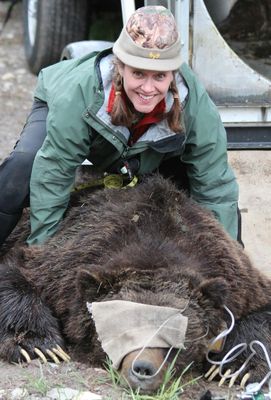
11:35
Transition
11:40
Abstract 252 - New opportunities for genetic sampling of ursids using snow tracks eDNA
Marta De Barba, DivjaLabs L.t.d; University of LjubljanaHall C
Marta De Barba, Frédéric Boyer, Luca Fumagalli, Marjeta Konec, Elena Pazhenkova,
Tomaž Skrbinšek, Pierre Taberlet
Genetic sampling, particularly through the so called noninvasive genetic techniques based on
the collection of scats, hair, etc., have been widely applied to ursids playing a key role for
understanding of their ecology and for solving management and conservation issues. Continued
advancements in molecular ecology research have allowed to retrieve organismal DNA from
environmental samples (e.g. soil, water, snow) expanding the wildlife genetic sampling toolbox.
DNA traces in the environment (eDNA), in fact, can be used to genetically sample animals in
their natural setting even without finding any visible biological material left by them. Most
eDNA studies have focused on species detection and derived applications via mitochondrial
DNA analysis, but recent progress in the field now enable recovery also of nuclear eDNA
suitable for population level analysis, including individual genotyping.
We will present successful individual genotyping of eDNA obtained from brown bear (Ursus
arctos) snow tracks. Snow samples were collected from tracks of brown bears in Slovenia
during winter, eDNA was extracted and genotyped using high-throughput sequencing of
microsatellites plus a sex marker, and individual identification was achieved for 71% of the
samples. We will discuss our results in relation to the new opportunities offered by snow track
eDNA for DNA based surveys and monitoring of ursids but will also outline the new challenges
inherent to field sampling and genotyping and provide recommendations for optimal
application of the method. Species of conservation concern and difficult to study, such as the
polar bear, as well as other bear species in ecosystems with a snowy season for which
ecological data are still lacking will benefit from the additional information acquired through
snow track eDNA.

Abstract 251 - Evidence for density-dependent effects on body composition of grizzly bears in a changing Greater Yellowstone Ecosystem
Andrea Corradini, Fondazione Edmund MachSalon 4
Andrea Corradini, Mark A. Haroldson, Francesca Cagnacci, Cecily M. Costello,
Daniel D. Bjornlie, Daniel J. Thompson, Jeremy M. Nicholson, Kerry A. Gunther, Katharine R.
Wilmot, Frank T. van Manen
The Greater Yellowstone Ecosystem, although recognized as one of the world's least impacted
temperate ecosystems, has undergone environmental alterations over the last decades. During
this period, concerted management efforts have allowed the grizzly bear population to increase
significantly. As a result, the range and density of the bear population have also increased,
despite a decline of some high-calorie foods. This study investigated the intraspecific processes
driving bear population demographics in the face of climatic and human impacts affecting the
availability of some key food resources. We examined lean body mass and percent body fat
from >400 grizzly bears over two decades and in relation to a temporally and spatially explicit
index of grizzly bear density, individual traits, and geographic areas. Specifically, we
hypothesized that individual lean body mass declined as population density increased, and that
density had an age-dependent effect. Further, we hypothesized that the ability to gain body fat
during the active season was independent of population density and environmental changes, as
omnivory helped buffer energy intake from fluctuation in high-calorie food sources. We found
that lean body mass was negatively related with grizzly bear population density, particularly in
young females. Although higher bear densities had a more negative impact on female bears,
they still reached their typical total body mass as they matured (>7 years of age), which may be
due to delaying reproduction or dispersal to areas with fewer bears. In contrast, we found that
the seasonal rate of body fat gain remained constant as grizzly bear population density
increased, despite recent environmental changes, possibly by shifting feeding tactics. Our study
shows that individual performance is influenced more by intraspecific competition than
landscape-level food changes, highlighting a notable resilience of Yellowstone grizzly bears to
environmental alterations.

12:00
LUNCH
Edmonton Convention Centre
BSG Members' Forum
Salon 4
Poster Set-Up
Salon 8/9
13:30
Abstract 172 - Results of a study of presence, population density, genetics and educational outreach of the Andean bear in the Cordillera del Condor, southeast of Ecuador.
Santiago Molina, Independent ResearcherHall C
Santiago Molina, Carlos Urgiles, Darío Cueva, Ma. José Pozo, Rodrigo Cisneros,
Rebecca Zug, Gabriela Arevalo, Martin Bustamante
The Cordillera del Cóndor is a mountain range south east of Ecuador whose
geological origins are older than the formation of the Andes. This mountain range
forms unique and particular ecosystems with high diversity and endemism and
with the presence of mature foothill forests and tepuis. In the 1980s, this area
witnessed a war between Ecuador and Peru, and in the following years until today,
large-scale mining projects are being developed.
Between the years 2016-2021, a first study of the Andean bear population present
in the area was carried out. The study was implemented in two mining concessions
and a protected area. Camera traps were used with designs to determine the
presence of bears in one of the concessions and the protected area, and population
density in the other concession. A study on genetic variability was also carried out
together with an educational outreach with habitants of the village of Río Blanco.
The monitoring effort involved 18,691 camera trap/days. In the cameras, the
presence of 10 bears was recorded in one of the concessions, and 22 bears in the
other. A population density of 7.49/100 km 2 was estimated with an abundance of
45 bears for the area. During monitoring, a particular overlap in habitat use was
identified between bears and two other mammal species in particular: Lowland
Tapir and Puma, one acting as potential prey and the other as potential predator.
The genetic analysis revealed that there is a population genetic structure in
Ecuador and that its variability could be greater than previously thought. During
the study, 26 species of medium to large mammals belonging to 14 families were
also recorded, of which 4 are endangered and 13 species are in some state of
conservation. Some of the records were new contributions to the ecology of
species in the country, opening new research opportunities.
The area where this Andean bear population occurs belongs to one of the priority
areas for the conservation of the species identified in the conservation action plan
for the Andean bear in Ecuador.

Abstract 992 - Intro to session: Employing IUCN’s Species Conservation Cycle for Bears: Examples from Around the World
David Garshelis, IUCN SSC Bear Specialist Group RetiredSalon 4
David Garshelis
The IUCN network includes ~10,000 volunteer experts within more than 160 Specialist Groups
under the Species Survival Commission (SSC). The IUCN sets goals and appoints or reappoints
leaders and volunteer experts on a quadrennial schedule, coincident with meetings of the
World Conservation Congress. During the 2017–2020 quadrennium, the SSC established the
“Species Conservation Cycle” as the conceptual framework for Specialist Group activities. As
such, the Bear Specialist Group (BSG) created quadrennial targets categorized by the 5
components in this conservation cycle. The first 3 components occur sequentially (the cycle),
while the other 2 are transversal: Assess – Measure status and trends of populations, threats
to populations, adherence to goals of a plan, or effectiveness of conservation actions.
Assessments are evidence-driven, both at the start of the cycle, and then starting again, after
planning and acting. Plan – Develop conservation strategies and policies to reduce threats and
improve conservation status of species or populations. This component relies on findings from
the assessment stage, and considers technical, spatial, and socio-political aspects. Act – Carry
out actions outlined in the plan aimed at directly improving conservation status. Actions are
often conducted in concert with parties that helped develop the plan. Network – Create
collaboration, partnerships, and capacity building to more effectively implement the
Assess–Plan–Act conservation cycle. These collaborations include both direct participants, as
well as people or organizations that can facilitate or enhance accomplishments. Communicate –
Disseminate information to enhance conservation. Communication should highlight each
aspect of the cycle (results from the assessment; goals of the plan; ongoing actions), targeted at
various specific audiences. This short talk introduces this BSG session, which will highlight
activities of some individual BSG members or teams employing these components to conserve
bears on all 4 continents.

Employing IUCN's Species Conservation Cycle for Bears: Examples from Around the World - Concurrent Session Chair Dana Morin
Salon 4
13:36
Abstract 986 - State of Knowledge about Human-Andean Bear Conflicts: Gaps and Opportunities to Inform Conservation Actions
Roxana Rojas-VeraPinto, Ecology and Evolutionary Biology, School of Biological Sciences, University of Reading, Reading, UK, IUCN SSC Bear Specialist Group StudentSalon 4
Roxana Rojas-VeraPinto, Rubén Bernardo-Madrid, Manuela González-Suárez
Crop damage and cattle predation by Andean bears may pose a threat to people’s livelihoods.
This leads to negative perceptions about bears, and consequent retaliatory killing, which
hinders the conservation of this threatened species. Here we examine the severity of this
problem by summarizing the current knowledge regarding human–bear conflicts in South
America, examining the magnitude and spatial trends in conflict reporting as well as the
mitigation actions proposed. This research highlights the “Assess” component of the Species
Conservation Cycle. A systematic review was conducted using Spanish and English keywords to
collect scientific publications and gray literature published since 1980. From each source, we
compiled information on the locations, methodology applied, and characteristics of conflict
events. We identified 84 references reporting more than 400 individual conflict events in over
300 locations; of these, 34 references focused on conflicts with Andean bears, most of which
were from Ecuador and Colombia. The most common method used to collect data on conflict
events was interviews with local people and authorities; only 9 studies included primary
sources with detailed field inspections. It is apparent from this review that documentation of
human–Andean bear conflict events is very limited and incomplete. To identify actions to
address conflicts, we reviewed available conservation plans and conflict manuals (n=22 and 6,
respectively). Most conservation plans were from Colombia (n=11). Most plans and manuals
recommended improving monitoring conflicts events, promoting compensation programs, and
supporting better agricultural practices. Manuals for the recording of predation events (mainly
on cattle) offer a good guide to verify bear damage, but the short-term recommended solutions
(generally deterrents) have not actually been tested. Our review underscores multiple gaps and
opportunities for improvement in reporting human–Andean bear conflicts. We urge more
efforts towards adopting standardized protocols for conflict reporting, which can be done in
collaboration with others working in Andean bear research and management.

13:45
Transition (Hall C)
13:50
Abstract 194 - Aversive conditioning of grizzly bears in Kananaskis Country, Alberta, Canada between 2000 and 2023.
John Paczkowski, Government of AlbertaHall C
John Paczkowski, Claire Edwards, Jay Honeyman, Derek Ryder
Aversive conditioning is a grizzly bear management tool which has been employed in the Parks
and Protected areas of Kananaskis Country, Alberta, Canada for over 20 years. The aversive
conditioning program involves applying different conditioning stimuli to grizzly bears in an
effort to change their behaviour and maintain public safety. We will discuss the context,
evolution and operational requirements of the program. We reviewed and summarized over
10,000 grizzly bear aversive conditioning records collected between the 2000 and 2023. Most of
the over 50 grizzly bears involved in the program were habituated female grizzly bears that
demonstrated a strong fidelity to the facility zone, an area of high human visitation and
recreational infrastructure. Juvenile and young bears, typically required more aversive
conditioning actions, while conditioning frequency diminished with age. None of the bears
involved in the aversive conditioning program were involved in a serious human wildlife
conflicts causing human injury or death. The aversive conditioning program has also reduced
the need for local facility closures and management removals of bears. Survival and
reproductive success of bears involved in the aversive conditioning program were relatively
high, which may contribute to a locally stable to grizzly bear population. Bears that left the
operational area of the aversive conditioning program, specifically protected areas, were often
subject to a higher frequency of management actions and removals. We will also discuss the
efficacy of different noise, projectile and contact projectile stimuli as well as the use of Karelian
Bear dogs. The Kananaskis Country aversive conditioning program is a model of how
management actions can achieve both public safety and conservation objectives in a high
recreational use landscape specifically parks and protected areas.

Human-Bear Conflict & Coexistence - Concurrent Session Chair Lana Ciarniello
Hall C
Abstract 987 - Pioneering Innovative Collaborations that Link Region-wide Forestry Decisions with Conservation of Grizzly Bears
Karine Pigeon, British Columbia Ministry of Water, Lands, & Resource Stewardship – Skeena Region, Smithers, B.C., Canada; University of Northern British Columbia, IUCN SSC Bear Specialist GroupSalon 4
Karine Pigeon, Kevin Koch, Maciej Jamrozik, Carolyn King
Indigenous self-governance is needed in forest landscape planning. Forest planning should
consider resilience to natural and human-caused disturbances including climate change, and to
be most effective, should recognize indigenous cultural recovery and stewardship. Forest
activities that impact our landscape need to take into consideration (1) the ability of Indigenous
peoples to meet their food, social, and ceremonial rights, and (2) cumulative effects on
ecosystems, wildlife, and their habitat. We aim to align forestry practices, wildlife stewardship,
and Indigenous-led cultural recovery in modernized land-use plans that preserve and create
healthy, diverse, and resilient forests. In a partnership between Nations, provincial
governments, and forest licensees, we co-created grizzly bear-focused guidance, a decision key,
for authorization managers who are responsible for the approval of harvest activities in
northwest British Columbia, Canada. This decision key considers cumulative effects on grizzly
bear populations and their habitat by proposing 5 scenarios that range from high restrictions
(i.e., no new harvest), to three levels of habitat enhancement, restoration, and monitoring, and
a final, low restrictions scenario (i.e., current best management practices). The proposed
scenarios are linked to present grizzly bear conservation concerns and landscape conditions
around the proposed harvest blocks. This project highlights our shared decision-making process
with an emphasis on the “Plan” and “Network” components of the Species Conservation Cycle
that led to the implementation of our decision key. I will share aspects of the collaborations
that were necessary to arrive at a useful product aimed at guiding effective conservation of
wildlife and their habitat. Because grizzly bears have an important role in cultural traditions and
philosophies of many Indigenous groups, and because they are seen to reflect the overall
health of the ecosystem they inhabit, stewardship of grizzly bears and their habitat is
pioneering new ways of approaching forest landscape planning.

14:04
Abstract 990 - European Brown Bear Conservation: A Continent-wide Assessment of Bear Intervention Teams
Djuro Huber, Faculty of Veterinary Medicine, Zagreb, Croatia, IUCN SSC Bear Specialist GroupSalon 4
Djuro Huber, Aleksandra Majić-Skrbinšek, Jon Swenson, Linas Balčiauskas, Tomasz
Zwijacz-Kozica, Gerard Baars, Klemen Jerina, Duško Ćirović, Michael Schneider, Ovidiu Ionescu,
John Linnell, Alexandros A. Karamanlidis, Michal Haring, Aleksandar Stojanov, Diana Zlatanova,
Maryna Shkvyria, Claudio Groff, Andres Ordiz, Jānis Ozoliņš, Sven Signer, Aleksander Trajce,
Peep Mannil, Ilka Reinhardt, Javier Naves, Peter Sunde, Mateja Blažič, Julien Steinmetz, Luigi
Boitani, Robin Rigg, Javier Naves, Martin Duľa, Haris Hadžihajdarević, Aleksandra-Anja
Dragomirović, Konstantin Tirronen, Dejan Radošević, Miradije Gerguri, Aleksandar Perović,
Agnieszka Sergiel, Marek Pasiniewicz, Ioan Mihai Pop, Slaven Reljić, Ilpo Kojola
We present findings from a comprehensive survey conducted in November 2023, engaging 40
experts from 30 European countries, to explore the operational landscape of Bear Intervention
Teams (BITs). BITs are specialized groups trained to manage bear-related incidents, including
conflicts between humans and bears, as well as situations where bears are in distress. Among
the surveyed countries, 18 reported having operational BITs, albeit with variations in their
jurisdiction and protocols. Notably, only 9 countries reported having an approved protocol for
BIT operations. The organizational structure of BITs varied widely, with governmental agencies,
forest management authorities, environmental NGOs, police-hunter collaborations, and
national parks all playing roles in different contexts. Compensation for BIT members ranged
from full-time employment to voluntary service. Mandates of BITs primarily focused on
surveying, reporting, and acting in bear-related incidents, with interventions ranging from non-
lethal methods (e.g., rubber bullets) to euthanasia as a last resort. The frequency of
interventions varied significantly, with some units handling only a few cases annually while
others managed thousands, indicating the diverse nature and intensity of bear-related issues
across regions. Common reasons for BIT interventions included bears entering human
settlements, traffic accidents involving bears, as well as cases of injured, sick, or orphaned
bears. Additionally, BITs addressed a vast array of challenges, from bears feeding on garbage to
illegal killings. In administrative units without a designated BIT, bear-related issues were typically resolved on a case-by-case basis by people with less training. Public acceptance of bears is often influenced by whether local people see prompt and professional response to an incident, or they are left alone to cope with the situation. BITs appear to be very useful in fostering human–bear coexistence through 3 key components of the Species Conservation Cycle: “Assessing” the situation, “Communicating” locally and nationally, and “Acting” on spot.

14:05
Transition (Hall C)
14:10
Abstract 125 - Aversive conditioning of grizzly bears produces high probabilities of retreat from human-bear conflict locations.
Claire Edwards, University of Alberta/Parks CanadaHall C
Claire Edwards, John Paczkowski, Colleen Cassady St. Clair
Protected areas provide important refugia for populations of grizzly bears (Ursus arctos), which
are threatened in Alberta. Many protected areas address human-bear conflict with a suite of
non-lethal tools including aversive conditioning and hazing. These tools apply negative stimuli
to bears with the goal of increasing wariness and reducing proximity to people. In Kananaskis
Country from 2000-2019, teams of technicians conducted aversive conditioning on 48 marked
grizzly bears in 6,539 conditioning events. Bears were conditioned using 20 different stimuli,
grouped by modality into: approach (vehicle or foot), noise (vehicles or humans), projectiles
(contact or non-contact), and pursuit (with or without Karelian bear dogs). When bear identity
was known, conditioning was over 50 times more likely to target adult females than adult
males, and in 99% of events where females were accompanied by cubs, cubs were young of
year or yearlings. Frequency of conditioning events significantly declined with bear age. When a
bear response to technician arrival was recorded, the average likelihood of retreat was 32%.
Retreat probability increased with the number of actions in the previous event, the number of
conditioning events in the preceding two weeks, and presence of cubs. When a response to
conditioning was recorded, bears almost always retreated from conditioning technicians (93%)
and rarely approached, either upon technician arrival (1%) or after conditioning commenced
(<0.001%). Bears were more likely to retreat from entire conditioning events when pursuit tools
were used, when there were more actions in the event and with increasing distance to cover.
These results suggest that bears in Kananaskis Country learned to retreat from aversive
conditioning and that this tool can help to reduce conflict-associated behaviour, supporting
long-term residency by bears in this protected area.

14:18
Abstract 991 - Conservation Actions Towards Human–Sloth Bear Conflict Mitigation in Central Gujarat
Nishith Dharaiya, Director, Centre of Excellence for Wildlife and Conservation Studies, BKNM University, Junagadh (Gujarat) India; IUCN SSC Bear Specialist GroupSalon 4
Nishith Dharaiya and Marcel Alaze
Human–wildlife conflict is an international issue that involves a host of wildlife species across
most regions of the world. Conflicts may lead to property damage, livestock casualties, and
human injuries, creating increased antagonism and retaliation towards specific wildlife species
in the local community; this may pose a significant challenge to conservation of these conflict-
prone species. The sloth bear is known for attacking people, and sometimes damaging their
crops, and as such, often has a negative reputation in local communities living near this species.
As India's human population rises, there has been an increase in humans using the same
resources as sloth bears, resulting in more negative interactions (including killing of bears).
Here we address the rising conflict between humans and sloth bears in the state of Gujarat, at
the westernmost extent of sloth bear range. We have been concerned over a shift towards
negative community perspectives towards sloth bears over time. The government and other
organizations have launched several community awareness campaigns, but the majority of
them have been ineffective in changing people's attitudes about sloth bears. According to our
research, the majority of awareness campaigns employ reading materials, picture books, and
audiovisuals as awareness tools; however, they rarely result in concrete action. Since 2020, we
have conducted over 50 outreach and awareness programs in 56 villages in central Gujarat,
focussing on places with a significant recent surge in sloth bear populations and human attacks.
We started action-based conservation programs in 2023, including bear safety education
demonstrations, distribution of bear deterrent-sticks (to ward off attacks), building water
accumulation sites (so sloth bears do not enter villages to hydrate), village consultation
meetings (advising how to reduce sloth bear encounters and gaining their ideas to deal with the
situation), planting fruit trees, and developing a standard operating procedure (SOP) for
handling conflict situations. We believe that our conservation initiatives and their
implementation have been remarkably successful in reshaping the local community's mindset
and fostering greater tolerance for coexisting with sloth bears. Our work has involved 3 of the 5 components of the Species Conservation Cycle: “Acting”, “Networking” and “Communicating”
to conserve the sloth bears in India.

14:25
Transition (Hall C)
14:30
Abstract 182 - Integrating multiple tools to understand landscape connectivity, address threats, and support long-term conservation of Andean bears in northern Ecuador
Rebecca Zug, Universidad San Francisco de QuitoHall C
Rebecca Zug, Santiago Molina, José León
Habitat loss and fragmentation are the primary threats to Andean bears (Tremarctos ornatus)
in Ecuador. A significant portion of the population occurs outside of protected areas on private
lands. When landowners are tolerant of bears, threats are minimized, and native habitat is
present, these lands can serve as corridors between protected areas, connecting fragmented
landscapes and maintaining ecosystem services. Our project uses a multifaceted approach to
understand and improve the connectivity of Andean bear habitat on private lands in the buffer
zones of Antisana Ecological Reserve and Cayambe-Coca National Park, 50 km northeast of
Quito. Since 2020 we have identified > 20 individuals, both resident and transient, at sites
where we also found domestic dogs, livestock, and people. Camera trap data confirmed that
bears cross roads and move seasonally outside of the study area. In 2023-24, we began
capturing bears and using GPS collars to understand habitat use and movement patterns. These
data will be used to focus conservation and outreach efforts toward the priority areas and the
protection of corridors. Preliminary results have identified an important feeding zone located
along a major highway, between agricultural lands and communities. Traditional cowboys have
large herds of cattle in this zone, making bear-livestock conflict another important threat. In
2022-23, we installed electric fencing in two communities as a first step toward improving
livestock husbandry and preventing conflicts. Proximity to Quito and the frequency of bear
sightings also make this area a tourist destination. When visitors bring dogs, hike off trails, leave
trash, or approach wildlife, tourism can have negative impacts. In 2023 we began promoting
responsible tourism through education and outreach and the development of a Best Practices
Manual for Andean bear and wildlife viewing. This multi-scale approach addresses a variety of
threats and supports long-term bear conservation.
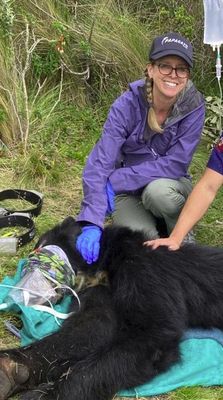
14:32
Abstract 988 - Educational Materials for Non-professionals Raise Conservation Awareness for Bears
Zsuzsa Petró, Sóstó Zoo, Nyíregyhaza, Hungary; IUCN SSC Bear Specialist Group; European Association of Zoos and Aquaria, Bear Taxon Advisory GroupSalon 4
Zsuzsa Petró, Amelia Griep, Eliza Bányácskai, Lydia Költer
Zoos have millions of visitors annually. They can reach a broad audience and communicate
accurate and powerful messages to the public, which may influence people’s understanding of
and attitudes about many species of wildlife; consequently, people may be moved toward
actions that may aid conservation. All 8 bear species are kept in zoos of the European
Association of Zoos and Aquaria (EAZA). One of the key roles of the EAZA Bear Taxon Advisory
Group (TAG) is to raise awareness of bears through education, thereby fostering more attention
to their conservation. Educational packages have been created for zoos and sanctuaries to
communicate information to visitors from a wide range of social, cultural, ethnic, and economic
backgrounds, aiming to influence people’s attitudes based on the “see it, sense it, save it”
principle. Educational material is available for different age groups. Here, we highlight the
“Communication” component of the Species Conservation Cycle by focusing on three recently
developed educational products. For preschool and elementary school groups, “The Bear Book”
conveys messages mainly by drawings. Information covering all bear species is embedded in a
fairy tale. Games at the end of the book help to recap and tighten the learned content in a
playful manner. For adolescents and adults, the EAZA Bear TAG created Educational Guidelines,
called “All About Ursidae”. This is an extensive and detailed compilation (~250 pages) of up-to-
date information about each of the 8 species as well as relevant topical areas. Concise text is
profusely illustrated with drawings and photos. It starts with bear ancestry, and then covers
morphology and ecology of each species, followed by chapters about hibernation,
reproduction, and communication. There is considerable focus on status and threats with
reference to the IUCN Red List. It also includes reports on conservation projects contributed by
invited bear biologists/conservationists mainly from the BSG. It culminates with a section about
“what can you do?” Thirdly, we developed a leaflet/poster titled the “Bear is Not a Toy” which
can be downloaded in 7 languages to help hikers stay safe in European regions with brown
bears. The hope is that both people and bears suffer fewer tragic encounters. All of these
materials are freely available. Educational Guidelines: https://www.eaza.net/assets/Uploads/CCC/BPG-2024/Bear-Educational-Guidelines.pdf Bear
Book for kids (video): www.youtube.com/watch?v=cR9YrcFE28w Bear is Not a Toy:
www.drive.google.com/drive/folders/1nS44EEsMylH2EV4cltdeFYYSQU_pD63F?usp=sharing

14:45
COFFEE BREAK
Edmonton Convention Centre, Hall C
14:46
Abstract 989 - Sun Bear Conservation Action Plan: A Mid-term Assessment
Matt Hunt, Free the Bears, Luang Prabang, Laos; IUCN SSC Bear Specialist GroupSalon 4
Matt Hunt, Brian Crudge, Caroline Lees
Sun bears face significant threats from hunting and habitat loss, leading to declines in wild
populations across their range. Populations are predicted to continue to decline unless the
threats to this species are adequately addressed by conservation actions. In June 2019, the Sun
Bear Conservation Action Plan was launched. This 10-year plan was developed in a collaborative
and iterative process over several years, following the IUCN SSC Conservation Planning
Specialist Group’s One Plan Approach to integrate in-situ and ex-situ species conservation
planning. Prior to this initiative, of the 8 bear species, a global action plan had been created
only for the polar bear, making the sun bear the first terrestrial bear species with a range-wide
plan. The Sun Bear Conservation Action Plan details 19 objectives and 63 actions aimed at
attaining 5 overarching goals: (1) eliminating illegal exploitation; (2) protecting and restoring
habitats and populations; (3) devising and employing reliable monitoring methods; (4)
maximising ex-situ contributions to conservation; and (5) increasing cross-sectoral support and
collaboration for sun bear conservation. Implementation during 2019–2028 is coordinated by a
Sun Bear Action Plan Implementation Task Force, under the IUCN SSC Bear Specialist Group. At
this mid-point of the plan, we will assess progress against the indicators identified in the plan.
This project involves the “Assess” component of the Species Conservation Cycle. The action
plan included a status assessment of the species, and here, after planning and acting, we start
the second round in the cycle: measuring adherence to the plan’s goals, and effectiveness of
conservation actions. We will provide a critical evaluation of the Sun Bear Conservation Action
Plan, highlighting successful elements and identifying challenges hindering the implementation
of certain actions. The IUCN SSC is committed to ensuring that all Threatened species on the
Red List are covered by an effective conservation action plan (currently 41,200 species). Despite
being a small family of charismatic megafauna, challenges remain in developing species
conservation action plans for other Ursidae. This assessment of progress midway through the
Sun Bear Conservation Action Plan will help to refine expectations about the feasibility and
value of various conservation actions, contributing not only to sun bear conservation but also to
the broader goal of ensuring effective action plans for threatened species worldwide.

15:00
COFFEE BREAK
Edmonton Convention Centre, Salon 4
15:10
Abstract 189 - Tracing the Social Network of an Umbrella Species: Uncovering Communication Dynamics to Inform Grizzly Bear Conservation and Management
Courtney Hughes, Winisk Research and ConsultingHall C
Courtney Hughes, Andrea Morehouse, Devin Holterman, Hannah Rasker
The ways people organize in social networks to share information and influence behaviours is a
fundamental aspect of conservation and management. Social network analysis is a tool that
allows us to understand these networks and the information exchange within them. Leveraging
this information can help design, implement, and evaluate conservation efforts. Our project
proposes to understand the social network for grizzly bears – a charismatic species that elicits
varying opinions, given that differing values can lead to governance and policy challenges,
rendering conservation efforts difficult to successfully implement. Understanding the social
network of conservation researchers and practitioners will help inform and enhance grizzly bear
conservation and management throughout its range, from Yellowstone to the Yukon. Our
overall objective is to understand how people organize, share information, and influence
behaviour change related to grizzly bear conservation with an additional emphasis on human-
bear conflicts. This information can help implement more successful conservation,
management, and policy interventions. Our results will identify ways to leverage, strengthen
and mobilize the social network for grizzly bears. This includes informing engagement strategies
that identify key players in grizzly bear conservation/management, and areas of disconnect
and/or knowledge gaps; measuring diversity of expertise and skills within and across the
network; encouraging inclusivity and interconnectedness to optimize information sharing; and,
identifying communication channels and areas requiring knowledge transfer and transitions.
Further, these data can help build skills and capacity for organizations to successfully
participate in grizzly bear conflict reduction.ear conflict reduction.

15:20
Abstract 81 - Brown bears escape from overcrowded road infrastructure by utilizing Ceausescu’s existing underpasses
Mihai Fedorca, National Institute for Research and Development in Forestry Marin Dracea, Transilvania University of BrasovSalon 4
Mihai Fedorca, Ancuta Fedorca, Georgeta Ionescu, Ovidiu Ionescu Dracea, Ramon
Jurj
Roadkill and habitat loss are two of the main threats to biodiversity, and both people and
wildlife could be injured, and many times, both lose their lives. Road ecology has evolved as a
tool to reduce these encounters and the damages, but unfortunately, in areas where the road
infrastructure is already overcrowded and impossible to cross, the costs to mitigate these
conflicts are very high and often hard to obtain. Our study aims to demonstrate that wildlife
species, especially brown bears, are crossing busy roads by using existing bridges built in the
past to regulate the water flow to pass under the road. The study is in Romania (Eastern
Europe) – Brasov County, where we have monitored 30 bridges in the period starting from
March 2022 till August 2023, using photo trap cameras. In this period, more than 1500
crossings have been recorded by the cameras, which can be translated into the same number of
accidents being avoided. The maximum number of crossings was registered in the summer
months (July and August), correlated with the holiday period when the traffic volume in the
area was the highest.

Bear Behaviour - Concurrent Session Chair Andrea Corradini
Salon 4
15:25
Transition (Hall C)
15:30
Abstract 113 - Anthropogenic Disturbance on the Space Use of Locally Endangered Formosan Black Bear (Ursus thibetanus formosanus) in Taiwan
Fang Chen, University of Michigan StudentHall C
Fang Chen, Neil Carter, Mei-Hsiu Hwang
Anthropogenic impacts, such as habitat degradation and overhunting, pose significant threats
to wildlife populations globally. In Taiwan, alongside habitat loss due to urban development,
the proliferation of snare traps has escalated threats to the locally endangered Formosan black
bear (Ursus thibetanus formosanus), leading to increased mortalities and physical injuries.
Despite the severity of these issues, there is limited information that can inform conservation
strategies regarding the preferred habitat characteristics of the bears and the long-term
behavioral impacts of snare trap-derived injuries. In this study, we used integrated resource
selection functions (iRSFs) and integrated step selection functions (iSSFs) to analyze the habitat
selection patterns of 15 bears (6 injured, 9 healthy) inhabiting Yushan National Park, Taiwan.
Further, we generated a predictive map to visualize habitat suitability and compared the
habitat selection patterns between healthy bears and those injured by snare traps. Population-
level results indicated that bears prefer habitats characterized by rugged terrain with a
preference for broad-leaved forests over other land cover types. However, injured bears
exhibited diminished preferences for terrain ruggedness and different human avoidance
patterns compared to healthy bears. These results suggested that the ability of injured bears to
access high-quality habitat patches could be constrained, potentially increasing the encounters
and risks from humans and impacting their energy gain in the long term. This study highlights
that the impacts of snare traps extend beyond mortality and physical injury, possibly
influencing the behavioral and energetic dynamics of bear populations. Conservation efforts
must prioritize the preservation of high-quality habitats and regulations on snare trap usage to
protect this locally endangered species.

15:35
Transition (Salon 4)
15:40
Abstract 88 - Using a behavioural classification of accelerometry data to evaluate effects of hunting risk on Scandinavian brown bear behaviour
Jeanne Clermont, Université de Sherbrooke StudentSalon 4
Jeanne Clermont, Andreas Zedrosser, Ludovick Brown, Frank Rosell, Gunn Elisabeth
Sydtveit Rekvik, Jonas Kindberg, Fanie Pelletier
Predation may indirectly influence prey’s fitness and population dynamics through behavioural
adjustments in response to perceived predation risk. These non-consumptive effects of
predation can also arise from hunting by humans, but they remain less understood compared
to those arising from natural predators. Advances in biologging allow detailed assessments of
the activity budgets of elusive wildlife, increasing the potential to uncover the non-consumptive
effects of human activities on animals. We used tri-axial accelerometry to record the daily
activity of 24 Scandinavian brown bears from a heavily hunted population in Sweden (29 bear-
years, 2015-2022). We used a supervised machine learning algorithm trained with observations
of captive brown bears to classify the accelerometry data into four behaviours, i.e., running,
walking, feeding, and resting, with an overall precision of 95%. We then evaluated changes in
bear activity budgets before and during the hunting season. We found that bears exhibit a
bimodal daily activity pattern, being most active at dusk and dawn, and resting around midday
and midnight. However, during the hunting season, females showed a higher probability of
being active during the day than before the hunting season, while males showed the opposite
pattern by becoming more nocturnal. Since legal hunting occurs mostly during daylight hours,
these results suggest that bears modify their activity level as an anti-predator response to
hunting risk, but that tactics differ between sexes. Additionally, daily number of running bouts
did not vary between seasons in both sexes, but females’ proportion of running bouts occurring
during legal hunting hours was higher during the hunting season than prior to it, suggesting
they may use running as a tactic to avoid hunters. More detailed assessments of wild animal
behaviours have the potential to increase our understanding of the impacts of human activity
on wildlife and help guide conservation decisions.

15:45
Transition (Hall C)
15:50
Abstract 198 - Animal learning contributes to both problems and solutions for bear–train collisions
Colleen Cassady St. Clair, University of AlbertaHall C
Colleen Cassady St. Clair
Transportation infrastructure frequently causes an ecological trap for bears that are attracted
to roads and railways for foraging and travel opportunities, but these attractants increase the
risk of mortality from collisions. This situation occurred for a threatened population of grizzly
bears (Ursus arctos) in Banff National Park, Canada, where train strikes became a leading cause
of mortality. Several students, collaborators, and I explored this problem by studying rail-
associated food attractants, habitat use of GPS-collared bears, and patterns of past mortality.
Bears appeared to be attracted to grain spilled from rail cars, enhanced growth of adjacent
vegetation and train-killed ungulates with rail use that increased in spring and autumn, and in
areas where trains slowed, topography was rugged, and human density was low. Across
multiple species, mortality was best predicted by higher train speeds, with contributions from
track curvature and proximity to water bodies. Rapid learning by bears may have increased
collision vulnerability via reductions in lethal bear management, changes in ungulate
distribution and abundance, and changes in human activity, but that same learning capacity
might prevent train strikes in future via simple warning devices, such as the one we invented,
that signal approaching trains. Emerging technology associated with electric vehicles might also
contribute to better safety by amplifying and directing engine noise as an audible warning to
reduce strike vulnerability for bears and other wildlife.

15:55
Transition (Salon 4)
16:00
Abstract 99 - Factors Influencing Duration of Behaviors in American Black Bear (Ursus americanus) Adult Females and Their Cubs Surrounding Hibernation
Brogan Holcombe, Virginia Tech, Department of Fish & Wildlife Conservation StudentSalon 4
Brogan Holcombe, J. Bernardo Mesa-Cruz, Marcella J. Kelly
Hibernation behavior is understudied in American black bears (Ursus americanus), with most
knowledge stemming from post-hibernation emergence studies. Temperature and photoperiod
have been identified as potential drivers of the timing of hibernation but are also linked to food
availability. We explore drivers of bear activity surrounding hibernation using a unique video-
recorded data set of four temporarily captive female bears with cubs in a food-controlled
environment. We subset 22,000+ hours of video into two interval cycles to 1) analyze adult
behavior from September 2015 to May 2016 and 2) analyze mother-cub interactions post-birth,
including whether mothers showed bias towards biological vs. foster cubs. We consolidated 58
behaviors into three broad classifications (active, passive alert, passive) and found that the
hibernation stage, time of day, and interaction between photoperiod and temperature were
associated with changes in adults’ activity levels. During hyperphagia, post-birth, and
emergence stages, increased activity levels were driven by both higher temperature and
photoperiod, but the onset of hibernation was primarily driven by temperature only. We
further found that mother bears did not spend significantly more time with either cub group,
indicating no bias toward biological vs. foster cubs. Additionally, cubs did not show more
dominant (i.e., bullying) behaviors toward foster than biological siblings, providing evidence of
successful foster cub litter integration, which is promising for orphan cub fostering programs.
Finally, our results indicate that rising temperatures regionally could be responsible for
increased active behaviors, especially during hibernation onset, which could lead to increased
human-bear interactions on the landscape.

16:05
Transition (Hall C)
16:10
Abstract 163 - Indigenous Knowledge of Human-Polar Bear Coexistence in Churchill,Manitoba, Canada
KT Miller and Georgina Berg, Royal Roads University StudentHall C
Katharina M. Miller, Georgina Berg, Indigenous Knowledge Keepers of Churchill (as
a collective) Michael Lickers, Dominique A. Henri
Polar bears (wapusk; nanuq; sas; loor blaan; Ursus maritimus) and people have shared northern
coastlines for time immemorial, yet concerns about polar bears coming into communities is
increasing. As the Arctic warms and sea ice habitat declines due to climate warming,
coexistence strategies between people and polar bears have become increasingly important.
This study uses community-based participatory research; coproduction of knowledge; hands
back, hands forward; and storytelling to document Indigenous knowledge of human–polar bear
coexistence with Swampy Cree, Sayisi Dene, Caribou Inuit, and Métis people of Churchill,
Manitoba, Canada. By coupling deductive time-based themes with inductive thematic analysis,
this research documents Indigenous knowledge and provides recommendations as future
visions for human–polar bear coexistence in Churchill, Manitoba: protect tourism as an
important industry and economy, support proactive management and less invasive research,
elevate Indigenous knowledge, improve education and safety awareness, and cultivate a
culture of coexistence.
Funding for this research was provided by Polar Bears International and Environment and
Climate Change Canada.

16:15
Transition (Salon 4)
16:20
Abstract 169 - Main drivers of brown bears’ circadian activity: a global assessment.
Aurora Donatelli, Sapienza University of Rome StudentSalon 4
Aurora Donatelli, Dusko Cirovic, Mark Haroldson, Djuro Huber, Jonas Kindberg, Ilpo
Kojola, Josip Kusak, Gianluca Mastrantonio, Andres Ordiz, Slaven Reljic, Luca Santini, Frank T.
van Manen, Paolo Ciucci
The scope of our study was to evaluate effects of anthropogenic pressure, land productivity,
and ambient temperature on circadian activity rhythms of brown bears (Ursus arctos) at a
transcontinental scale. We quantified activity through hourly movement rates and used this as
the currency to compare activity of bears from the Central Apennines, Dinaric-Pindus, Greater
Yellowstone Ecosystem, Karelian, and Scandinavian populations. Based on a Bayesian modeling
approach, activity rhythms of bears in all populations were best represented by a bimodal curve
with crepuscular peaks. Bears at northern latitudes (i.e., Sweden and Finland) generally display
higher activity levels compared to the other populations, while bears in Yellowstone exhibit
slightly lower nocturnal activity, and higher diurnal and crepuscular activity compared to
various study areas in Europe. The overall effect of human disturbance is to increase
crepuscular/nocturnal activity and/or decrease diurnal activity in all study areas, with slight
differences across seasons. However, the magnitude of this effect is stronger for bears residing
in less disturbed landscapes, as they may be less habituated to human activity. In addition, all
populations tend to increase nocturnal activity and decrease diurnal activity, as a response to
higher daily maximum temperatures. Lastly, the effect of the Normalized Difference Vegetation
Index on circadian activity is much more variable across study areas and seasons, depending on
the key foods that characterize each population’s diet. Future research should focus on possible
effects of modifications in activity rhythms on survival and reproduction. Whereas flexibility in
large carnivores’ circadian activity is a key component of their adaptive strategies for co-
habiting with humans, drastic changes in activity may occur at the expense of the individual's
fitness, with potentially cascading effects across ecological communities.

16:59
Poster Session/Beverages and Food Reception
Salon 8/9
17:00
Abstract 164 - A Study on the status and distribution of Himalayan Brown Bears (Ursus arctos isabellinus) in Kashmir Valley, India using camera traps and GPS collaring
Aaliya Mir, Wildlife SOS ProfessionalSalon 8/9
Aaliya Mir, Thomas Sharp, S. Swaminathan, A. Sha. Arun, Kartick Satyanarayan,
Geeta Seshamani
Human-wild animal conflict has always been high in the Kashmir Valley, mostly involving black
bears and leopards. However, recently human-brown bear conflict has emerged as a new
challenge in this region. There is little structured literature available on the ecology and status
of brown bears in Kashmir valley. Therefore, we set out to assess the status, distribution and
ecology of brown bear population in the Central Wildlife Division of Kashmir, India, using field
techniques, camera trapping and GPS collaring with an ultimate goal of finding solutions that
will benefit both people and wildlife. Brown bears in the study area were distributed in the
alpine meadows with a specific elevational range (3000 to 5000 m). Direct sightings revealed
congregations of bears in a few areas; especially in the North-Western (Sarbal) and Eastern
region (Amarnath/Baltal). The relative abundance of the brown bear was recorded to be
around 0.12 ± 2/km. Camera trapping recorded bears in five locations, while as the density
estimate of brown bears based on REM was 1.53/km2. Brown bears were found heavily
dependent on the grazing livestock and garbage sites. The scat analysis revealed that bears in
the region fed upon garbage food items (75%), wild plant matter (16%), crop raiding (0.41%)
and sheep hunting (0.31%) respectively. Out of 408 scat samples, 86 were found to have plastic
carry bags, milk powder and chocolate covers. From July to September, 2023, we radio collared
six brown bears (4 males and 2 females) with GPS iridium collars to understand habitat
utilization and movement patterns. Initially, after collaring, the bears moved large distances
away from the habituated open garbage dump areas, however, they eventually returned and
tended to stay close to these dumps. All 6 collared bears went into hibernation in month of
November, 2023.The information gathered in this project will be of vital importance in
developing future conservation plans and management initiatives.

Abstract 247 - Using Video Camera Collars to Investigate Free-Living American Black Bear(Ursus americanus) Diet Composition
Brogan Holcombe, Virginia Tech, Department of Fish & Wildlife Conservation StudentSalon 8/9
Brogan Holcombe, Kevin Bayne, Robert Alonso, David McNitt, W. Mark Ford,
Marcella J. Kelly
American black bears (Ursus americanus) are the largest omnivores in the Appalachian
Mountain landscape, yet few diet composition studies exist from the area. Previous studies
generally determined diet composition from scat collection and subsequent macroscopic
analysis to create diet profiles. While scat sampling may be effective for studying obligate
carnivores, these methods are likely less accurate for omnivores as soft mast and fungi break
down quickly in digestion, likely producing incomplete diet profiles from scat. We used video
camera collars on 15 wild bears (8M, 7F) in 2018-2019 to determine diet composition by
identifying items bears consumed on video in western Virginia to better understand diet and
potential impact on the region’s declining white-tailed deer (Odocoileus virginianus)
populations. Each collar recorded 9-21 secs of video every 20 mins during the day (15-20
mins/day) for up to 17.5 hours per bear. Bears consumed 182 unique fungal or vascular plant
species (including invasives), 7 insect types, 5 animal species, and 5 anthropogenic food items.
We found previous studies had a lower proportion of fruit/seed soft mast (0.404) than we
observed (0.659) and a lower proportion of herbaceous soft mast in spring (0.396) than in our
study (0.558). We found high dietary overlap (0.958-0.984) between sexes but considerable
variation within sexes by season (0.125-0.929). We further found lower diet breadth in spring
(1.833) compared to fall (2.555) for all bears, and higher diet breadth values for females in
summer (2.011) compared to fall (1.876). Males had more deer consumption events [adults &
fawns], whereas females had higher fawn consumption in spring, potentially impacting deer
recruitment. Using emerging technologies allowed us to provide increased resolution and
accuracy in determining bear diet across seasons, individuals, and sexes, which is useful for
better-informed bear management, including understanding bears’ impact on deer
populations.

Abstract 8 - Milk Effects on Bornean Sun Bear Cub Mass in Malaysia
Ellen Wieczorek, Corresponding Author, Unity Environmental University, North American Coordinator for Bornean Sun Bear Conservation Centre, Sabah, Malaysia Self-EmployedSalon 8/9
Ellen Wieczorek, Siew Te Wong, Boon Nie Yeoh
This study analyzes milk formulation impacts on Bornean sun bear (Helarctos malayanus
euryspilus) cub mass and feeding data collected at the Bornean Sun Bear Conservation Centre
in Sabah, Malaysia. We use generalized linear mixed model with random effects to assess
disparities between sun bear cub (n = 10) mass gain (x̄ = 13.09 kg, s = 4.66 kg, Range [4.40-27.45
kg]) and differences between male and female hand-reared cubs based on >1000 daily or semi-
weekly measurements recorded since 2013. We found lower mass gain in females (x̄ = 11.8 kg),
compared to males (x̄ = 16.1 kg), and model results suggested sexual dimorphism as the cause
between male and female average mass. The model identified significant variables as the
individual bear, age, and the percentage of body mass fed. Milk formulation was varied by
individual health metrics, and feedings were calculated using ml/kg. Additional research should
assess sun bear milk composition to more closely simulate milk.

Abstract 27 - Bearly Guilty: Understanding Human–Andean Bear Conflict Regarding Crop Losses
Viviana Albarracín, Independent ProfessionalSalon 8/9
Viviana Albarracín and Enzo Aliga Rossel
Conflicts between wildlife and humans are increasing worldwide, especially in areas where they
coexist and share resources. To investigate attitudes and opinions of the human population
towards human-Andean bear (Tremarctos ornatus) conflicts in two indigenous Aymara
communities, Chuñavi and Lambate, Bolivia, semi-structured interviews were directed to an
adult member of families in the communities. Simultaneously, we registered, monitored, and
evaluated 70 farm plots to record evidence of Andean bear and other wildlife damage to the
maize crops and plants. We found that the locals thought the bear caused the most damage
when, in actuality, the most harmful issues identified for maize crops were environmental
factors, followed by parrots and birds. Knowledge of the interactions between wild animals and
productive systems can contribute to an understanding of Andean bear-human coexistence.

Abstract 28 - Conservation of the Elusive Andean Bear in Inquisivi and Quime region, Department of La Paz, Bolivia.
Viviana Albarracín, Independent ProfessionalSalon 8/9
Viviana Albarracín
From April 2021 to April 2022, we conducted surveys along field routes established in 20
quadrants of 16 km2 each. Our sampling effort was concentrated on ridges and paramo. The routes were
georeferenced, as well as the location of each sign detected, to set camera-trap stations. We
found bear sign in each of 10 studied quadrats. A particularly large number of sign locations
associated with feeding events were found in the paramo. We observed differences in the
signs found in the cloud forest by season and altitude. The presence of bears seems to be
influenced by the fruiting season of certain species, particularly at lower altitudes in the portion
of the clouded forest, coinciding with the start of the rainy season We reported 18 new records
of bear sign, and once those were obtained we set several camera traps in 2022 in an area that
the project is promoting to consolidate as a possible Municipal Protected Area and Integrated
Management Natural Area. This proposed protected area includes clouded forests and Andean
paramo, which could be a key addition to Andean bear habitat since this project confirmed the
presence of bears during the wet and part of the dry season in the area.

Abstract 29 - Current status of Andean Bear in the municipalities of Samaipata and Mairana department of Santa Cruz, Bolivia
Viviana Albarracín, Independent ProfessionalSalon 8/9
Viviana Albarracín and Ana Belen Robles
The elusive Andean or spectacled bear; it is categorized as Vulnerable (VU) species at the
national level as well by the IUCN. The Andean bear is an enigmatic flagship species for the
clouded forests and adjacent Andean meadows of the Tropical Andes. However, habitat loss
and human-animal conflict issues severely threaten the Andean bear across much of its Bolivian
range, increasing the threats over the species.
Given the importance of the Andean bear for conservation efforts across the Tropical Andes
and yet the lack of systematized information regarding distribution and ecology, it’s a must to
gather and collectively analyze existing Andean bear data for the department of Santa Cruz.
This area was not studied for 30 years, so it is possible that this place supports a good
population of bears. This species it is associated with habitat (cloud forest) very important for
the climate and water regulation at the regional level and that is why it is considered as a good
indicator of the health status of these forests. This research describes the presence of the
Andean bear in the Department of Santa Cruz in the municipalities of Mairana and Samaipata,
which are within the limits of the Andean Bear Conservation Units (UCO) proposed for Bolivia
and Peru. With the help of local inhabitants, we registers different signs of the presence of the
Andean bear, determining the occupancy of the bear as well in the area. Threats, in particular
conflict with humans. Involving the locals in this type of study is to recognize the opinion and
its knowledge in addition to considering it in making decisions that is increasingly important.

Abstract 31 - Evaluation of local ecological knowledge as a method to collect data on occupancy and probability of detection of Tremarctos ornatus, in the Apolobamba National Integrated Management Natural Area
Viviana Albarracín, Independent ProfessionalSalon 8/9
Viviana Albarracín
Between May 2017 and June 2019, interviews were held in the Apolobamba National
Integrated Management Natural Area to study the sites that are prioritized for conservation of
the Andean bear. The little information on the presence and distribution of this species is
particularly notable in remote areas, despite the fact that they are usually places rich in
biodiversity.
The use of interviews with the local population to replace traditional methodologies (such as
transects or camera traps) when estimating the distribution of species and at the same time
being able to monitor them. Each interview at a study site serves as a replicate for the location,
thus making it possible to construct a detection history (using interview responses of whether a
species is present or absent at that site) for each site in the study area. This method is seen as a
useful approach to monitor and evaluate the presence of the species that occupies large
geographic areas due to its high effectiveness at the cost-benefit level. In this sense, working
with people's local knowledge that can provide relevant biological information for conservation
efforts.
This novel alternative of models based on interviews allows us to identify parameters with a
strong influence on the presence of the species that allow us to generate a baseline for
monitoring, a requirement to determine the effectiveness and efficiency of conservation plans.

Abstract 51 - The Absent Shrine: Arctolatry in the Japanese Archipelago
David Laichtman, Sophia University StudentSalon 8/9
David Laichtman
“The Absent Shrine” is an analysis of bear worship in the Japanese archipelago. It contends with
the apparent paradox of A. Irving Hallowell’s boreal arctolatric ubiquity premise and the lack of
institutionalized ursine religion in Japan. A document and artifact based survey provides the
historical context of bear religion for Ainu, Okhotsk, and Mountain Reverence groups in the
archipelago. A Lived Religion ethnographic approach undertaken via participant observation
and semi-structured interviews of hunters, conservationists, photographers, and camera-
trappers is the basis of an evaluation of contemporary bear worship, allowing for a description
of how the modern and historical practices differ. By then engaging with the praxis/doxis
dialectic in Japanese religious studies, the work concludes that despite its incongruence with
institutionally-predicated religious complexes, bear worship persists as an archipelago-spanning
numinous qualia. By constructing a novel spectrum for use as a metric of religious adherence,
and applying this conclusion thereto, “The Absent Shrine” reframes not just bear worship, but
the religious experience in the archipelago, as a mechanism for reckoning with the kinetic
triangular relationship between humans, animals, and environmental spaces.

Abstract 55 - Bear Awareness Gardiner: Grizzly Bear Conflict Mitigation Work In the Greater Yellowstone Ecosystem, Montana
Evan Stout, Bear Awareness Gardiner ProfessionalSalon 8/9
Evan Stout
Gardiner Montana sits on the northern boundary of Yellowstone Park, and is surrounded by a
patchwork of Federal, State and private lands. Seasonally, grizzly bears migrate through the
Gardiner Basin, and often come into conflict with humans while gaining access to attractants
such as fruit trees, garbage, grease traps, pet foods and chicken coops. Our mission at Bear
Awareness Gardiner is to create greater human safety and reduce bear conflicts by securing
attractants and unnatural food sources from the bears. We work in partnership with the State
of Montana, Fish Wildlife and Parks, the National Park Service, The National Forest Service and
several other NGO's to accomplish our goal.
My poster presentation will cover our history of conflict issues in Gardiner, our current
strategies with on the ground work, the complications of cross boundary management between
agencies, program funding, building community participation, successes and challenges, and
the future work of Bear Awareness Gardiner. This may be helpful for any other similar
communities working to reduce human and bear conflicts.

Abstract 68 - Role of Protected areas in the conservation of Asiatic black bear in Pakistan
Muhammad Naeem, IUCN/SCC/ Bear Specialist Group ProfessionalSalon 8/9
Muhammad Naeem Awan
Improving the management effectiveness of protected areas is essential for the successful
protection of species, necessitating a focus on refining management practices. The Asiatic black
bear is one such globally significant species in need of robust conservation strategies for its
protection. Within Pakistan, the inquiry arises: do the existing protected areas within its habitat
genuinely contribute to its conservation efforts? Have the conservation plans for these
protected areas integrated actions for the Asiatic black bear's conservation? Additionally, an
exploration of the threats facing the bear within PAs, the extent of its habitat both inside and
outside PAs, and the evaluation of its situation in protected areas encompassing its Pakistani
range are all pivotal questions. Consequently, this undertaking aims to address these inquiries,
offering valuable insights into the conservation of a species like the Asiatic black bear. The
resulting data will be of equal significance in assessing the status of the species within
protected areas situated within its Pakistani range and appraising the efficacy of these areas in
its conservation.
The project's findings will help advocate for the adoption of adaptive management to fine-tune
strategies in light of emerging data and shifting scenarios. By embracing the core tenets of
adaptive management, a continuous process of adjustments can be fostered, ultimately
enhancing the management effectiveness of protected areas efforts in safeguarding species
and their respective habitats.

Abstract 74 - Documenting Bear Dens using Light Detection And Ranging (LiDAR) Technology
Tyler Brasington, National Park Service ProfessionalSalon 8/9
Tyler Brasington, Jessica M. Hadley, Justin K. Schwabedissen
During hibernation, American black bears (Ursus americanus) and grizzly bears (Ursus arctos
horribilis) in the Greater Yellowstone Ecosystem (GYE) create dens for protection from harsh
winter environments and to give birth to cubs. Previous studies have acquired den site
characteristics through physical measurements recorded by researchers in the field. Using the
light detection and ranging (LiDAR) sensor onboard an Apple iPad Pro, we scanned the interior
of bear dens (n = 9) located in the GYE to generate point clouds of den structure. We then
generated a three-dimensional digital model of each den by processing the point clouds using a
combination of available software packages. Computer-generated LiDAR dimensions from the
three-dimensional LiDAR models were compared to physical den measurements of the dens
recorded by field personnel. The LiDAR generated measurements were within 2% of the
physical measurements for every bear den surveyed. Tablet-based LiDAR technology exhibits
easy operability and can be readily integrated into den site surveys. The resulting three-
dimensional digital models can be catalogued for future studies and provide the advantage of a
more robust dataset compared to traditional measurements. This is the first known use of
LiDAR to measure bear den characteristics in the field.

Abstract 80 - Active or inactive - through the eyes of the camera and accelerometer
Tomasz Zwijacz-Kozica, Tatra National Park ProfessionalSalon 8/9
Tomasz Zwijacz-Kozica
Activity level is important information about an animal's biology and ecology. In the case of
brown bears, knowing the activity pattern also allows to take appropriate measures to prevent
conflicts with humans. However, obtaining data on this subject is not an easy task. Direct
observations, if possible at all, are most often of a very random nature. Therefore, attempts are
made to validate the accelerometer data and identify specific behaviors. Most often, direct
observations of animals in captivity are used for this purpose. In the case of free-living animals,
this is most often possible in relation to non-shy individuals who often roam in open spaces
near people. However, telemetry collars equipped with a video camera allow to look at the
behavior of animals leading a secretive lifestyle, e.g. wild brown bears. The aim of the work is to
compare information collected by an accelerometer and a video camera deploon the same
collar deployed on a young brown bear in the Tatra Mountains.
Abstract 84 - The Untold Biblical and Early Christian History of Bear
Gerald Hodge, Appalachia Georgia Friends of the Bears, Inc. ProfessionalSalon 8/9
Gerald Hodge
History has not necessarily been kind to bears. The historiography of bears has only begun to
grow in the last 30 years. Few historians have ventured to objectively analyze the bear through
the Judeo-Christian prism.
The Holy Bible mentions bears 14 times. Twice in these accounts, bears were “Agents of
God,” and controversy. The first and most awkward is the story of Elisha, the 2 she-bears, and
the 42 “little boys.” Theologians have reexamined the original Hebrew and context; they have
found that these were not youths at all. In my research, no theologians nor wildlife biologists
have put together the fact that adult bears, minus the Sloth bear, have 42-teeth. This has
meaning.
Another fascinating missed bear controversy was the Fourth Egyptian Plague. When the
Christian Holy Bible was established in 382 CE they used the Septuagint, written in Koine Greek
by Jewish scholars. The Fourth Plague was recorded as flies. However, in the book of Wisdom,
written in the 1st Century BCE, bears and lions were used by God to punish the Egyptians.
Jewish scholars debated at the time what the Fourth Plague was or was not and it continues to
this day.
Rome had an insatiable appetite for violent entertainment, and they coupled this with their
judicial system. They used big cats, bulls, bears, and elephants in the amphitheaters to
entertain and punish. I have found 30 Christian Saints that bears were at least in part involved
in their martyrdom. Many of the bears refused to engage them. In addition, as Christianity
spread throughout the European continent in the 1st Millenium CE, 30 future Saints have
amazing bear stories as part of their narratives.
Bears are threatened worldwide because of habitat loss, the illegal wildlife trade, climate
change, and Human-Bear conflict. There are 85 Patron Saints for 33 specific animals. There is no
Patron Saint for bears, a creation that certainly could use divine intervention today.

Abstract 89 - A collaborative evaluation of multispecies interactions in Scandinavia: Brown bears, wolves, moose, and red deer in a human-dominated landscape
Beth Stacey, Norwegian Institute for Nature Research ProfessionalSalon 8/9
Aimee Tallian, Jonas Kindberg, Håkan Sand, Wiebke Neumann, Fredrik Stenbacka,
Jenny Mattisson, Anders Johannson, Beth Stacey
Here we present a new research initiative from the Scandinavian Brown Bear Research Project
(SBBRP). This study takes advantage of the convergence of research efforts in the Ljusdal
Municipality which represents a unique opportunity to explore multispecies interactions; this is
the first time brown bears, wolves, moose, and red deer will be simultaneously collared in
Sweden. The study has three core goals: a) quantify bear and wolf predation rates on moose
and red deer, b) explore and quantify various drivers of bear kill rates, and c) explore
multispecies interactions and behavior. This new study is particularly important in the context
of the shifting paradigm from single species to multispecies management. For example,
quantifying the combined effect of bears and wolves on Scandinavia’s moose and red deer
populations is fundamental for the management of all four species and will improve our
understanding of wildlife ecology in Europe’s human-dominated landscapes. Clarifying the main
drivers of bear kill rate and quantifying their effect, including the introduction of novel prey into
the ecosystem, is important for understanding the impact of bears on moose populations under
varied environmental conditions. Furthermore, understanding the nature of competition
between predators is important for managers, who need to know how multiple recovering
carnivores within their ecosystem affect both predator behavior and prey population dynamics.
This project is a collaborative effort between the SBBRP, the Scandinavian Wolf Research
Project, and the Moose Research Project at the Swedish University of Agricultural Sciences,
with multiple local and national stakeholders involved within the projects reference group.
Together, our three projects envision a long-term collaborative effort in the Ljusdal area with
the aim of long-term multi-species monitoring and research to facilitate scientific advancement
and adaptive wildlife management in Sweden.

Abstract 95 - Straddling bears: transboundary populations in Ukraine
Andreas Zedrosser, University of Freiburg, University of South-Eastern Norway StudentSalon 8/9
Svitlana Kudrenko, Teresa Berezowska-Cnota, Agnieszka Sergiel, Maciej Konopinski,
Andrii-Taras Bashta, Serhii Gashchak, Denys Vyshnevskyi, Serhii Obrizan, Michael Wood,
Andreas Zedrosser, Nuria Selva
The Carpathian brown bear (Ursus arctos) population is the largest in Europe and extends over
six countries. In the Ukrainian Carpathians, brown bears are now mainly inhabiting protected
areas and population estimates remain unprecise compared to neighboring countries. The
region provide a crucial movement corridor linking north-western components of the
Carpathian population in Poland and Slovakia with the numerous bear population in Romania.
We have conducted the first systematic study on bears in the north-western part of the
Ukrainian Carpathians. Our main goal was to predict habitat suitability for the species and apply
genetic monitoring methods (noninvasive hair and scat collection between April and October
2021) to investigate local population size. Overall, we collected 148 hair and 50 faecal samples
and further subsampled 107 samples for genetic analysis. As the number of follicles found was
sometimes small, DNA extraction was performed for the entire subsampled group, even for
samples consisting of a single guard hair follicle. So far, we have identified 17 adult individuals.
Our results revealed the overestimation of bear numbers in the region as well as poorly
restricted human activities (logging, recreation, gathering wild resource) both inside and
outside the protected areas. This project was the first step towards understanding the brown
bear distribution and population dynamics in the Ukrainian part of the Carpathians since no
systematic genetic bear studies have so far been conducted in this region. In addition to the
Carpathians, we have conducted identical research in the Ukrainian part of the Chornobyl
Exclusion Zone (CEZ). Bears were extirpated from the area for more than a century. We were
the first to detect a female bear in the area and by using bear presence data in the CEZ during
2014-2022, conducted habitat suitability modelling for the species.

Abstract 98 - An analysis of American black bear (Ursus americanus) spring diet to assess predation risk of neonate wood bison (Bison bison athabascae)
Molly Sharp, University of Alberta StudentSalon 8/9
Molly Sharp, Scott Nielsen, Mark Edwards
American black bears (Ursus americanus) are generalist omnivores, with a diet primarily
composed of vegetation and some animal matter. Black bears are noted as potential predators
for a number of ungulate species, particularly neonates due to their limited mobility. In this
study, we analyzed the diet of black bears occupying the late spring and early summer range of
a small, threatened wood bison (Bison bison athabascae) herd in the Ronald Lake area of
northeast Alberta to determine the predation risk to neonate bison. In the spring of each year,
the Ronald Lake bison herd (RLBH) migrates to an upland meadow near the base of the Birch
Mountains. During this time, bison calves are dependent on cows and vulnerable to predation.
Camera traps have shown that black bear activity in the meadow increases when bison are
present in the spring, which may suggest that black bears are preying on neonate bison. We
used scat analysis and DNA metabarcoding to describe black bear spring diet and quantify
consumption rates of bison. We hypothesized that herbaceous plants would dominate black
bear diet in the spring and berries would dominate at the start of summer, with supplemental
protein achieved through predation or scavenging. Black bear diet was predominantly
composed of herbaceous and fruiting plants. Bison DNA was found in 1 of 79 scat samples. Our
preliminary results suggest that neonate bison are not an important component of black bear
spring diet and that predation risk to the Ronald Lake bison herd from black bears is likely to be
minimal.

Abstract 100 - North Cascades Joint Nations Grizzly Bear Initiative: Weaving Together Indigenous Knowledge and Western Science to Restore and Protect Grizzly Bear Populations
Mackenzie Clarke, Okanagan Nation Alliance ProfessionalSalon 8/9
Mackenzie Clarke
First Nations in southwest B.C. have long revered the grizzly bear as a steward of the landscape
and a vital resource for their communities. Indigenous people, maintain a close relationship
with these bears based on respect and reciprocity, recognizing their ecological, cultural, and
spiritual significance. Grizzly bears are seen as guardians of the land, playing a crucial role in
maintaining ecosystems and supporting other species as an 'umbrella species.'
Historical factors, including overhunting and isolation, have contributed to the decline of the
North Cascades grizzly bear population. To address these challenges, inclusive and adaptive
stewardship practices must be developed in partnership with Indigenous communities. British
Columbia's commitment to the United Nations Declaration on the Rights of Indigenous Peoples
(UNDRIP) provides a framework for building genuine reconciliation and collaboration in grizzly
bear conservation efforts.
The North Cascades Joint Nation Grizzly Bear Initiative aims to promote interconnectedness,
respect, and cooperation among governments, Indigenous nations, municipalities, industry, and
individuals. By improving relationships and coordination, this initiative seeks to exemplify
reconciliation and collaboration toward conserving grizzly bears and their habitat. This initiative
recognizes the importance of integrating Indigenous and Western knowledge systems,
emphasizing stakeholder cooperation and coordination. By fostering a collaborative and
inclusive approach, the initiative seeks to promote sustainable stewardship of grizzly bears and
their habitat, serving as a model for effective conservation efforts.
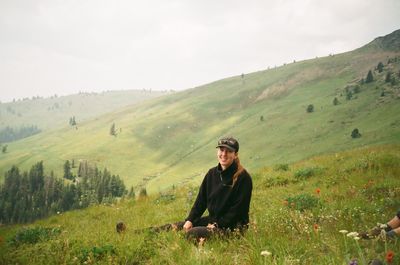
Abstract 106 - Conditioned Food Aversion with Odor Association: An Ethological Approach to Reducing Crop Damage and Bear-Human Conflict
Heather Havelock, Washington State University StudentSalon 8/9
Heather Havelock, Jazmin Gonzalez, Charles Robbins, Heiko Jansen
Nutrient-dense and convenient foods in crop fields represent well-known areas of conflict for
attracted bears. Human-bear conflict is imminent as weight gain is essential for bears entering
hibernation when sows produce cubs. Conditioned food aversion (CFA) is a form of behavior
modification based on a temporary yet unpleasant physiological response like nausea resulting
from ingesting adulterated food and an aversion to that food subsequently. CFA has been
combined with supporting stimuli such as odor (CFAO) to strengthen aversion in badgers but
not in bears. We hypothesized that CFAO could be effective in bears due to their reliability on
olfaction and memory when foraging. We tested CFAO in captive brown bears at Washington
State University using the aversive agent thiabendazole (TBZ) and odorant (lemon oil). Findings
showed that aversion was retained even after two hibernation periods with stronger aversion
in wild-born bears compared to captive-born bears, thus prompting proposed application in a
field setting. Testing stations containing apples, TBZ, and lemon oil will be placed on the
perimeter of Washington apple orchards and monitored via trail cameras and site visits. Similar
camera footage will be analyzed at control sites containing only apples and lemon oil. Line
transects of trees of orchards before testing station placement and after will be used to
quantify apple loss and tree damage. This nonlethal style of management for deterring bears
from specific food sources may result in fewer bear mortalities from conflict and reduce
economic loss for farmers.

Abstract 108 - Behavioral Characteristics of Autumn Migration in Solitary Terrestrial Mammals
Tamako Makino, Tokyo University of Agriculture and Technology StudentSalon 8/9
Tamako Makino, Seungyun Baek, Akino Inagaki, Naoki Takekoshi, Koji Yamazaki,
Shinsuke Koike
Migration is the periodic seasonal movement between remote areas of activity and there are
some differences depending on internal factors’ characteristic of individuals. About energy
spent, the movement between areas("commuting phase")is more demanding compared with
movement within the area("wandering phase"), especially for terrestrial mammals. Thus,
gregarious mammals that make annual migrations between fixed locations apply social learning
and memory for selecting energy-efficient(linear) paths. However, for solitary species, or for
species whose migratory behavior varies, the behavioral characteristic of migration is likely to
vary among individuals or years. Some black bears(Ursus thibetanus)("bears")migrate from late
summer to fall in years when locally hard masts are poor. This study aims to elucidate the
behavioral characteristic of autumn migration of bears. We used three factors: aging, number
of poor masting during the subadult period, and sex, to determine whether experience affects
the energy efficiency of commuting phase. 18 years of migration data obtained by attaching
GPS collars to bears in Ashio and Nikko mountains in Japan and 29 years of masting data on
Quercus crispula were used in this study. Analysis of data from 43 bear years(29 male
individuals)and 53 bear years(25 female individuals)demonstrated that bears migrated faster
and more linearly during the commuting phase than during the wandering phase and that
males migrated more linearly than females. In addition, with increasing age and the number of
poor masting experienced, the commuting paths of bears were more linear. One reason for this
is that with age, bears accumulate memory, thereby increasing the number of areas they have
traveled to and from. We think the experience acquired during the subadult period contributes
specifically to memory. A possible reason for the more linear migration of males compared with
females is that males are larger than females and as have greater mobility.

Abstract 120 - Hair, hormones and disturbance; a pilot study using a non-invasive approach to assess physiological function in free-ranging grizzly bears.
Kristenn Magnusson, Government of Yukon ProfessionalSalon 8/9
Kristenn Magnussom, Jodie Pongracz, Piia Kortsalo, Abbey Wilson, Sarah Michaud,
Karen Graham, Darío Fernández-Bellon, Gordon Stenhouse, Marc Cattet
Understanding how environmental drivers affect physiological processes in individual animals is
germane to forecasting how wildlife populations will tolerate environmental change. When
environmental conditions are within preferred ranges, physiological processes function without
excess energy demands. Beyond range thresholds, energy demands increase, tolerance
becomes time limited, and impairment of physiological processes is inevitable. As more
individuals exceed their thresholds, productivity and survival decrease at the population level
and eventually lead to a commensurate decline in abundance. In this pilot study, we are
measuring and comparing steroid and thyroid hormone levels in hair as an assessment of
physiological function in grizzly bears (Ursus arctos), using samples collected non-invasively
from two study areas, one with high anthropogenic disturbance in Alberta (36 bears) and other
from a relatively undisturbed, remote area in the Yukon Territory (41 bears). Our objectives are
to determine and compare hormone levels indicative of physiological processes (specifically
stress, reproduction, and energy metabolism) between study areas, and to evaluate specific
environmental variables as potential drivers of physiological processes. We identified unique
individuals and their sex by analyzing DNA extracted from hair follicles. Using a liquid
chromatography-multiple reaction monitoring/mass spectrometry metabolomics assay, we
determined the concentrations of 27 hormones in hair samples weighing as little as six
milligrams (20-30 hairs). Concentrations of specific hormones within five major hormone
classes differed significantly between study areas and between sexes. Temporal trends were
also evident for some hormones. For the next phase of our study, we are evaluating a suite of
landscape composition and disturbance measures as potential determinants of steroid and
thyroid hormone levels in hair and, more generally, physiological function in grizzly bears.

Abstract 122 - Assessing polar bear body condition via histological image analysis of adipose tissue
Gregory Thiemann, York University ProfessionalSalon 8/9
Gregory Thiemann, Melissa P. Galicia, Alyssa M. Bohart, Amélie Roberto-Charron,
Evan S. Richardson
Polar bear body condition (i.e., stored energy) is a crucial link between ecological conditions
and population demography. Reliable estimates of polar bear body condition are thus central
to understanding and predicting the consequences of climate warming. Many condition metrics
(e.g., isotopic dilution, body condition index (BCI), energy density) require live-capture and
immobilization. A subjective fatness index (FI, 1-5 scale) can be applied non-invasively, but
yields relatively coarse data. Adipose lipid content (ALC) is a condition metric based on the
understanding that fat cells (adipocytes) expand as fat is stored, increasing the proportion of
lipid in adipose tissue. It can be applied to live-captured and harvested bears and thus provide
data across large scales. However, ALC requires specialized equipment, expertise, and
potentially harmful chemicals. We developed and tested an image analysis protocol to directly
measure the size of adipocytes in polar bear adipose tissue. The process used standard
histological preparation and a widely available software platform. We compared histological
measurements of adipocyte size with other metrics of body condition for both live-captured
(tissue biopsied) and harvested bears. For all bears, adipocyte size was a better predictor of
body condition (assessed by FI) than was ALC. For captured bears, adipocyte size was a better
predictor of BCI than was ALC. Our results indicate that histological measurements of adipocyte
size provide a useful and reliable indicator of overall body condition in polar bears. Given that
samples can be prepared and analyzed relatively rapidly and inexpensively in commercial
laboratories, this approach offers a cost-effective method of monitoring body condition in polar
bears and likely other ursids. In jurisdictions where live-capture work is limited, harvest-based
sampling may offer the best means of detecting ecological changes in polar bears prior to
population decline.

Abstract 123 - Driving change: How do change-points in grizzly bear movement behaviour and measured landscape productivity correlate?
Jessa Marley, University of British Columbia, Okanagan StudentSalon 8/9
Jessa Marley, Rebecca Tyson, Michael Noonan
In animal movement ecology, studies often look first at the qualities of the environmental
landscape to interpret changes in movement behaviour patterns, for example by using step
selection analysis. But this method starts with the environment and looks for behaviour
switches second. Due to limitations in GPS data collection, the two or three dimensional nature
of movement, and impacting missing values, there is a gap in ecology for identifying change
points for movement strategies. We attempt to first identify points in time where animals
change their movement behaviour, and then look at the environment for characteristics that
maybe correspond to such changes and resulting patterns. The methods described are applied
to grizzly bear (Ursus arctos horribilis) telemetry data in south-western Alberta from 2001 to 2018. Such techniques could allow deeper insight into many species and the hidden forces
behind movement decisions.

Abstract 128 - Age estimation based on blood DNA methylation: A simple method applicable to multiple bear species
Michito Shimozuru, Hokkaido University ProfessionalSalon 8/9
Michito Shimozuru, Shiori Nakamura, Jumpei Yamazaki, Yojiro Yanagawa,
Nobutaka Sato, Yusuke Honda, Hideyuki Ito, Toshio Tsubota
Age is an essential information for understanding the ecology and management of bears. Age
estimation has been conducted by counting cementum annuli of the teeth, however, this
method is highly invasive as it requires tooth extraction. Recently, we have established age
estimation method based on blood DNA methylation levels in brown bears. The purpose of this
study was to clarify whether this method is applicable to other bear species. We collected blood
and extracted DNA from captive bears of known ages, including polar bears (17 bears, 20
samples), sun bears (8 bears, 10 samples), and Asian black bears (16 bears; 14 Japanese black
bears and 2 Himalayan black bears). We performed bisulfite pyrosequencing to obtain DNA
methylation levels at 4 cytosine-phosphate-guanine (CpG) sites adjacent to a single gene,
SLC12A5. High positive correlation between age and methylation levels of all 4 CpGs was found
in all three bear species. The application of brown bear age estimation model revealed that
mean absolute errors (i.e., the mean absolute values of the difference between the estimated
age and the actual age) was 2.22, 2.19, and 1.40 years, for polar bears, sun bears, and Asian
black bears, respectively. These values were comparable to those in brown bears (average
absolute error was 1.30 years), suggesting that the age estimation model established for brown
bears is commonly applicable to different bear species. The current study will contribute to
ecological research, conservation, and management of bear species.

Abstract 130 - Introducing the Bornean Sun Bear Conservation Research Project
Laura Saunders, Bornean Sun Bear Conservation Centre StudentSalon 8/9
Laura Saunders and Siew Te Wong
The Bornean Sun Bear Conservation Centre (BSBCC) located in Sabah, Malaysia operates
through five pillars: animal welfare, rehabilitation, education and outreach, ecotourism and
research. Although the centre offers optimal settings for research across multiple disciplines, it
has not yet been utilised. The Bornean Sun Bear Conservation Research Project aims to create
and deploy research projects across the remaining four pillars of BSBCC, to encapsulate
important social and behavioural information and to inform on-going conservation action of
sun bears in sabah. We aim for this project to be sustainable and include the centre's own staff
members who will plan, participate and conduct research practices, as a step towards
recognising ground researchers in research and authorship. Social research will look to
understand local Sabahan perceptions and folklore of sun bears which may advise future
education and outreach programmes. In addition, tourist perceptions of sun bears will be
examined across nationalities and may support future development of this and other eco-
tourism centres. Behavioural research will look to monitor the long-term progress of bears
across both the hard and soft rehabilitation methods, collaborating with the Tabin Sun Bear
Project, and will consider the role of personality, rescue background and human orientation to
observe such progress. Implications from such background research could help inform which
ages and years of undergoing rehabilitation may be optimal for successful soft releases. In
addition there will be behavioural research looking into captive bear feeding patterns,
enclosure utilisation and stereotypical behaviour, which will support the welfare maintenance
of non-releasable bears. Overall, the project aims to collect data across multiple disciplines to
gather enough information about Bornean sun bears to inform future conservation action
decisions in Sabah, Malaysia.

Abstract 132 - What can we learn about bear ecology using animal-borne video systems? A case study of Asiatic black bears in Japan
Shinsuke Koike, Tokyo University of Agriculture and Technology ProfessionalSalon 8/9
Prof. Shinsuke Koike, Tomoko Naganuma, Seung-Yun Baek, Kahoko Tochigi, Naoki
Takekoshi, Akino Inagaki, Koji Yamazaki
In recent years, animal-borne video cameras have been used to clarify the ecology of many
animal species. Over the past six years, we have fitted camera collars to several Asiatic black
bears. Here, we introduce two cases that were revealed using camera collars for four bears
(two males and two females) in early summer.
The first case is to compare the video analysis of foraging behavior with fecal analysis. We
found that using video analyses was advantageous for recognizing foods, such as leaves or
mammals, that were physically crushed or destroyed while bears chewed and digested foods,
which are difficult to identify to species using fecal analyses. In contrast, we found that camera
collars are less likely to record food items that are infrequently or quickly ingested. In addition,
food items with a low frequency of occurrence and short foraging time per feeding were less
likely to be detected when we increased the time between recorded clips.
The second case is to record the activities of wild bears during the mating season. All bears
were found to interact with other uniquely identifiable bears for some time (range 9–22 days)
during the deployment period (range 36–45 days), and multiple mating in males was
documented. Males and females exhibited different behaviors on social days (i.e., days when
the bear interacted with conspecifics) compared with solitary days (i.e., days with no observed
interactions with conspecifics). Compared with solitary days, the bears spent a lower
proportion of time on foraging activities and a higher proportion of time on resting activities on
social days.
Asiatic black bear inhabit in forests, so direct observation is not possible in almost situations.
Furthermore, the fields in Japan are steep and rainy, making field research difficult. Camera
collars are an effective tool for uncovering the unknown ecology of bears that inhabit such
environments.

Abstract 133 - The role of Asiatic black bears as a scavenger in a Japanese temperate forest
Akino Inagaki, Tokyo University of Agriculture and Technology StudentSalon 8/9
Akino Inagaki, Maximilian L. Allen, Kahoko Tochigi, Tetsuya Maruyama, Shinsuke
Koike
Animal carcasses are an ephemeral but nutritionally rich resource. Large carcasses attract
various vertebrate scavengers, and the interactions among scavenger species on or around
carcasses can influence the composition of the scavenger guild and its ecological functions (e.g.,
carrion consumption rates). Dominant scavengers, including American black bears (Ursus
americanus) and brown bears (U. arctos), usurp prey from predators and monopolize carcasses.
Despite Asiatic black bears (U. thibetanus) are one of the most frequent scavengers of sika deer
(Cervus nippon) carcasses in the temperate forests of Japan, their scavenging behavior remains
poorly understood. The aim of this study was to investigate the effect of Asiatic black bear
presence and seasonal variation (summer and autumn) on carrion consumption —specifically,
the number of visits and duration of feeding on deer carcasses— by other omnivorous
scavengers (wild boars [Sus scrofa], raccoon dogs [Nyctereutes procyonoides], red foxes [Vulpes
vulpes], and Japanese martens [Martes melampus]). We found that Asiatic black bears had
limiting effects on carrion consumption by all other scavengers, suggesting that bears create a
landscape of fear among scavengers as well as diminish available carrion largely. Additionally,
the potential probability for carcass visitation of bears decreased from summer to autumn,
suggesting a shift in carcass preference as bears transition their primary food source to acorns.
This shift may alter the magnitude of the limiting effect exerted by bears on other scavengers
according to seasonal variations. We highlight the importance of Asiatic black bears' role in
structuring the scavenger guild in this system.

Abstract 134 - Temporal Dynamics of Canine Breakage and Intraspecific Injuries in Western Hudson Bay Polar Bears (Ursus maritimus)
Simonne Tremblay, University of Alberta StudentSalon 8/9
Simonne Tremblay, David McGeachy, Nicholas J. Lunn, Evan Richardson, Andrew E.
Derocher
Canine teeth are essential components of carnivore anatomy as they are utilized in prey
apprehension and behavioural displays; however, this tooth type has high incidences of injury
which may reduce survival. Polar bears (Ursus maritimus) typically have polygynous mating
systems where males compete for access to females. Injuries, especially to the canines, are
frequent in these encounters and can be used as proxies for mating system dynamics. The
western Hudson Bay (WHB) subpopulation has been experiencing decline in recent decades
which may impact characteristics of their mating system. We examine the overall patterns of
canine breakages and its temporal dynamics within the WHB using field data from 1981-2023
(n=3493) through non-parametric statistical analyses and linear mixed effect models. We found
differing rates of mean breakage and coinciding intraspecific injury between males and females;
proportions of maximum breakage are similar between the sexes until approximately ten years
of age, where males then begin accruing more serious damage to their canines. The interactive
effect between the age of an individual and the year of observation was a significant predictor
in mean breakage suggesting that breakage is beginning to increase over time. The comparative
results of canine breakage occurrences and related injuries between the sexes reveal WHB
males to be under more intensive intraspecific pressures than females within the
subpopulation, which aligns with previous research regarding canine breakage and its use in
understanding mating systems of polar bears. The presence of a relationship between year and
canine breakage in both sexes suggests that there may be increased intraspecific competition
occurring within the subpopulation, however continued investigation into the temporal
dynamics is required as stronger causal relationships are likely to arise as decline continues in
the subpopulation.

Abstract 136 - Movement patterns of brown bears in a desert environment
Andreas Zedrosser, Mongolian Academy of Sciences, Institute of Biology StudentSalon 8/9
Delgerchimeg Dawaaasuren, Amgalan Luvsanjamba, Harry Reynolds, Jerrold
Belant, Andreas Zedrosser
The Gobi brown bear lives in the Great Gobi Strictly Protected Area A (GGSPAA), Mongolia, and
is considered the most endangered bear population in the world with a population size of ~40
individuals. The Gobi Desert has very few water access points, the shortest distance between
neighboring water points is ~100 km. The climate is harsh with very cold winters and very hot
summers (temperature range -31 to +40C) and very little precipitation. The main goal of this
study was to understand the activity patterns of bears living in a desert environment. We
captured and GPS-collared 19 bears (4 females, 15 males, 3-21 years old) in the core area of the
GGSPAA during 2005-2018. We defined activity as the straight-line distance between two
consecutive 24-hour GPS locations. Compared to the fall months, male bears were significantly
more active from March until the beginning of July, which coincides with the mating season. In
comparison, female activity was significantly higher during the period end of May until August,
which overlaps partly with the mating season but also with the onset of hyperphagia.
The mean monthly movement activity was similar among the sexes. The longest mean day
distances recorded in males ranged from 177 to 839 meters. The longest mean daily distances
recorded moved were over 42km during the mating season. Females showed mean daily
movement distances from 304 to 847 meters, and the longest mean daily movement distances
were over 26 km during the mating season.However, the home range size significantly differed
between the sexes, and male home range sizes increased from April to June, while female
home range remained the same during this time period. To our knowledge, these are the first
data on activity patterns of bears living in an extreme desert environment.

Abstract 137 - Current status of accidentally captured Asiatic black bears in traps for sika deer and wild boar in Nagano, Japan
Rumiko Nakashita, Forestry and Forest Products Research Institute ProfessionalSalon 8/9
Rumiko Nakashita, Akiko Takii, Hayato Iijima, Toshiaki Yamamoto, Hiroo Tamatani,
Misako Kuroe, Ryosuke Kishimoto, Shigeyuki Izumiyama
In recent years, the number of culled sika deer (Cervus nippon) and wild boar (Sus scrofa) has
increased as their abundance increased. The increased culling effort simultaneously resulted
in a rise in the accidental capture of non-target mammal species via snare traps and box traps.
In Japan, the protocol mandates the release of accidentally captured animals. However, for
some mammals, especially Asiatic black bears (Ursus thibetanus), this poses a serious problem
due to the potential risks against workers being injured during the release of the captured bear
and the bear itself also being injured by the trap. Nagano Prefecture is one of the regions
experiencing an increase in accidentally captured bears. However, the frequency of accidental
capture and behaviour of captured bears has not been properly understood by localities. In this
study, we examined the actual situations of Asiatic black bears caught by accidental trapping in
two areas in Nagano (Ina and Karuizawa) in recent years, and investigated attributes
of individuals which were accidentally captured. For those bears for which samples were
available, carbon and nitrogen stable isotope ratio analyses were conducted to determine the
diet of each bear. In the Ina area, many bears were trapped in box traps targeting wild boar
near corn-fields at the foot of the mountains, but only a few bears were found to be dependent
on crops. In the Karuizawa area, many bears were trapped in snare traps targeting sika deer in
national forests, and some of the individuals were captured repeatedly. Our study observed the
consumption of snared sika deer by bears, suggesting a potential link between bears learning to
eat snared sika deer and the accidental capture of bears in snare traps.

Abstract 139 - Non-invasive age estimation based on DNA methylation using hair in brown bears
Shiori Nakamura, Hokkaido University StudentSalon 8/9
Shiori Nakamura, Jumpei Yamazaki, Naoya Matsumoto, Kyougo Hagino, Hideyuki
Sakamoto, Masami Yamanaka, Mina Jimbo, Yojiro Yanagawa, Hideyuki Ito, Toshio Tsubota,
Michito Shimozuru
Age is a crucial factor in elucidating the ecology and management of bears. Recently, it has
been discovered that DNA methylation levels of certain cytosine-phosphate-guanine (CpG) sites
change with age, and they have begun to be used as indicators for age estimation in various
animal species. Previously, we have established an age estimation method based on blood DNA
methylation levels in brown bears. This method has the advantage of being less invasive and
simpler than the conventional tooth method, but it requires the capture of bears. Therefore, in
this study, we aimed to establish a novel age estimation method using non-invasively obtained
hair samples by identifying DNA regions where methylation levels change with age. Hair
samples were collected from captive and wild brown bears of known ages. The captive
individuals, kept at the Noboribetsu Bear Park, consisted of 27 bears (16 males and 11 females)
aged 2 to 31 years old, while the wild individuals included 8 female bears aged 8 to 25 years old
captured alive on the Shiretoko Peninsula, Hokkaido, Japan. Through bisulfite pyrosequencing,
we measured methylation levels of DNA extracted from hair roots in regions adjacent to 12
genes. Positive correlations were observed between age and DNA methylation levels in three
regions, and the best age estimation model was based on DNA methylation levels at two CpG
sites. This model demonstrated high accuracy, with a mean absolute error of 2.7 years and a
median absolute error of 2.4 years after leave-one-out cross-validation. These results suggest
that the age of brown bears can be estimated using the methylation level of hair root-derived
DNA as an indicator. Combining this novel tool with hair trapping survey, widely used for
population estimation, could allow us to non-invasively determine the age structure of wild
bear populations.

Abstract 140 - Sustainable management vs. bear conservation in Romania
Ovidiu Ionescu, Transilvania University of Brasov ProfessionalSalon 8/9
Ovidiu Ionescu, Georgeta Ionescu, Mihai Fedorca, Marius Popa, Ramon Jurj, Ion
Mirea, Ancuta Fedorca
Romania has the largest population of brown bears in Europe and the Carpathians (more than
6700 individuals). The species is considered by low public good of national and international
interest, administered by Romanian Ministry (MMAP). The management of the species is
ensured by the managers and game keepers of the wildlife management areas. Till 2007 when
Romania became member of UE the bear was a game species. From 2007 under Habitat
Directive bears became totally protected. Till to 2016, Romania hunted a maximum of 500
bears/year (<7% of the population) Important conflicts and compensations were reported in 5-
7 counties. After 2016, preventing harvesting was prohibited, and conflict and compensation
increased and were reported in 23 counties out of 26 with bear. The number of traffic accidents
increased more than 10 times in the last 8 years. The value of the compensations increased
dramatically as well as the number of people attack by bears. In recent years, the acceptance of
coexistence with the bears has decreased at the national level. The rate of acceptance
decreased mainly in the counties which were considered an example of good management and
have a high bear density.

Abstract 141 - Modify ethology in bear high densities area in Romania
Georgeta Ionescu, National Institute for Research and Development in Forestry Marin Dracea ProfessionalSalon 8/9
Georgeta Ionescu, Ovidiu Ionescu, Marius Popa, Ramon Jurj, Mihai Fedorca, Ion
Mirea, Ancuta Fedorca
In Romania is one of highest bear densities in the world. The average is 11 individuals/100km2,
of favourable habitats. 54% of the favorable habitat has bear densities higher than the national
average. The bear population in Romania registers a favorable conservation status, densities
that place it on the first places in the world, well above the optimal density, an exceptional
genetic variability similar to that of northern Canada and Alaska, and a productivity well above
the European average. It occupies all favorable natural habitats, moreover it is now found in
many completely artificial habitats and increasingly uses human food sources (domestic
animals, grains, fruit from orchards or backyards and honey from apiaries, along with
household scraps. Before 2016 about 90% of harvest consist of males. In 2016 preventing
hunting was stopped and only bears which were creating important economic damages or
attack people were removed from the population (killed or relocated). After 2016 bear
densities increased in the natural habitat and it was more and more difficult for the females to
protect the cubs. In our research area females with cubs where quite rare in high densities male
zones. In order to protect the cubs’ females were using anthropized habitats like agriculture
fields, villages and urban areas. Garbage, cornfields, orchards or livestock became important in
their diet. Cubs grow knowing that it is more food available in this zone and easier to be
procure. Practically they grow being habituated to human food resources. More and more
individuals appear in human dominated landscapes and out of their national habitat. They were
much more bold towards human presences and number of conflicts increase dramatically

Abstract 143 - First Trial of Semen Microbiome Analysis by Next-Generation Sequencing in Asiatic black bear.
Nari Kim, Chungbuk National University StudentSalon 8/9
Nari Kim, Kyung-Hyo Do, Ki-Yoon Kim, Kwang-Won Seo, Jeong-Jin Yang, Eui-Beom
Kyeong, Seung-Hyo Lim, Dong-Hyuk Jeong
Captive breeding, a global practice for endangered species conservation, faces challenges due
to reduced fertility among many captive individuals. While the reproductive microbiome has
been studied in animals like bulls and stallions to enhance fertility, no research has been
conducted on bears for conservation purposes. Therefore, this study aims to establish a
protocol for analyzing sperm microbiomes in Asiatic black bears (Ursus thibetanus) bred for
conservation in Korea and confirm their microbiome profiles through 16S Sequencing.
A total of 100µL semen was obtained via urethral catheter from an Asiatic black bear bred at
Korea National Park Research Institute. DNA extraction was performed individually using
aliquots of 5µL, 10µL, 15µL, and 50µL of semen. 16S V3–V4 amplicon libraries were prepared,
followed by sequencing on the Illumina MiSeq platform. The acquired sequences were
processed and analyzed using QIIME 2.
The 5µL, 10µL, and 15µL aliquots showed a total number of sequence reads exceeding 70,000,
which is sufficient for further analysis. The predominant phylum among semen bacteria was
Firmicutes (42.1%), followed by Bacteroidetes (35.0%). The most abundant genera were
Barnesiella, Eisenbergiella, Bacteroides, and Rothia, comprising approximately 45.7% of the
total semen microbiome.
Based on the results, we found that only a small amount of semen (5–15µL) is required for
microbiome analysis in Asiatic black bear. Given the challenge of extracting sufficient amounts
of semen in bears, the protocol has proven to be efficient for practical application. The bacterial
compositions of the three samples were aligned, demonstrating the protocol’s stability for
analysis.
This study represents the first attempt to establish a protocol for semen microbiome analysis in
bears. The application of this protocol to compare the reproductive microbiome of captive and
wild bears holds promise for enhancing Asiatic black bear fertility and species restoration.

Abstract 146 - The use of Karelian Bear Dogs (KBD’s) as a management tool to mitigate human-bear conflicts
Nanna Borgen, Inland Norway University of Applied Sciences StudentSalon 8/9
Nanna Borgen Scott Brainerd, Todd J. Brinkman, Nils Pedersen
Problem bears are often euthanized following multiple relocation attempts, even though non-
lethal bear management methods such as aversive conditioning (AC) can reduce human-bear
conflicts. Since the 1990s, a specialized aversion protocol based on principles of animal training
and conditioning has been used by wildlife managers in North America and Japan. The protocol
was developed by the Wind River Bear Institute and utilizes the Karelian Bear Dog (KBD), a
specialized dog breed traditionally used for hunting brown bears (Ursus arctos) in Finland. The
dogs shepherd wild bears by barking and chasing them and so conditions the bears to move
around or avoid human occupied space. Although this approach might be successful, conflicting
evidence suggest that the long-term efficacy might be conditional on variables such as time,
bear species or location.
The aim of this graduate project is to evaluate the effectiveness of the WRBI’s non-lethal
approach to mitigate human-bear conflicts from the perspective of KBD handlers. In
collaboration with a select experienced KBD handlers we will develop a questionnaire that will
be distributed to a large sample of practitioners. The questionnaire will gather the handler
experiences of bear management before and after employing KBD’s for AC. In particular, we will
assess if the application of KBD’s has reduced the need for lethal control of bears, and the
extent to which conditioned bears permanently have changed their behaviour.
This is the first study to evaluate the WRBI protocol as a non-lethal management tool from a
handler perspective. Conditioning bears to avoid conflict areas can have great conservation
benefits and as a non-lethal approach, it has the potential to benefit conservation efforts
wherever bears are present. Teaching bears to avoid human settlements and activities is only
one part of the equation, and public education on preventative measures may be equally
important in reducing human-bear conflicts.

Abstract 148 - BEARing with endocrine disruptors: potentially toxic metal(loid)s exposure in European brown bears
Agnieszka Sergiel, Institute of Nature Conservation of Polish Academy of Sciences, Krakow, Poland ProfessionalSalon 8/9
Maja Lazarus, Agnieszka Sergiel, Maja Ferenčaković, Ankica Sekovanić, Slaven
Reljić, Lana Pađen, David M. Janz, Ena Oster, Tomasz Zwijacz-Kozica, Filip Zieba, Nuria Selva,
Djuro Huber
Research addressing potential adverse effects of environmental pollutants on hypothalamic-
pituitary-thyroid (HPT) axis in ursids is crucial in assessing risk of adverse health effects. A
recent study reported alterations in circulating thyroid hormones in polar bears exposed
chronically to inorganic and organic pollutants. We obtained blood from 53 free-ranging
European brown bears (Ursus arctos; Carpathian and Dinara-Pindos populations) trapped
between 2014 and 2019 in order to investigate interrelationships among cadmium, lead, and
mercury, metals with known endocrine disrupting potential, other trace metal(loid)s, free
triiodothyronine (fT3), and free thyroxine (fT4). Ecological, physiological and sampling variables
were taken into consideration while building generalized linear models explaining hormonal
variation. The best model was validated using the corrected Akaike´s Information Criterion
(AICc). Chemiluminescent enzyme immunoassays quantified fT3 and fT4, which ranged <1-3.54
and <30-304 pg/mL, respectively. In top-ranked models, positive contributions of thallium,
sampling year and trap type explained 59-67% of fT3 concentration variation. Models
describing fT4 variation (44-66%) were explained by a positive effect of lead and negative
contributions of copper, selenium and capture day. Furthermore, age group and population
were shown to improve interpretation of fT4 concentrations. Based on these results and
established mechanisms of toxicity, we suggest that lead and thallium might indirectly affect
HPT axis of bears, potentially through enhanced production of reactive oxygen species,
depletion of thiol-rich proteins, or immune suppression. This study suggests that both essential
and non-essential trace metal(loid)s are important variables to be considered when studying
alterations in endocrine physiology in terrestrial wildlife.

Abstract 151 - Development of Assisted Reproduction Techniques for the Successful Restoration of the Asiatic Black Bear in Korea
Eui-beom Kyeong, Korea National Park Service ProfessionalSalon 8/9
Eui-beom Kyeong, Sook-jin Lee, Seung-hyo Lim, Ji-sang Yu, Ann-Na Lee, Min Kim,
Da-in Lee, Ho-nam Kang, Jeong-jin Yang, Dong-Hyuk Jeong
The Asiatic black bear (Ursus thibetanus) has been undergoing restoration in South Korea since 2004. Acquiring seed animals remains a challenge, hindering systematic project management.
Although population growth has occurred, limited genetic diversity is a concern due to
restricted male breeding participation. To address this, a combined approach of Ex-situ
breeding programs and in-situ reproduction was implemented to facilitate more strategic
population management and enhance genetic diversity. And here we describe what we have
done so far to establish artificial reproduction technology for Asiatic black bear. In females, we
analyze estrus patterns using ultrasonography, urinary hormones, and other biological
indicators. Urinary progesterone is a reliable predictor of ovulation. Indicators like external
genital size, follicular development, and vaginal cytology positively correlate with the estrus
cycle. Based on these indicators, we determine optimal timing for artificial insemination (AI)
using a ureteroscope for uterine semen injection. In males, we use ultrasound-guided urethral
catheterization to collect high-quality semen (concentration: 4,718.9 ± 1,526.1 x106/ml;
viability: 98.2 ± 2.3%). Five cubs were successfully born via AI from four females and released
into the wild. This represents a global breakthrough in Asiatic black bear artificial insemination.
Importantly, assisted reproduction technology (ART) extends beyond its scientific merits,
directly facilitating the conservation of endangered species through the release of ART-
produced offspring into their natural habitat. This study also provides one of the approaches to
address the difficulties of importing bears and increasing genetic diversity, which will aid the
restoration project and contribute to a sustainable bear population.

Abstract 156 - Boundary effects on Black bear (Ursus americanus) in Elk Island National Park
Fletcher Elliot, Parks Canada ProfessionalSalon 8/9
Fletcher Elliott, Ramona Maraj, Erin Henderson, Rachel Stapleton, Nolan Waters,
Mary McConnell, Emily Gavey, Michelle Hoang
Habitat loss and fragmentation is a major driver of ecological change. Protected areas of
pristine habitat with minimal human disturbance can become increasingly isolated through
habitat fragmentation to a point of unsuitability for wildlife. Elk Island National Park is the only
fully fenced national park in Canada. The fence was established to protect the elk and bison
herds from disease transmission and human-wildlife conflict outside the park boundaries.
However, it presents challenges to the many other species that use the park. While the fence
fully contains and prevents the movement of bison, elk and moose, we were interested to
understand the impact of the fence on a species that is vagile and capable of climbing. GPS data
was collected across two years from collars fitted to 11 individual black bears (Ursus
americanus), to investigate the effects of boundaries on the species movement. A model of
space use was developed, examining the effect of the fence and other linear features on the
black bears in the park. The different types of linear features (i.e., fence, parkway, highway or
township road) that was closest had a significant effect on the space use of black bears (F=
27.3494, p < 0.001), however the distance to the nearest boundary did not affect space use
regardless of barrier type (F = 2.0850, p = 0.15). Model fit and sampling bias are possible
limitations of the study that can be improved with further analysis and sampling effort.
Understanding the movement of black bears in an isolated patch of protected habitat such as
Elk Island is crucial to understanding the impact of the fence to landscape connectivity and the
preservation of the local population

Abstract 160 - American black bear habitat selection and movement in a gradient of industrial disturbance within the Athabasca Oil Sands Region of Alberta, Canada
Rebecca Paton, University of Alberta ProfessionalSalon 8/9
Rebecca A. Paton, Paul F. Frame, Scott E. Nielsen, Mark A. Edwards
Anthropogenic disturbances are expanding, which can affect wildlife species’ movement and
behaviour. Some wildlife species avoid anthropogenic disturbance while others adapt their
behaviour to coexist. The American black bear (Ursus americanus) is a highly adaptable bear
species that habituates to anthropogenic disturbance and capitalizes on human foods within
the urban-wildland interface. Bears alter their movement and behaviour in response to
anthropogenic disturbance, resulting in changes to seasonal and diel patterns. Bears in the
urban-wildland interface avoid more active disturbances, increase nocturnality, and reduce
movement rates. Well managed industrial disturbances are unique due to mandatory
workforce training and waste management practices that nearly eliminate common attractants
that contribute to human-bear conflict in the urban-wildland interface. However, while
industrial activities are also expanding in bear habitat, few studies have assessed bear
behaviour in relation to industrial disturbances. We investigated black bear movement, habitat
use, and activity patterns across a gradient of industrial disturbance in the Athabasca Oil Sands
Region of northeastern Alberta, Canada. Seventy-three black bears fitted with GPS collars were
monitored for 1–2 years to assess the effect of industrial disturbances on seasonal and
temporal movement rates, habitat use, and activity patterns by sex and reproductive class. We
estimated individual bear home ranges seasonally and report their overlap with industrial
disturbance, in addition to how movement and behaviour compared on and off disturbed sites.
We present these results and discuss management implications, as well as comparisons with
findings from urban-wildland interfaces.

Abstract 161 - Performance of fur- and ear-mounted satellite tags for evaluating the movement and behaviour of polar bears
Tyler Ross, York University StudentSalon 8/9
Tyler Ross, Gregory W. Thiemann, BJ Kirschhoffer, Jon Kirschhoffer, Geoff York,
Andrew E. Derocher, Amy C. Johnson, Nicholas J. Lunn, David McGeachy, Vicki Trim, Joseph M.
Northrup
The study of animal movement provides insights into underlying ecological processes and
informs analyses of behaviour and resource use, which have implications for species
management and conservation. The tools used to study animal movement have evolved over
the past decades, allowing for data collection from a variety of species, including those living in
remote environments. Satellite-linked radio and GPS collars have been used to study polar bear
(Ursus maritimus) ecology and movements throughout the circumpolar Arctic for over 50 years.
However, due to morphology and growth constraints, only adult female polar bears can be
reliably collared for long durations. Further, collars have proven to be safe and reliable but
there has been opposition to their use, resulting in a deficiency in data across much of the
species’ range. To bolster knowledge of movement characteristics and behaviours for polar
bears other than adult females, while also providing an alternative to collars, we tested the use
of fur- and ear-mounted telemetry tags that can be affixed to polar bears of any sex and age.
We also used data collected from the tags to quantify the amount of time subadult and adult
males spent resting versus traveling while on land. Our results show fur tags remained
functional for shorter durations than ear tags, but had comparable positional error estimates
and provided sufficient data to model different behavioural states. Further, as hypothesized,
subadult and adult male polar bears spent the majority of their time resting while on land, likely
as a means of conserving energy until the sea ice reforms in early winter. Fur tags provide
promise as a shorter-term means of collecting movement data from free-ranging polar bears.

Abstract 162 - A country divided: how barriers affect the gene flow of apex predator in Slovakia
Jana Šrutová, Charles University StudentSalon 8/9
Jana Šrutová, Nikola Tkáčová, Barbora Černá Bolfíková, Michal Kalaš, Mária
Apfelová, Dušan Romportl, Kristýna Vlková, Marián Hletko, Vladimír Antal, Slavomír Finďo,
Pavel Hulva
The brown bear (Ursus arctos) is currently the largest apex predator in Europe. This species
occupies an important position in ecological networks and is often referred to as a keystone,
umbrella, and flagship species. Like populations of other large carnivores, the European brown
bear population has been radically fragmented over the past centuries due to intensive hunting
and lack of protection. Based on more than 2,000 mostly non-invasive samples collected mainly
in the Western Carpathians between 2019 and 2021 and using a microsatellite panel, a
population structure that includes several genetic clusters was determined. This may be related
to the occurrence of refugia in isolated mountain ranges in Slovakia, which may have led to
genetic diversification of individual subpopulations. By linking landscape genetic and geographic
habitat modeling analyses, the main natural and anthropogenic barriers to gene flow were
identified. Currently, Slovak bear populations face not only natural barriers to gene flow related
to the sky island model, but also the increasing impact of anthropogenic barriers, which may
facilitate genetic differentiation. Examples include the construction of linear infrastructure in
valleys between orographic units and along major rivers. Populations that are geographically
close are thus genetically relatively distant. These findings can also serve as a basis in the
applied sphere for ensuring the viability of the population not only of the brown bear in
Slovakia.

Abstract 997 - Steps Toward Conserving Asiatic Black Bears at the Westernmost Extent of their Range: Preparing an Action Plan for Conflict Management in Kerman Province, Iran
Nahid Ahmadi, Borderless Wildlife Conservation Society, Iran; IUCN SSC Bear Specialist Group StudentSalon 8/9
Nahid Ahmadi, Ali T. Qashqaei, Pouria Ghelich Khani, Hamid Reza Heidari
Human–bear conflicts are a serious obstacle for the conservation of Asiatic black bears. Iran is
the westernmost range of this species, and conflicts are a major threat to both bears and
people. Asiatic black bears exist in 3 southern provinces of Iran, of which Kerman Province has
better habitats (food, water and cover) than Baluchistan or Hormozgan. With mounting human
pressures on habitat, we aimed to create a conservation action plan that will help to reduce
conflicts in Kerman Province. We collected data on conflicts between bears and people across
Kerman Province using 2 data sources: (1) a questionnaire survey of local gardeners,
beekeepers, shepherds and livestock owners (2019-2020); and (2) official reports registered
with various governmental organizations (1961–2019), along with interviews of government
managers and rangers. We could not verify or quantify the conflicts, but often local people
showed proof that they were attributable to bears. We mapped the occurrence of bear attacks
on humans, damage to orchards, damage to beehives, depredation of livestock, and killing of
bears. We also reviewed international articles and reports for lessons learned about bear
conflict mitigation elsewhere, and considered these with respect to the main stakeholder
conflicts in Kerman. We created a plan for short-term, mid-term, and long-term activities in 3
arenas: participatory conflict management; education; and research. The plan includes detailed
flow charts, showing priority activities tailored to specific types of conflicts, spatially matched to
where they are most prevalent. The plan has been reviewed and accepted by the Department
of Environment of Kerman Province.
This work so far has focused on the “assess”, “plan” and “networking” components of the
Species Conservation Cycle, as we prepare to launch into the “act” phase. The report has been
approved by the Kerman Department of Environment. Of particular interest, the data collected
so far revealed conflicts in some areas with no previous historical records of bear presence. We
will investigate these areas to verify the authenticity of these new accounts and to understand
what is occurring.

Abstract 177 - Influence of human disturbance on black bear (Ursus americanus) habitat selection
Erin Henderson, University of Saskatchewan StudentSalon 8/9
Erin Henderson, Ramona Maraj, Emily Gavey, Nolan Waters, Michelle Hoang,
Mary McConnell, Fletcher Elliott, Rachel Stapleton
Black bears (Ursus americanus) were extirpated from their historical home range in
southeastern Alberta, but have recently begun repopulating the area. Within the last 10 years,
black bears returned to the Beaver Hills Biosphere (BHB) in east-central Alberta, one of the last
remaining vestiges of the globally critically endangered aspen parkland ecosystem. The BHB is a
highly fragmented landscape comprised of agricultural, residential, and protected lands, with a
major east-west highway bisecting the Biosphere. Protected areas within the BHB have seen
higher visitation rates and bear sightings in recent years. High densities of humans living,
working, travelling, and recreating in the BHB alongside bears could lead to increased instances
of human-bear conflict as the bear population grows.
We assessed black bears spatial and temporal response to human disturbance in the BHB using
location data obtained from global positioning system collars deployed on 11 black bears from
2020-2023. We used a resource selection function to compare bear habitat use to
nonanthropogenic and anthropogenic variables, including land-use type (residential,
agricultural, protected), and intensity of road and trail use. We modelled diurnal and seasonal
(hyperphagia vs. hypophagia) changes in habitat selection in relation to changes in human
recreation use of protected areas. We also compared habitat selection within protected areas
to that outside of the protected areas. Identifying bears response to human disturbance will
allow partner agencies to develop and implement human-bear conflict management plans
targeted to areas of high human and bear use.

Abstract 181 - Effects of human activities on the denning behavior and reproductive success of brown bears
Baptiste Brault, University of Sherbrooke StudentSalon 8/9
Baptiste Brault, Jeanne Clermont, Andreas Zedrosser, Fanie Pelletier
Human activities have a profound effects on the environment, not only through their presence
in the landscape but also through the human induced climate change. Human influence forces
wildlife to modify their behavior, which can ultimately affect their fitness. For example, rising
temperatures and increase in human presence can alter the hibernation behavior of species
adapted to harsh winters, such as the Scandinavian brown bear (Ursus arctos). Changes in
hibernation phenology can affect individuals’ physical condition, reproductive success,
population dynamics, and frequency of interactions with humans. The aim of this research
project is to determine whether brown bears are adapting to environmental changes by
modifying their habitat selection, their use of different den types, and by changing the timing
and duration of denning. Ultimately, I will examine the effects of climate, human presence, den
type, and denning phenology on litter size. This study will consider the sex, age, and
reproductive status of bears tracked in Sweden over a 20-year period. This project will brin
insights on the ability of long-lived animals to rapidly adapt to environmental changes over time
and space while quantifying the importance of individual factors.

Abstract 183 - Effectiveness of different methods for non-invasive monitoring of grizzly bears
Darío Fernández-Bellon, fRI Research ProfessionalSalon 8/9
Darío Fernández-Bellon, Cameron McClelland, Gordon Stenhouse
Non-invasive sampling methods have long been a preferred approach for bear population
monitoring and conservation programs across the world. Despite their widespread use, limited
evidence is available on the effectiveness of different methodological approaches. In North
America, hair snag corrals baited with cow blood as a non-reward attractant have been widely
used as a means of non-invasive sampling for grizzly bears Ursus arctos. This method has
proved successful for developing population estimates, but some challenges remain: snag
effectiveness has not been quantified, the use of cow blood raises safety and logistic
difficulties, and determining whether samples correspond to single or multiple individuals is
challenging. Here we analyse data from two seasons (2023 and 2024) at 80 hair snag sites
(monitored by trail cameras) distributed over an area of 18,000 km2 in the foothills of the
Canadian Rocky Mountains. We tested (i) different hair snag site configurations, (ii) alternative
non-reward attractants, and (iii) different sampling periods and assessed their effectiveness for
both grizzly bears and black bears Ursus americanus. We found corral hair snag sites to have
high effectiveness compared to other methods (e.g., rub trees). Of 6 alternative attractants
tested, anise-based lures showed similar effectiveness to blood for attracting grizzly bears,
while fish fertilizer was the most effective attractant for black bears. Trail cameras indicated
that behaviours at the site also varied between species and across attractants. Temporal
variability in detections may reflect seasonal activity which can help inform optimal sampling
periods. Overall, these results can help optimize cost-effectiveness of ongoing and future
monitoring efforts.

Abstract 185 - Ending a centuries-old tradition of bear keeping in Czech castles
Eva Filipczykova, Czech University of Life Sciences in Prague StudentSalon 8/9
Eva Filipczykova, Bernd Nonnenmacher, Christopher Schmidt, Žaneta Křišťanová,
Aleš Vorel, Koen Cuyten
The state of Czech Republic currently keeps seven bears at four castle moats (the castles of
Český Krumlov, Konopiště, Náchod, and Točník), i.e. a tradition going back more than 500 years.
Bears in some of these moats live in very limiting conditions. Tourists, both international and
Czech, have been reporting a worrying state of the bears especially in moats of two castles, the
Český Krumlov Castle and the Konopiště Castle. The Český Krumlov Castle has a moat of about
850 m2, composed mostly of concrete, and inhabiting three brown bears. The Konopiště Castle
possesses a moat of about 150 m2 with one Asiatic black bear. Bears at these moats display
signs of stress, such as bear pacing, display of stereotypic behavior and obesity. Since 2015,
various international and local organizations have put pressure on the National Heritage
Institute (NPÚ), a Czech state institution responsible for the management of these castles, to
cease bear keeping in castle moats. In 2021, two NGO’s, Stiftung für Bären (Foundation for
Bears) and Bears in Mind, formed a coalition and started actively working towards a plan to end
the suffering of the castle bears in the Czech Republic. In early 2023, Stiftung für Bären started
a petition specifically addressing Český Krumlov Castle and UNESCO, which was signed almost
150,000 times. In June 2023, the coalition visited the Czech castle bears and had meetings with
stakeholders, such as the management of the Český Krumlov Castle, the NPÚ, and the local
NGO Obraz – Animal Defenders. The meeting with the Deputy Director of the NPÚ was
successful and we agreed on further steps aiming at gradually moving bears from all the Czech
castle moats to close-to-nature sanctuaries. The further steps include signing a Memorandum
of Understanding between the coalition and NPÚ, running a public education campaign, and
performing a social survey on general public opinion about this project and effectiveness of the
campaign.
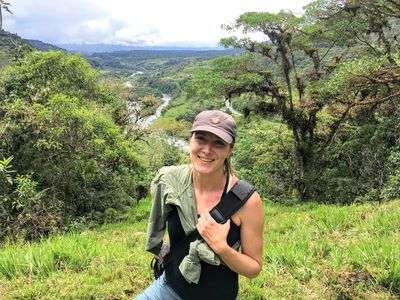
Abstract 188 - Polar Bear Maternal Care and Cub Development
Danielle James, San Diego Zoo Wildlife Alliance ProfessionalSalon 8/9
Danielle K. James, Jennifer R. Tobey, Lisa K. Lauderdale, Lance J. Miller, Megan A.
Owen
Given the conservation challenges facing free-ranging polar bear populations, conservation
breeding programs ex situ may become more relevant to the management of the species. Polar
bear neonates are highly altricial, and in den maternal care is required for cub survival and as
follows, population health. However, little is known about maternal care behavior and cub
development in the den as currently the technology to observe polar bears inside dens in the
wild does not exist, resulting in little baseline information about births and maternal care of
cubs prior to emergence. Thus, study of maternal denning polar bears in managed care can
provide valuable insights. We reviewed video recordings of polar bears in maternal dens from
three participating zoos to monitor maternal behavior and cub development. The study
subjects included three polar bear mothers with twin cubs, however each mother lost one cub.
Two cubs died within a few hours after birth and one cub was hand-reared nine days
postpartum. Only the remaining cubs were observed for this study. During a total of 366
observations, we collected behavioral data on both mother and cub during 30-minute
observation sessions spaced every four hours for the first 30 days post-partum. We recorded
mother-cub contact and individual behaviors for both the mother and cub including resting,
nursing, grooming, and other active behaviors. During the first ten days postpartum, cubs spent
60% of the time on mother, usually in a cradled position, and this behavior decreased to 44%
thereafter. Mothers and cubs spent most of the time resting, with mothers occasionally licking
and attending to their cubs, and these behaviors did not change over the postpartum period.
Cubs spent approximately 11% of the time nursing. More replicates from ex situ populations
will refine our understanding of how the denning environment, maternal care behavior and cub
development are correlated with cub survival, supporting population sustainability.

Abstract 190 - Andean bear tree selectivity for scent-marking in Ecuadorian cloud forests
Eva Filipczykova, Czech University of Life Sciences in Prague StudentSalon 8/9
Eva Filipczykova, Melanie Clapham, Russell C. Van Horn, Owen T Nevin, Jorge Luis
Armijos Barros, Aleš Vorel
Olfactory signaling is the most efficient mode of animal communication when the interval
between signaller and receiver is delayed. Scent-marking requires selective strategies to
increase the likelihood that these signals persist in the environment and are successfully
received. Bears are solitary, non-territorial carnivores, which scent-mark trees, substrate, and
other objects to communicate with conspecifics. Signallers place scent-marks on trees to
increase the detectability of their signals, possibly also to communicate their size and status.
While we are starting to better understand chemical signaling in bears of the northern
hemisphere, knowledge on tree selectivity for scent-marking and chemical signaling in general
of bears from tropical regions remains limited. We assessed scent-marking tree selectivity of
Andean bears, Tremarctos ornatus, in Ecuadorian cloud forests at two spatial scales: the
individual-tree level and at a local scale. We recorded characteristics of marked and unmarked
trees along bear trails (5.49 km in total) in the Eastern Cordillera of the Ecuadorian Andes, near
the Sumaco Biosphere Reserve. To decrease dimensionality and multicollinearity before
explanatory analyses, we performed Principal Component Analysis on data from 467 trees of 48
tree species. We then used Generalized Linear Models, model selection, and model averaging
to discover that Andean bears preferred rubbing leaning trees, aromatic tree species, and
hardwood trees with smaller and thicker leaves containing less nitrogen. Ten of 59 marking
sites contained clusters of marked trees, but site-level data did not indicate why bears marked
multiple trees at some sites but not others. We thus encourage further analyses of marked-tree
cluster sites and their relationship to productive food resources and reproduction, which might
present important communication hubs for ursids.

Abstract 196 - Assessing the habitat selection and distribution of polar bears (Ursus maritimus) and ringed seals (Pusa hispida) in the Last Ice Area using infrared video and aerial imagery
Roxanne MacLean, York University StudentSalon 8/9
Roxanne D. MacLean, Gregory W. Thiemann, Katie R.N. Florko, Steven H. Ferguson,
Kelsey F. Johnson, Christine Michel, David J. Yurkowski
The Arctic climate is warming roughly four times faster than the global average, causing a rapid
decline in the thickness and duration of sea ice. For ice-dependent species like the polar bear
(Ursus maritimus), the availability of suitable sea ice habitat is vital for important life processes
including movement and hunting of their preferred prey. Ecological studies of polar bears and
their prey in the Last Ice Area are limited due to the remote location, making it logistically
challenging to carry out traditional telemetry studies. The objective of this research was to
quantify the habitat use of polar bears and ringed seals (Pusa hispida) and model their
distribution in the Last Ice Area. We conducted aerial surveys to collect infrared video and
aerial imagery along transects, and used both remote sensing techniques to detect animals in
infrared video and manual detection of tracks on sea ice in aerial imagery. We quantified the
habitat selection of polar bears and ringed seals using resource selection functions to
determine the relationship between observations and habitat characteristics such as sea ice
cover, concentration, and distance from shore. Species distribution models were used to
predictively model the distribution of polar bears and ringed seals in this region based on the
observed locations and environmental covariates. This research is the first to quantify the
habitat selection and distribution of polar bears and their prey in the Last Ice Area of the
Canadian High Arctic, yielding novel insights into this understudied yet ecologically significant
area of sea ice habitat.
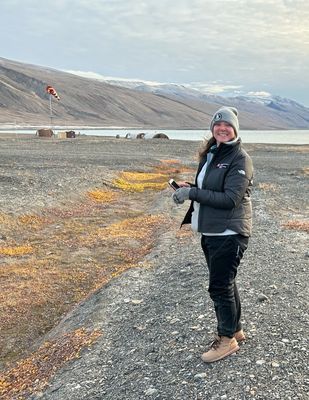
Abstract 197 - Arachidonic and docosahexaenoic fatty acids in brown bears brain tissue
Slaven Reljić, University of Zagreb, Croatia, Faculty of Veterinary Medicine, University of Zagreb, Croatia ProfessionalSalon 8/9
Lana Pađen, Agnieszka Sergiel, Djuro Huber, Slaven Reljić, Ivan Berečki, Jasna
Aladrović
The conditionally essential polyunsaturated fatty acids (PUFA), arachidonic acid (AA, 20:4n-6)
and docosahexaenoic acid (DHA, 22:6n-3) are predominant n-6 and n-3 PUFA in the mammalian
central nervous system. Since AA and DHA, as well as their respective shorter-chain precursors,
linoleic acid (LA, 18:2n-6) and α-linolenic acid (α-LNA, 18:3n-3), cannot be synthesized de novo,
they must be obtained from diet. The main sources of these for the wild brown bear are various
berries and nuts. Adequate brain concentrations of AA and DHA and interactions among them
and their metabolites are important for brain structure, function, and metabolism. The
amounts of AA and DHA, and whether they are changing seasonally in brown bears brain are
unknown. We aimed at determining FA using samples collected from 36 free-ranging brown
bears (11 females, 25 males) in Croatian part of Dinaric-Pindos population range during spring
and autumn in 2022 and 2023, while attending to human-induced mortalities. Samples of
medulla or pons regions were homogenized, total lipids extracted, and composition of FA was
determined by gas chromatography. Brain tissue in females and males comprised 6.1±2% vs.
4.8±2.1% AA and 7.7±3.8% vs. 7.2±3.8% DHA, respectively. Females in spring 2022 had
significantly lower levels of LA (4.95±0.06% vs. 10.9±1.8%) than in autumn samples of the same
year. Females in autumn 2022 had significantly higher level of DHA (11.4±2.2% vs. 5.4±2.2%)
than the same season in 2023. Male spring samples in 2022 had significantly higher LA
(8.6±3.6% vs. 2.2±2.6%) and DHA (8.7±3.5% vs. 4.9±2.6%) and significantly lower α-LNA
(1.0±0.6% vs. 1.6±0.6%) and AA (3.2±1.2% vs. 6.4±2.0%) than males in the same season in 2023,
while significantly lower AA (3.9±0.9% vs. 6.3±1.7%) in autumn 2022 than in 2023. This
preliminary study suggests that season, especially autumn period with hyperphagia, affects AA
and DHA levels and underline the importance of natural foods.

Abstract 202 - Genetic diversity, gene flow, and effective population size of the Selkirk and Cabinet-Yaak grizzly bear populations
Justin Teisberg, US Fish and Wildlife Service StudentSalon 8/9
Megan Turnock, Lisette Waits, Justin Teisberg, Wayne Kasworm, Matthew Falcy,
Michael Proctor
Genetic monitoring is important in fragmented populations, particularly in small populations
that rely on gene flow to maintain genetic diversity. Grizzly bear (Ursus arctos) populations in
the Selkirk (SE) and Cabinet-Yaak (CYE) ecosystems are the smallest in North America and are
near the southernmost extent of the species’ range. Both populations were isolated for
generations but have recently experienced gene flow through natural migration and a
population augmentation program. A long-term dataset of grizzly bear microsatellite genotypes
from 1973-2021 presented a unique opportunity to examine genetic trends in the SE and CYE
over time. We used this dataset of 464 bears to evaluate if gene flow affected observed
heterozygosity, expected heterozygosity, allelic richness, and average pairwise relatedness in
each of these populations. We also estimated effective population size using the temporal and
linkage disequilibrium methods. Post gene flow, allelic richness increased in the Selkirk and
Cabinet populations and r decreased in all three populations. We did not observe any changes
in expected or observed heterozygosity, but expected heterozygosity values in our populations
were significantly higher than those estimated in a model without gene flow. Our effective
population size estimates were consistent between the temporal and linkage disequilibrium
methods and ranged from 15.15-15.8, 15.35-19.3, and 5.6-8.7 for the Selkirk, Yaak, and Cabinet
populations, respectively. Overall, our findings indicate that gene flow is increasing or
maintaining genetic diversity in the SE and CYE. However, effective population size remains low
and additional connectivity or augmentation may be needed, particularly in the Cabinet
population.

Abstract 203 - Explaining recent increases of grizzly bears in central Alberta: Habitat dynamics, demographics, and translocation
John Boulanger, Integrated Ecological Research ProfessionalSalon 8/9
John Boulanger, Gorden Stenhouse, Scott Nielsen
DNA-based inventories of 2 bear management areas in central Alberta (east of Jasper and Banff
National Parks) conducted in 2004 and 2005 revealed low densities (<5 bears/1000 km2) of
grizzly bears. This prompted conservation actions, including a moratorium on hunting, as well
as research into demographic status and potential factors limiting these populations. DNA
inventories for these 2 areas were repeated in 2014 and 2018 revealing increases of 6-7% per
year in each area. We hypothesized that these increases were due to improvements in habitat,
reduced mortality, and recipients (immigrants) from translocations of bears. We used open
spatially explicit capture recapture models, demographic modelling, as well as modelling of
change in habitat to test which mechanisms best explain local patterns of increase. Supported
mechanisms include a net increase in ungulate habitat, higher survival rates, and transplants of
bears into one of the survey areas. We identified hotspot areas of increase relative to areas of
higher habitat value and potential mortality risk. We rank these mechanisms within the context
of management objectives. Our results provide an assessment of the most likely factors
influencing increases, as well as potential methodologies that can be used for continued
monitoring of these populations.

Abstract 204 - Being a female bear biologist in South America: The context and challenge for ”osologas”
Roxana Rojas VeraPinto, Proyecto Isnachi StudentSalon 8/9
Roxana Rojas-VeraPinto, Viviana Albarracín, Adriana Reyes
Women play an active role in the study and conservation of the Andean bear despite facing
challenges during their work related to gender stereotypes and physiological process. Our
research aims to promote the female bear community and their contribution to the knowledge
of the Andean bear. In 2022, we conducted an online survey with the female Andean bear
community. The questionnaire involved the characterization of this community and their work
experience. Then, we summarized women authorship within the literature related to the
Andean bear. We used bilingual keywords searches (English and Spanish) to find academic
theses, journals and IBA News publications from the 20th century to 2023. References were
classified according to the authorship gender and the publication themes. We received 13
replies which were principally women above 30 years old (n=11) with have at least one family
member under their responsibility (n=8). The majority have a degree in ecology or biology (n=8)
with a MS or PhD (n=8) and work principally for non-governmental institutions (n=8). Gender
inequality was a disadvantage for most respondents (n=9), because of the chauvinistic
perceptions or attitudes they received by local stakeholders. Despite these challenges in rural
contexts, the majority (n=8) of female do not feel undervalued by their colleagues. From the
literature review, we encountered 107 theses of which 65 (49 honor, 8 master and 8 doctorate
dissertations) were developed by women. Of particular note is that most doctorate theses
focused on Andean bears were developed by women (8 of 10) and the most common studied
theme was human-bear interactions (n=16). Female authorship was present in 125 from 223
scientific publications, and specifically 48 from 83 IBA News publications since 2002. The most
popular themes were captive bears in scientific publication (n=24) and conservation and
environmental education (n=21), respectively. We need to continue inspiring new students,
promoting the work of women, and tackling the significant challenges encountered in rural
areas.

Abstract 205 - Using Polar Bear (Ursus maritimus) Diet Estimates to Model the Effect of Climate Change on Arctic Marine Predator Body Condition
Griffin Finkbeiner, York University StudentSalon 8/9
Griffin Finkbeiner, Gregory W. Thiemann, Melissa P. Galicia, Alyssa M. Bohart
Arctic ecosystems have been disproportionately impacted by climate change, warming at a rate
four times faster than the global average. Polar bears (Ursus maritimus) rely on annual ice as a
platform to travel and hunt, and warming-driven loss of Arctic sea-ice represents a reduction in
optimal foraging area with subsequent impacts on predator-prey relationships. Phenotypic
responses to these environmental changes (i.e., phenotypic plasticity) may involve shifts in
foraging strategy, including the degree of specialization an individual may demonstrate. Dietary
specialization, where an individual demonstrates a narrower or altered foraging niche
compared to the overall population, is the response of an individual altering foraging behaviour
to maximize energy intake. The objective of this research is to develop a model for
understanding the drivers and consequences of dietary specialization on Arctic marine
predators in a warming climate. Using harvest-based sampling of two adjacent polar bear
subpopulations—Foxe Basin and Davis Strait—we will study the effect of long-term climate
warming on polar bear diet (composition and diversity) and body condition. Diet estimates will
be created using quantitative fatty acid signature analysis (QFASA), with adipose tissue lipid
content and subjective fatness index (SFI) scores being used as body condition indicators. We
hypothesized that environmental changes, including declining sea-ice levels, have promoted
sex-specific responses in adult polar bears, with increased specialization among males, where
females with better body condition will show a more generalized diet. The outcomes of this
research will provide valuable insights into the ecological impacts of climate warming on Arctic
marine predators, informing future conservation and management strategies. Moreover,
changes in polar bear diet specialization may serve as an indicator of food web connectivity and
health in the rapidly changing Arctic environment.

Abstract 208 - Japanese black bears are highly exposed to lead (Pb)
Koji Yamazaki, Tokyo University of Agriculture ProfessionalSalon 8/9
Koji Yamazaki, Mayumi Ishizuka, Shota Nakayama, Nelly Banda, Shinsuke Koike,
Yusuke Goto, Kozo Yamazaki, Yui Nemoto, Boris Fuchs, Jon M. Arnemo
We collected blood samples from a total of 57 Asian black bears (Ursus thibetanus) that were
live-trapped in two study areas. The Okutama Mountains are situated in the suburbs of Tokyo, a
mega-city where the use of leaded gasoline was permitted until 1980s. The Ashio-Nikko
Mountains are located near an old copper mine and smelter. In both areas, extensive sika deer
(Cervus nippon) and wild boar (Sus scrofa) control programs and sport hunting using lead (Pb)
ammunition have been ongoing for decades.
We found that blood Pb concentrations (mean±SD) were higher in the Ashio-Nikko Mountains
(107.62 ± 29.94 µg/L) compared to the Okutama Mountains (54.27 ± 35.65 µg/L).
Pb levels of females with lactation were higher than other sex categories, and the increase in Pb
levels was associated with a significant decrease in blood lymphocyte and monocyte counts. In
bears sampled over multiple years, Pb levels showed an increasing trend.
Bears in central Japan are known to scavenge on carcasses and hunting remains of sika deer
and other large-sized mammals. Pb from spent ammunition may constitute a significant
portion of Pb exposure in the bears in both areas. In the Ashio-Nikko Mountains mining
activities are likely a major source of environmental Pb, whereas the Okutama Mountains are
more contaminated by Pb from leaded gasoline.

Abstract 209 - The effect of season and latitude on the body mass of eight bear species in human care
Russell Van Horn, San Diego Zoo Wildlife Alliance ProfessionalSalon 8/9
Russell Van Horn, Anthony M Pagano, Mathias W Tobler
Many ursids exhibit significant changes in metabolism and body mass in response to
environmental and seasonal factors. In some ursids, these seasonal effects can include
extended and predictable periods of inactivity or torpor. In turn, those changes can affect the
timing of challenges to these bears’ management and conservation. Yet, in other ursids (e.g.,
sun bears, sloth bears), the existence or magnitude of such seasonality is poorly known. We
used records of body mass from eight bear species in human care within the Species360
Zoological Information Management System (ZIMS) to evaluate the effects of season and
latitude on overall body mass and change in body mass. This dataset encompassed 66,598
records from 1000 adult bears between 1980 – 2023 encompassing latitudes from -41 – 66°.
Andean bears in human care of both sexes exhibited significant decreases in body mass with
increasing latitudes (i.e., distances from the equator). Conversely, male Asiatic black bears and
female polar bears exhibited significant increases in body mass with increasing latitudes.
Female brown bears and giant pandas of both sexes exhibited significant increases in overall
changes in body mass across months of the year with increasing latitudes. Other species and
sex classes showed no relationship between overall body mass or changes in body mass with
increasing latitudes. These data provide insight into the capacity of different ursids to
seasonally vary their body mass and the influence of latitude on body mass. Additionally,
Andean bears exhibited the most pronounced sexual dimorphism in body mass, followed by
brown bears, black bears, and polar bears, with sloth bears exhibiting the least dimorphism.
Such variation in dimorphism across species may reflect sexual selection, leading to variation in
foraging requirements. Data from other bears in human care beyond Species360 would allow
us to more thoroughly evaluate the influence of season and latitude among ursids.

Abstract 212 - Occupancy monitoring of Andean bears in the North Tiquipaya Municipal Wildlife Reserve in Cochabamba, Bolivia.
Andrea Fuentes, Vida Silvestre NGO StudentSalon 8/9
Andrea Fuentes and Sara Flores
Andean bears (Tremarctos ornatus) are the only bear species that lives in South America
distributed throughout the Tropical Andes, one of the most diverse ecoregions and strongly
threatened by constant population growth and habitat fragmentation. Although many
protected areas in Bolivia align with the distribution of this species, most of them need
effective tools to understand local dynamics between bear populations and human activities
that could lead to human-bear conflict. This is the case of the North Tiquipaya Municipal
Wildlife Reserve, located at the lower limit of Conservation Unit 5 of the Andean bear (Wallace
et al., 2014). We present progress on monitoring the occupancy of Andean bears in the
Municipal Reserve and key local factors that could affect the probability of occupancy of the
species in the area. This information will contribute to greater efforts throughout the region to
increase knowledge about Andean bear populations. In addition, it will help design effective
livestock management interventions with local communities, since occupation has great power
to detect changes.

Abstract 213 - The Efficacy of Locating and Monitoring Arboreal Black Bear Dens with a Hand-Held Thermography Camera
Craig Perham, US Bureau of Land Management, Alaska State Office ProfessionalSalon 8/9
Craig Perham and Craig Townsend
Protocols for detecting and verifying arboreal black bear (Ursus americanus) dens using a hand-
held, infrared (HH IR), thermography camera system were developed to understand black bear
use of riparian habitat in an urban park in southcentral Alaska. We categorized descriptive
characteristics of black cottonwood (Populus trichocarpa) trees to consider when identifying
individual trees that could be used as arboreal bear dens. These included tree diameter,
functional height, bear activity, and trunk shape (i.e., tapered).
We also documented thermal camera variables when using a HH IR camera system to identify
active, arboreal black bear dens, such as appropriate environmental conditions, survey timing,
and camera system limitations and advantages. Hand-held infrared camera systems can be
used for initial den detection surveys as well as assessing current occupancy of historical den
trees. HH IR camera systems can also be used to monitor occupied dens to help minimize
potential human-bear interactions.

Abstract 214 - Mating behavior and site selection of Asian black bear in Japan
Tomoko Naganuma, Obihiro University of Agriculture and Veterinary Medicine ProfessionalSalon 8/9
Tomoko Naganuma, Seung-Yun Baek, Kahoko Tochigi, Naoki Takekoshi, Chinatsu
Kozakai, Koji Yamazaki, Shinsuke Koike
The mating behavior of Asian black bear (Ursus thibetanus) has been limited on observations of
captive populations. Hence, the habitat use and behavior during courtship of free-ranging bears
are poorly understood. Animal-borne camera systems (i.e., cameras attached on animals)
provide novel tools to study the behavior of elusive animals. Here, we used a video camera
integrated with a GPS collar to record the behaviors of free-ranging bears during the mating
season (May-July). During the mating season, collars were deployed on seven adult bears (five
males and two females) captured in Ashio-Nikko Mountains and Okutama Mountains, central
Japan. The video and GPS data were then downloaded from the collars and analyzed in terms of
mating behavior. All the bears were found to interact with other uniquely identifiable bears for
some of the times (range 9–26 days) during the deployment period (range 26–64 days), and
multiple mating in males was documented. Both males and females exhibited different
behaviors on social days (i.e., days when the bear interacted with conspecifics) compared with
solitary days (i.e., days with no observed interactions with conspecifics). Compared with solitary
days, the bears spent a lower proportion of time on foraging behaviors and higher proportion
of time on resting behaviors on social days. Our findings suggest that Asian black bears reduce
their foraging behaviors on social days and engaged more in social interactions. Also, we will
show the results of habitat use analysis to elucidate the relationship between the
characteristics of bear mating sites and their behavior, which may provide insights into the
behavioral patterns related to the mating habitats.

Abstract 216 - Human dimensions influencing brown bear attractant securing behavior in suburban kitchen gardens in Sapporo, Japan
Taiki Ito, Hokkaido University StudentSalon 8/9
Taiki Ito and Tohru Ikeda
In Hokkaido, northern Japan, brown bears are appearing in urban areas and causing human-
bear conflicts. One reason for bears to appear in human settlements is their attraction to
anthropogenic food sources. Therefore, reducing bear access to anthropogenic food sources,
especially kitchen gardens (KGs) is essential for effective urban bear management. However,
the adoption of preventive measures, such as the use of electric fences, may be hindered by
social and psychological factors among residents. This study explores the factors influencing the
use of electric fencing through interview and questionnaire surveys conducted in KGs in
Sapporo, Japan, which was selected as the study area due to the high incidence of human-bear
interactions in its suburban regions. First, semi-structured interviews were conducted with KG
owners to explore the factors influencing their decision to use or not to use electric fencing.
The results highlighted many factors that led to non-use of electric fences, including cost
considerations, the need for significant labor and concerns about the dangers posed by electric
fencing. This was followed by direct observations to determine the prevalence of electric
fencing in the KGs, which revealed that electric fencing was consistently used in 20.0% of the
KGs observed. Finally, a questionnaire survey was conducted to investigate the social and
psychological factors influencing the use of electric fencing in KGs. Our results showed a lower
incidence of crop raiding by bears in the study area; however, many participants expressed
concerns regarding potential crop raiding and bear encounters. Furthermore, negative attitudes
toward electric fencing (cost, labor, danger of electric fences) can discourage and risk
perceptions of bear can encourage the use of electric fences. Focusing on social and
psychological factors may promote the introduction of electric fences in KGs to decrease
human-brown bear conflicts around urban area in Sapporo city.

Abstract 217 - Aversive conditioning increases short-term wariness but does not change habitat use in black bears associated with conflict
Colleen Cassady St. Clair, University of Alberta StudentSalon 8/9
Lori Homstol, Sage Raymond, Claire Edwards, Anthony N. Hamilton, Colleen
Cassady St. Clair
Conflict between humans and black bears (Ursus americanus) occurs throughout North America
with increasing public demand to replace lethal management with non-lethal methods, such as
aversive conditioning (AC). AC aims to teach animals to associate negative stimuli with humans
or their infrastructure. We sought to test the efficacy of AC using radiocollared black bears in
Whistler, British Columbia, by monitoring individuals and assigning those in conflict with people
to control or treatment groups. We measured wariness using overt reaction distance,
displacement distance, and reaction to researchers before, during and after executing 3–5-day
AC programs that consisted of launching projectiles at bears in the treatment group. We also
assessed predictors of successful AC events (i.e., leaving at a run), changes in bear use of
human-dominated habitat during the day and at night, and the effects of including a sound
stimulus to signal the beginning and end of AC events. Among treated bears, overt reaction
distance increased by 46.5% and displacement distance increased by 69.0% following AC
programs, whereas both overt reaction distance and displacement distance decreased over
time among control group bears. Each additional AC event during the previous 30 days
increased likelihood of bear departure in response to researcher presence by 4.5%. The success
of AC events varied among individuals, declined with distance to cover, and increased with
exposure to previous AC events. Projectiles launched from guns were slightly more effective at
causing bears to displace compared to those launched from slingshots, and sound stimuli
decreased the likelihood of a successful AC event. AC did not alter diurnal use by bears of
human-dominated habitat. Our results suggest that AC increases short-term wariness in black
bears but does not alter bear use of human-dominated spaces, highlighting the importance of
proactive attractant management and prevention of food conditioning.

Abstract 222 - Do animals use bear marking sites? A potential role for inter- and intra-specific communication by non-bear mammals
Hinako Katsushima, Hokkaido University StudentSalon 8/9
Hinako Katsushima and Itsuro Koizumi
Some mammals have conspicuous marking sites, such as rubbing trees of cheetahs and
communal latrines of otters. While such marking sites are considered to play important roles in
intraspecific communication, such odor or visual information may be used by other mammals
as well, for example, to detect potential predators. To investigate the potential roles of bear
marking sites for inter- and intra-specific communications by non-bear mammals, we evaluated
their behaviors at marking and control sites by camera trapping survey in Hokkaido Island,
northern Japan. During the study period, infra-red cameras set at brown bear rubbing trees and
control trees recorded over 3000 movies of 8 non-bear mammal species. Sika deer, common
prey species of brown bear, had fewer visiting events at the marking sites than control sites,
but they often smelled bear marking points when they visited. This may be a behavior assessing
the presence of potential predators and likely to reduce encounters with bears. Another
interesting behavior was rubbing of bodies by red foxes, competitively subordinate carnivore
species, at the same point as bear rubbing. They might have put bear’s odors on their bodies for
some reasons, like chemical camouflage. Foxes also made more sniffing and marking events at
the marking sites than control sites, perhaps to use for intra- or inter-specific communication.
Red squirrels made more sniffing event at bear marking sites than control sites. This may be an
anti-predator strategy for gaining information about bears. Other competitively subordinate
carnivore species that are rarely preyed by bears also marked at marking sites but at the same
frequency as control sites. Therefore, their use of bear marking sites would not be particularly
selected and the reason is likely for intra-specific communication rather than inter-specific
communication. Collectively, we suggest that bear marking sites are used by many other
mammals for inter- and intra-specific communication.

Abstract 228 - Verification of the relationship between testosterone and behavioral changes in male Asian black bear (Ursus thibetanus)
Naoki Takekoshi, Tokyo University of Agriculture StudentSalon 8/9
Naoki Takekoshi, Jumpei Tomiyasu, Yojiro Yanagawa, Naoki Ohnishi, Tomoko
Naganuma, Seungyun Baek, Miu Itoh, Tatsuhito Nishiwaki, Chinatsu Kozakai, Shinsuke Koike,
Koji Yamazaki
Sexual hormones play a crucial role in reproductive behavior of mammals. Testosterone, a type
of sexual hormone in males, exhibited closely linked to competition among males for access to
female in previous study, which applied direct observation and fecal samples containing
testosterone metabolites. In case of the Asian black bear (Ursus thibetanus), males typically
approach females and remain in proximity in a small area. While direct observation allows for
accurate behavior recording, it is difficult to keep observing over extended periods. In this
study, we investigated fecal testosterone metabolites (FTM) and behavior with global
positioning system (GPS) collar of Asian black bears, to clarify the potential role of sexual
hormones as behavioral factors for male bears. We hypothesized that FTM concentration in
male bears would increase with (1) longer movement distance to encounter more females, or
(2) shorter movement distance to ensure mating with limited females. We fitted GPS collars to
males for calculating their daily distances. For collecting fresh feces for FTM assay, we targeted
sample collection based on cluster of GPS points received via satellite in semi real-time. We
gained GPS points from 5 males and collected a total of 297 feces from 2022 to 2023. FTM had
temporary high concentration, mainly during the reproductive season (May-July), although
some male bears elevated concentrations after the reproductive season (August-October). The
movement distance was negatively related to FTM concentration but those were not significant
in reproductive season. These findings do not exhibit the tendency clearly, but may seem that
testosterone level rise when male bears engage courtship behaviors with females. This study
provides the first insight of the relationship between movement distance and testosterone
levels for males through bear active season.

Abstract 237 - A time-series analysis of dynamic changes in the gut microbiome of the giant panda traveling to Japan
Xueying Wang, Hokkaido University StudentSalon 8/9
Xueying Wang, Ryoji Umemoto, Mizuki Kato, Takashi Hayakawa
Giant panda (Ailuropoda melanoleuca) is one of the most famous mammals known for its
unique biology. They phylogenetically belong to the family Ursidae (bears) and, therefore, have
a carnivore-like gastrointestinal tract. However, bamboo is the principal dietary resource for
giant pandas, which is highly fiber-rich and poorly nutritional. Giant panda genome has no
homologs of the cellulase digestive gene, indicating that their bamboo diet may rely on the gut
microbiome.
Giant panda is a vulnerable mammal according to the IUCN Red List of Threatened Species.
They have an extremely narrow range of natural habitats. Human activity has drastically
reduced and fragmented their habitat range. The restricted gene flow in wild populations made
it difficult to maintain genetic diversity within small populations. For this reason, ex situ
conservation of giant pandas has been important. The number of captive pandas now
represents over one-quarter of the total number of worldwide pandas. Therefore, focusing on
the gut microbiome of captive giant pandas will support their healthy condition and contribute
to their successful reintroduction into the wild.
To expand the genetic diversity of captive populations, breeding loans have been implemented
between breeding facilities, including Japanese zoos. Yet we have not sufficiently investigated
the gut microbes in pandas traveling to Japan.
To understand how Japanese husbandry environments affects the gut bacteria in the giant
panda, we continuously collected fecal samples from an adult panda at the Kobe Oji Zoo (Kobe,
Japan) once a week from May 2021 to the present. The composition of the gut bacteria in giant
panda was identified using the 16S ribosome RNA gene sequencing. A time series analysis of
the gut bacteria dynamics in giant pandas over years will be conducted.

Abstract 241 - The brown bear (Ursus arctos arctos) in Romania - coexistence and sustainable management, a real challenge in a dynamic of habitat modification
Ramon Jurj, National Institute for Research and Development in Forestry Marin Dracea - Romania ProfessionalSalon 8/9
Ramon Jurj, Georgeta Ionescu, Ovidiu Ionescu, Ancuta Fedorca, Mihai Fedorca,
Marius Popa, Constantina Jurj
Romania, at European level, represents the country with one of the biggest challenges
regarding the management of the brown bear species, a challenge consisting in excessively
protecting the species (principle supported by non-governmental organizations and animal
lovers in big cities) to the direct detriment of traditional anthropogenic activities or in
preserving the species for sustainable use with social benefits, long-term ecological and
economical environment (principle supported by wildlife managers and the majority of the
rural population).
A bear population has been steadily increasing over the past 50 years, both in number of
individuals (from 3700 bears in 1974 to 8000 bears estimated in 2023) and in used habitat
(from 28,000 km² to 71,850 km²), without active management based on sustainable use of
brown bear species, we believe that the risk that human acceptance will be significantly
reduced and that the long-term species will also suffer.
In the last 20 years, socio-economic development has grown in various sectors: transport,
construction, tourism, forestry, and agriculture. The accelerated development of various
activities and land use changes in some areas (land conversion, linear infrastructure, touristic
and communication infrastructure) have led to a decrease of the bear's natural habitat while
the expansion of anthropogenic activities have increased into the species’ movement areas.
Analyzing the evolution of human-bear conflicts in the last 20 years (311 people injured, 28
people killed). In line with the evolution of distribution and the number of bears in Romania, we
can say that the challenge remains in the hands of the decisions of the authorities that make
environmental policies both at European and national level.
Our results showed that in areas where bear presence near human settlements was a historical
habit, the communities tend to have a higher acceptance for bear species than the
communities in which bear presence is new.

Abstract 254 - Exploring Bear Attacks Through an Evolutionary Lens
Tom Smith, Brigham Young University, Provo, UT, USA ProfessionalSalon 8/9
Tom Smith, Thomas Sharp, Vincenzo Penteriani, Russ Van Horn
In this paper we explore both the ultimate and proximate causes responsible for the ways in
which the eight extant bear species respond in interactions with humans. A brief review of
these bears’ evolutionary histories is presented, with an emphasis on behavioral adaptations
resulting from environmental forces including competitors, predators, and habitat. We also
present each species’ relationship to humans with respect to distance-dependent responses
and predation. A better understanding of how bear behavior has been shaped over millennia
helps us to create more effective policies for bear management and safety.

Abstract 256 - Sloth bear as a key contributor to forest heterogeneity in India through seed dispersal
Ashutosh Anand, Department of Forestry, India StudentSalon 8/9
Ashutosh Anand, Ajay Kumar Singh, Nishith Dharaiya
Seed dispersal is a critical ecological process that influences the composition and heterogeneity
of forest ecosystems. The sloth bear has emerged as an important species in maintaining forest
heterogeneity through its role as a seed disperser. Here we review the literature on the role of
sloth bears in seed dispersal and maintaining forest heterogenity, with a literature search in the
online reference database such as scopus, researchgate, google scholar etc. Overall, we found
that sloth bears are prolific seed dispersers. Their diverse diets allow them to consume large
volumes of over a twenty families of fruit and disperse large quantities of seeds across
landscapes. We examined the prevalence of observed and potential endozoochoric seed
dispersal by them. The wide-ranging habitat capabilities of sloth bears contribute to the
colonization of new habitats and the establishment of diverse plant species. Selective feeding
preferences further aid in the distribution of specific plant species, enhancing the heterogeneity
of forest ecosystems. We found that several tree species benefit from the seed dispersal
activities of sloth bears in different regions of India. Ficus spp., Cassia fistula, Diospyrous
melanoxylon etc. are widely dispersed by sloth bears in central India aiding in its distribution
across different forest regions of Marwahi, Satpura, Bandhavgarh. Ziziphus spp., Aegle
marmelos, etc in eastern India and Syzizium cumini, Diospyrous melanoxylon, Madhuca indica
etc in western India are dispersed by sloth bears, ensuring its presence in various forest
ecosystems.

Abstract 257 - Coexistence at the top of the food chain: anthropogenic risk primarily drives brown bear space use and resource selection in the Italian Alps
Andrea Corradini, Fondazione Edmund MachSalon 8/9
Andrea Corradini, Benjamin Robira, Luca Pedrotti, Clara Tattoni, Natalia Bragalanti,
Claudio Groff, Marco Ciolli, Francesca Cagnacci
The Italian Alps are among the most anthropized mountain areas in the world. In a multi-use
landscape where a variety of activities such as farming, livestock herding, hunting, and outdoor
recreation take place, large mammals must adjust their behavior to carry out their daily
activities. The brown bear, the largest carnivore in the Alps, was recently rescued from near
extinction and must now find its place in a complex, human-dominated landscape. In this study,
we use individual-based movement, activity and trait information (spanning from 2006 to 2019)
to assess multi-scale behavioral decisions related to the perception of risk, the availability of
habitat, and the proximity of food resources. Perceived risk from human activities was found to
influence spatial and temporal patterns of selection across scales more than other attributes.
Spatially, brown bears reduced risk exposure when selecting for home ranges and resources
within those ranges by avoiding humans, at the cost of limiting their selection of high-quality
habitats and high-calorie food sources. Temporally, intraspecific competition was identified as
the main determinant of activity patterns and daily movement length over the years, while
human disturbance had a major effect on movement behavior on a daily (day vs. night) scale.
Brown bears in the Alps are slowly recovering, but competition for space with humans, lack of
habitat connectivity, and human-caused mortality are hindering their recovery and the
formation of a viable metapopulation throughout the Alps. In the increasingly crowded Alps,
sustainable long-term coexistence can be achieved only if both bears and humans adjust their
behaviors.

Abstract 265 - Invitation to Participate: An experimental comparison of expert elicitation data and empirical data of American black bears
Darcy Doran-Myers, University of Florida StudentSalon 8/9
Darcy Doran-Myers and Conor McGowan
Expert elicitation is increasingly used in ecology to fill data gaps. The reliability of expert
elicitation as a source of data is seldom verified, but it is pivotal for credible research results.
This presentation is an invitation to participate in a USFWS-backed study designed to test the
accuracy and precision of expert judgments in ecology. The goal is to externally validate the
reliability of expert judgments and to investigate the factors affecting data accuracy. The
American black bear and its species experts is an ideal study system for this purpose because of
the bear's extensive range, decades of empirical research using consistent methods, and the
availability of numerous knowledgeable experts (you all!).
Invitation #1: I am compiling a large dataset of existing black bear genetic mark-recapture
datasets. I ask willing conference attendees to contribute data to this effort. By aggregating
existing datasets, I aim to generate comprehensive estimates of key parameters, such as
population abundance and survival rates, informed by various environmental factors. These
estimates will serve as a benchmark to evaluate the performance of expert judgments.
Invitation #2: I am recruiting black bear experts across the species range to serve on expert
panels. The call for participation extends to the broad spectrum of black bear specialists, at all
career levels, to ensure a diverse and representative sample. Experts will be asked to share
their expertise and provide estimates of local, regional, and range-wide parameters through an
initial survey, two rounds of online elicitation, and one round of online discussion.
Your participation will help to enhance our understanding of expert elicitation data in ecology,
thereby influencing the future of ecological research methods. You may personally benefit
through data acknowledgement, co-authorship where appropriate, and a better understanding
of black bear populations at large scales and your own species knowledge.

Abstract 267 - Landscape connectivity modelling for the long-term conservation of the Karelian brown bear population
Daniele Falcinelli, University of Rome La Sapienza StudentSalon 8/9
Daniele Falcinelli, Vincenzo Penteriani, Maria del Mar Delgado, Paolo Ciucci, Ilpo
Kojola, Samuli Heikkinen, Daniele De Angelis, Alexander Kopatz
Landscape connectivity is a vital component of animal population dynamics. Conserving
movement corridors for large carnivores is challenging due to their low densities, large
dispersal distances, and high levels of human persecution. Indeed, for most of the previous two
centuries, hunting decimated the once-continuous Fennoscandian brown bear (Ursus arctos)
population, although both the Scandinavian and Karelian populations have increased and
expanded in recent decades. During the recovery process, several studies have assessed their
genetic structure showing a restricted and asymmetrical gene flow between Karelia and
Scandinavia, but a comprehensive landscape connectivity analysis in that area has been lacking.
Using long-term (2002-2015) GPS data from brown bears inhabiting the Finnish and Russian
Karelia, jointly with a set of high-resolution remotely-sensed variables, we aim to identify
movement corridors facilitating gene flow with the Scandinavian population. First, after
retaining only those steps describing active bears' movements, we have performed an
integrated step selection analysis. Karelian bears selected forests with higher vegetation,
natural open areas and anthropogenic areas but did not appear to avoid proximity to roads.
Next, we derived a resistance surface to model landscape connectivity by applying circuit
theory in the Circuitscape software and an omnidirectional approach. Ultimately, the
connectivity analyses for the transboundary Karelian population provide spatially explicit
guidelines crucial for its long-term conservation and viability.

Abstract 268 - Female grizzly bear dispersal and range expansion in the Yaak River of northwest Montana
Wayne Kasworm, US Fish and Wildlife Service ProfessionalSalon 8/9
Wayne Kasworm, Thomas Radandt, Justin Teisberg, Tyler J. Vent, Michael F.
Proctor, Jennifer Fortin-Noreus, Hilary S. Cooley
Female grizzly bear (Ursus arctos) dispersal and range expansion is critical to
recolonization of former habitat. Female dispersal is typically of shorter distance and therefore
slower than males but necessary for establishment of reproducing populations. Telemetry and
genetic detections in conjunction with trail camera photographs were the basis for establishing
generational minimum convex polygons. We defined four generations of female grizzly bears
arising from a single female in northwest Montana to determine amounts and rates of female
dispersal and range expansion. The data set included detections from 24 individual female
bears from 1986–2023. The single female that produced this matriline appears to be the only
successful female in the area indicating a very low-density population in 1986. Female range
expanded from 853 km2 to 4,146 km2 during the 38-year window of calculation. The eight
cardinal and intercardinal directions from the initial female centroid to the perimeter of the
cumulative convex polygon ranged from 23.8–50.1 km with a mean of 34.8 km. The rate of
expansion based on the cardinal and intercardinal directions averaged 0.9 km per year and
ranged from 0.6–1.3 km per year. Greatest rate of expansion appeared to be associated with
least human habitation.

Abstract 269 - Engaging the Zoo and Aquarium Population of Polar Bears in Scientific Studies
Wynona Shellabarger, Detroit Zoological Society ProfessionalSalon 8/9
Wynona Shellabarger, Hendrik Nollens, Thea Bechshoft, Anthony Pagano, Stephen
D. Petersen, Sarah Teman, Erin Curry, Megan A. Owen, Amy Cutting
Due to inherent challenges associated with studying wild polar bears, bears in zoological
institutions serve as a valuable resource for advancing scientific knowledge and providing
opportunities to validate field techniques. To coordinate zoo participation in such studies and
identify priority focus areas, the Polar Bear Research Council (PBRC) was formed in 2017 and
includes leaders in polar bear conservation science representing zoological facilities,
government agencies, and non-government organizations. Polar bears in human care are easily
accessible for longitudinal bio-sampling and behavioral monitoring. Many bears are excellent
participants in positive reinforcement training, which enables biological sampling (blood, urine,
saliva, fur), placement of tracking collars/tags for monitoring trials, ultrasound examinations,
and participation in behavioral bioassays or cognitive/sensory trials without sedation or
anesthesia. In addition, most bears are anesthetized for preventative health care exams on a
routine basis, presenting regular opportunities for approved bio-sample collection. Detailed
medical records are maintained throughout an individual’s lifetime and can be a valuable
resource for data collection. Additionally, standardized necropsies are performed on all
deceased captive polar bears; information obtained and biomaterials routinely collected are all
resources for future investigational studies. In recent years, more than a dozen published
studies have been conducted in North American zoos that provide insight into the unique
physiology and behavior of this species or helped optimize and validate field techniques. The
PBRC’s goal is to raise awareness of the unique contributions of polar bears in managed care
and to assist field scientists with collaboration and implementation of studies in the zoological
setting that could further our understanding of bears in the wild.

Abstract 272 - Novel design for a live-capture polar bear trap.
Lyle Walton, Ontario Ministry of Natural Resources and Forestry ProfessionalSalon 8/9
Lyle Walton, Ashley Elliott, Jeremy Inglis, Alysa G. McCall, Joseph M. Northrup,
Gordon B. Stenhouse, Gregory W. Thiemann, Geoff York
As the climate continues to warm, polar bears in Hudson Bay are being forced to spend more
time on land, with limited food availability. This has led to continuing declines in polar bear
body condition, survival, and potential population declines. The increased time on shore will
lead to more polar bear interactions with people. Some of the northern Indigenous
communities along the Ontario coast of Hudson Bay and James Bay have expressed concern
about increasing interactions between bears and people. Further, in some cases they have
reached out to Ontario’s Ministry of Natural Resources and Forestry (MNRF) for assistance in
developing and providing non-lethal tools to deal with increasing conflict with polar bears. The
MNRF partnered with Polar Bears International (PBI), York University and three Ontario
communities since 2022 to provide support.
One of the tools we provided was the design and fabrication of four live-capture traps for the
three communities. Design objectives for the trap were: 1) to be lightweight and highly mobile
to facilitate relocating captured bears by helicopter; 2) to minimize injuries to bears while held
within the trap; 3) to provide multiple options for safely releasing bears from the trap without
the need for bear immobilization; 4) to provide mechanical assistance to move an immobilized
bear into the trap for relocation; and 5) to require minimum maintenance (e.g. all materials
highly resistant to corrosion in a marine environment). The new traps offer these communities
a tailored alternative to lethal control.
We based the design of the traps on the aluminum grizzly bear trap commonly used in western
North America, increasing the size of the trap to accommodate use on adult male polar bears
and then modifying to meet the five objectives. The last two traps are being delivered via
winter road during March 2024. The traps have not yet been tested on bears. Engineered
drawings will be available and we continue to seek input.

Abstract 273 - Wary bears are scary bears…. Key strategies to support habituated bears and create “Wildsmart” humans, near areas of high human use.
Bill Hunt, retired from Parks Canada Self-EmployedSalon 8/9
Bill Hunt and Steve Michel
Common wildlife management strategies often focus on maintaining wary bears with the well
accepted adage that “a fed bear is a dead bear”. While most experts will agree that food-
conditioned carnivores are dangerous in any ecosystem, the strategy of maintaining wary
behaviour in all bears becomes unsustainable in areas of expanding human development and
exponential growth in human use. In these situations, wariness in bears cannot be maintained
because management efforts such as hazing and aversive conditioning have financial and
personnel limitations, and are vastly outnumbered by benign encounters with people and
infrastructure. Even if wariness could be achieved, wary bears are constrained from accessing
critical habitats by the ever-increasing expansion of human use (both spatially and temporally).
Furthermore, wary bears are, by definition, more likely to react to encounters with humans
(either positively “flight” or negatively “fight”) whereas habituated bears show a waning
response to human use, learned through consistent, repeated neutral encounters with people
and infrastructure. Indeed, in Canada’s National Parks, it is primarily wary bears rather than
habituated ones, that are responsible for human injuries during serious encounters. Therefore,
in settings with moderate to high levels of human use, a better strategy may be to accept
habituated individuals, learn their specific behaviour patterns, and implement “Wildsmart”
strategies that will help keep people safe while allowing habituated bears to persist where
home ranges abut areas of high human-use. The focus shifts to managing human behaviour and
keeping bears out of built-up areas where there is a greater risk of habituation transitioning
into food-conditioning. In this presentation, we will discuss key strategies for tolerating
habituated wildlife near areas of high human use, identify some of the most common human
behaviours that cause this strategy to fail, and suggest strategies to mitigate such failures.

Abstract 275 - Assessing polar bear (Ursus maritimus) denning habitat vulnerability to wildfires in Manitoba, Canada
Stephen Petersen, Assiniboine Park Conservancy ProfessionalSalon 8/9
Adam Grottoli, Courtney Shuert, Stephen D. Petersen
Polar bears rely on safe denning habitats for successful reproduction. Within the Manitoba
range of the Western Hudson Bay sub-population, females den exclusively in terrestrial habitats
utilizing banks and ridges near waterbodies that remain stable due to vegetation and
permafrost. Following a wildfire, this habitat becomes unsuitable for denning. In a warming
climate, wildfire disturbance may alter the habitat in ways that make it unsuitable for denning
indefinitely. Understanding the scale and spatial distribution of wildfire risk to denning habitat
is imperative for effective forest and wildlife management. Our study aims to identify where
suitable denning habitat intersects with regions that are susceptible to wildfires. Denning data
and habitat characteristics were compiled to create a habitat suitability model for denning
polar bears in the Hudson Plains Ecozone of Manitoba. The habitat suitability model showed
regions suitable for denning in the Wildlife Management Areas around Wapusk National Park.
Using historical fire data, topographic features, and Landsat imagery, we developed a random
forest machine learning model trained to predict where fires are most likely to burn given
current environmental conditions. Validation of the random forest model using a subset of
historical fire data showed it is highly reliable in assigning regions an accurate level of wildfire
risk. Given the unique characteristics of wildfire in a region with discontinuous permafrost and
with large amounts of peat, this model is critical to predicting where wildfire may burn.
Combining the habitat and wildfire models highlights regions where polar denning habitat is
susceptible to wildfires. Future efforts will refine wildfire models with additional data and
investigate denning polar bear return periods post-fire. Insights into how polar bears use these
denning habitats and their vulnerability to wildfires will facilitate informed conservation and
management strategies in Manitoba.

Abstract 280 - Wild sun bears (Helarctos malayanus) exhibit aseasonality in parturition
Zachary David, Old Dominion University StudentSalon 8/9
Zachary David, Brian Crudge, Matt Hunt, Kirsty Officer, Vuthy Choun, Barbara
Durrant, Megan Owen, Morokot Long, John Whiteman
Seasonal reproduction can provide species with fitness advantages by allowing the birth of
young to coincide with favorable environmental conditions, particularly in regions with highly
seasonal temperature, precipitation, or other conditions. The family Ursidae is a useful system
to study reproductive timing, as there are only eight extant species which are widely
distributed, and which experience a large range of variation in environmental conditions. Seven
of the bear species reproduce seasonally in both managed care and the wild; however, data for
the eighth species, the sun bear (Helarctos malayanus), are unclear. Sun bears have reproduced
throughout the year in managed care, yet currently there are no clear data of birth timing for
wild sun bears. Here we investigate the seasonality of parturition of wild sun bears by utilizing
body mass measurements from bears placed in the care of the wildlife conservation
organization Free the Bears in Cambodia after interception by authorities for illegal removal
from the wild. We selected body mass records for all rescued bears ≤ 5kg, and modeled growth
rates with linear regressions for cubs with > 3 measurements. Assuming a mass of 300g at birth,
these growth rates were used to estimate the birth date for each cub. Our results suggest that
wild sun bears reproduce aseasonally in Cambodia, with estimated birth dates occurring in all
12 months of the year and all 4 of Cambodia’s distinct seasons.
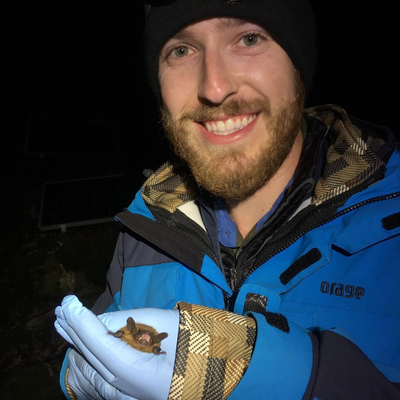
Abstract 284 - Categorizing the research effort across the family Ursidae
Zachary David, Old Dominion University StudentSalon 8/9
Zachary David and John Whiteman
Scientific research is critical for informing management and conservation plans for threatened
species. An understanding of concepts such as life history, ecological interactions, human-
wildlife conflict, and habitat and diet selection are essential for assessing species-specific
threats. The distribution of research effort across threatened species is not uniform, with some
species and topics receiving significantly more attention than others. The family Ursidae – bears
– may exemplify this discrepancy; several species are global icons, while others are relatively
unknown outside of wildlife studies. Bears are charismatic and draw a lot of public attention,
are ecologically important due to their extensive geographical range and status as an umbrella
species, and occupy a variety of biomes. Additionally, individual species within Ursidae exhibit a
wide range of unique adaptations and dietary niches, from hypercarnivorous polar bears to
herbivorous giant pandas. Using the Web of Science database, we collected all peer-reviewed
papers published on Ursidae species between 1970-2021 and categorized studies into 28
distinct research disciplines, revealing a sharp discrepancy in both number of papers published
and distribution of research topics across Ursidae. Analysis of research effort by species both
temporally and spatially are currently ongoing.
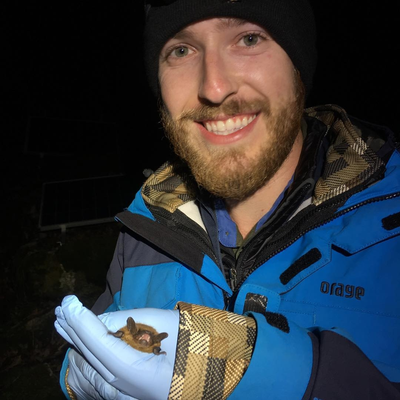
Abstract 285 - EUROBEAR: Collaborative science for spatial brown bear ecology
Andrea Corradini, Fondazione Edmund Mach ProfessionalSalon 8/9
Andrea Corradini, Sydney R Stephens, Francesca Cagnacci
The consequences of anthropogenic impacts on ecosystems are driving species adaptation and
persistence worldwide. While local studies can help unveil fine-scale processes, robust
assessment of broader processes are possible when pooling ecological data from a variety of
environmental contexts. This is especially important for wide-ranging species, which are
exposed to a large variety of conditions and stressors in space and time. The brown bear, the
most extensively distributed ursid, is a prime example: it occupies various ecosystems, including
forests, deserts, and tundras, at elevations ranging from sea level to 5000 meters, and within a
latitude range of approximately 25° to 70°N. Building on the Euromammals initiative, which has
been pioneering collaborative science in spatial animal ecology since 2007, the aim of this
project is to establish a network of interested parties and build a long-term, secure sharing
platform for researchers and managers to investigate biological, ecological, and management
questions for brown bears in Europe. This is achieved by analyzing data across populations and
with the field knowledge gained by managers and researchers working with bears in different
socio-ecological contexts. The initiative builds on previous EU-wide collaborations, such as
Biodiversa+ BearConnect and EU co-funded LIFE+ projects, and cloud-based data management
infrastructure at Euromammals. Eurobear relational spatial database ensures the collection,
quality control, standardization, and sharing of data necessary to actualize the collaboration,
while the Term of Use allows partners to join the network while maintaining full ownership and
responsibility for their data.

Abstract 286 - Low-stress herding reduces cattle predation by grizzly bears
Matt Barnes, Northern Rockies Conservation Cooperative ProfessionalSalon 8/9
Matt Barnes
A conservationist partnered with two grazing permittees and the Shoshone National Forest on
the Union
Pass Allotment, in the Wind River Mountains of northwestern Wyoming, USA, to improve cattle
management, and by extension maintain land health and reduce conflicts with wildlife,
particularly grizzly bears, which had killed several cattle each year, and gray wolves. The group-
size effect is a well-known anti-predator behavior of many prey species, including ungulates.
Strategic rotational grazing increases stock density (concentration), and low-stress livestock
handling increases herd instinct--two parallel ways to facilitate the group size effect in livestock.
The Forest Service developed a grazing plan that involved combining the two herds, and
rotation through 7-9 grazing management units but only one cross-fence. Prior to the project,
the cattle did not form a single herd, self-segregated into small social units, and in some cases
repeatedly traveled down from the mountain allotment to their home ranch. We-cohosted
training in low-stress livestock handling, and for 3 years the permittees applied low-stress
herding to the best of their ability. The cattle formed larger groups but never formed a single
cohesive herd. In the 3 years prior to the project, there was predation by grizzly bears every
year; during the 3 years of the project, there was no confirmed predation. One herd reduced
annual confirmed losses to bears from mean 2.6% (maximum 6.7%) to 0%; losses to unknown
causes from 3.9% (maximum 7.9%) to 2.0%; and total losses from 10.6% (maximum 19.1%) to
4.3% per year. (The other herd did not have adequate records of pre-project losses.) In this case
study we cannot rule out other factors, but it appears likely that low-stress herding in a
strategic rotation led to reduced bear-livestock conflict. Strategic grazing management and low-
stress herding may be important aspects of a strategy for reducing livestock vulnerability to
predation by large carnivores.

Abstract 287 - Challenges Associated with Bear Viewing Opportunities on Public Land in Montana
Blakely Adkins, Greater Yellowstone Coalition ProfessionalSalon 8/9
Blakely Adkins
I spent 11 seasons guiding for a bear viewing company on the Central Coast of British Columbia
in a very remote location. More recently, I have been working in SW Montana and spend time
working with community members in the Tom Miner Basin outside of Yellowstone National
Park. The public frequents this community to view bears from the side of the county road every
fall as they forage on caraway. There is a lot of differences between bear viewing on the BC
coast, bear viewing in Yellowstone National Park, and bear viewing along side a community of
ranchers off a public road. My presentation would be focused on these differences with a
highlight on challenges the Tom Miner Basin community is faced with.
Caraway is an introduced species to the Tom Miner Basin of Montana. It is a desirable food
source for grizzlies in the fall and late summer, and over the years bears have learned to come
here to fatten up before hibernation. Some days you can watch 20 or more bears at a time
digging up caraway on the same properties. The back of the basin has four working ranches
where caraway is most abundant in the area. Recently, it is not uncommon to see close to 100
people watching bears in the evenings without any enforcement. People are going as far as to
set up grills for hamburger dinners on their tailgates as they wait for bears to come into view.
This behavior is a risk to attracting bears as well as a fire risk.
Bear behavior is also changing over time. Ranchers have noticed that some bears have become
more habituated to humans and are less likely to leave the area when they are fixing fence and
calling out “hey bear” as they were in the past which makes them worried. The community of
Tom Miner is working with agency and NGO partners to find solutions to these challenges and
more.
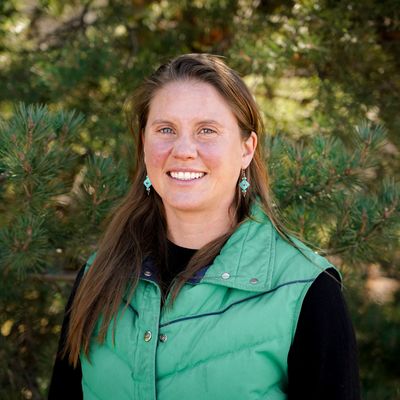
Abstract 299 - Using hair snares and camera traps in community-led polar bear research: insights on polar bear genetics, distribution and body condition in the Eeyou Marine Region (James Bay, Canada)
George Natawapineskum, Cree Trappers' Association, Eeyou Marine Region Wildlife Board StudentSalon 8/9
Alexandra Langwieder, Angela Coxon, Natasha Louttit, Stephanie Varty, Felix
Boulanger, George Natawapineskum, Sanford Diamond, John Lameboy, Murray Humphries
Engaging Indigenous Peoples and their knowledge in wildlife monitoring is recognized to be
important in conservation science but reconciling community support and leadership with the
requirements of systematic wildlife monitoring can be challenging. Polar bears in James Bay,
Canada, are the world's most southerly polar bears and already experience warming conditions
expected for populations farther north but little is known about their ecology in this boreal
system. Eastern James Bay Cree communities have observed changing polar bear distribution
and abundance in the last decade and identified polar bear ecology as a high research priority.
Given this, our objective was to build a non-invasive polar bear research program with Cree
communities to co-develop knowledge on polar bear ecology at the southern edge of their
range. We used hair snares and camera trap sampling stations to gather information about
polar bear genetics, diet, body condition and habitat use. Over three summers we deployed 40
sampling stations across 400km of eastern James Bay with four community field teams. We
collected over 300 hair samples and hundreds of polar bear observations. Here we report the
genetic, body condition and habitat use results of this project and demonstrate that these non-
invasive methods are effective tools for delivering valuable information through community-
based polar bear research. At a time when mainstream polar bear research methods are being
questioned across the Arctic, we believe this approach could be widely used by communities to
lead polar bear research in their regions.

Abstract 300 - American Black Bears in Lowland Desert: Assessing Habitat Use with Hydrogen Isotopes
Sydney Stephens, University of Utah StudentSalon 8/9
Sydney Stephens, Christy J. Mancuso, Austin M. Green, Cagan H. Sekercioglu
American black bears typically rely on forested land cover and are not expected to spend
prolonged periods of time in shrub-dominated arid lands like the red rock deserts of
southeastern Utah. While arid lands are known to be used as corridors between
metapopulations (i.e. the La Sal Mountains, Tavaputs Plateau, Uncompahgre Forest), these
areas are considered unsuitable for anything more than short-term occupation during dispersal.
However, increases in the number of bear encounters near the Rio Mesa Field Station north of
Castle Valley and Moab suggest bears may spend more time in arid systems than previously
known. Camera traps and hair snares were used to investigate the residency of frequently
visiting bears. Additionally, we received hair samples from bears in the La Sal (n=11) and San
Juan (n=4) mountains from the Utah Division of Natural Resources. We measured hydrogen
stable isotopes to examine bear land use at different elevations and to assess occupancy after
short-scale dispersal events. While our hair snare samples were all gathered from only one
individual at the low elevation area, the differences in their hydrogen values were still
significantly different from higher elevation bears (p=0.03). Our findings suggest that bears
were occupying these low-elevation deserts for time periods beyond temporary transit paths.
Continued use of this area by other bears has been confirmed with camera trap and visual
sightings. This case study provides preliminary evidence of desert habitat use being greater
than previously thought, and shows the potential for using this O/H stable isotopes to assess
similar situations as a more affordable, non-invasive, and random sampling technique than
other current options.

Abstract 301 - Partitioning Human and Brown Bear Niches: Transboundary Connectivity and Human Disturbance in the Alpine Region (PartNiche)
Sydney Stephens, University of Trento StudentSalon 8/9
Sydney Stephens, Andrea Corradini, Natalia Bragalanti, Claudio Groff, Nina Gandl,
Sybille Klenzendorf, Francesca Cagnacci
The Alpine ecosystem in Europe, a region marked by both rich biodiversity and intensive human
use, stands at the forefront of conservation challenges, particularly concerning the coexistence
of humans and wildlife. This research, set within the mulit-national landscape of the Alps, aims
to elucidate the complex interplay between human activities and the habitat use and
connectivity of the brown bear (Ursus arctos), a species emblematic of both conservation
success and social conflict. After reintroduction of brown bears to Trentino, Italy 25 years ago,
the growing population allows for continued range expansion into former habitat throughout
the Alps. Leveraging a multidisciplinary approach, the study designs models to analyze spatio-
temporal patterns of bear movements and human-bear interactions, focusing on areas
impacted by human infrastructure, recreational activities, and changing social acceptance of
large carnivores.
Employing bio-logging, remote sensing technologies, and socio-ecological surveys, the research
aims to produce dynamic, fine-scale representations of current bear distribution, connectivity
to potential habitat within and outside the population range, and human-bear conflict zones
stemming from both tangible and sociological human disturbance. Historical and sociological
drivers of wildlife tolerance will also be investigated. Anticipated preliminary results include the
identification of key areas of habitat, connectivity, and conflict hotspots. This research and its
products such as interactive suitability maps, predicted areas of conflicts, and science-based
conservation protocols, are done with the goal of contributing to the Conflict-to-Coexistence
(C2C) Approach for mitigating human-wildlife conflicts through informed conservation
strategies, and addressing the urgent need for a harmonized coexistence between humans and
the recovering Alpine brown bear population.
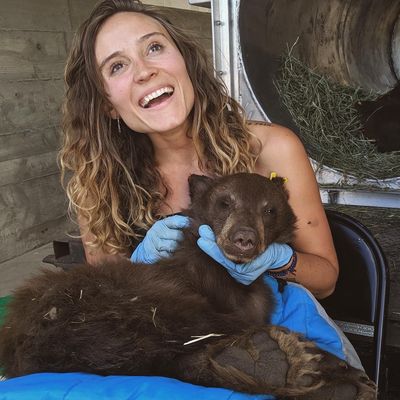
Abstract 304 - Population Dynamics and Feeding Ecology of Recolonizing American Black Bears (Ursus americanus) in the Beaver Hills Biosphere
Sandra MacDougall, Red Deer Polytechnic ProfessionalSalon 8/9
Sandra MacDougall, Ramona Maraj, Erin Henderson
The population of American black bears (Ursus americanus) in North America has been growing
and expanding in range, recolonizing previously extirpated ranges that have been altered by
human activity. Just east of Edmonton, black bear sightings in Elk Island National Park and the
Beaver Hills Biosphere region have increased steadily over the past five years. This population is
right at the edge of the species’ range expansion which has numerous implications for
municipal, provincial, and federal agencies. How wildlife coexistence programs are delivered
and what will potentially happen to ungulate populations that have existed without predation
by bears for over a century are critical considerations. The objectives of this five-year study are
to examine the feeding ecology and demographic characteristics of black bears within the
Beaver Hills region to understand the potential for population growth and dispersal at the edge
of a species’ range and use this information to predict the impact black bear predation may
have on ungulates inside and outside of core protected areas. To date, 10 black bears have
been radio-collared to assess their movement, habitat selection, and feeding ecology. We will
use a combination of approaches to determine regional bear diets; including DNA
metabarcoding of bear scats collected through systematic transect surveys, isotopic and fatty
acid analysis of bear tissues and movement data obtained from radio-collared bears. We will
present preliminary analysis of food habits based on scat metabarcoding and bear movements
during the 2023 active season.

Abstract 314 - Virtual Bear Viewing as a Conservation Tool
Alysa McCall, Polar Bears International ProfessionalSalon 8/9
Alysa G. McCall, BJ Kirschhoffer, Candice Rusch, Brian Byrd, Mike Fitz, Geoffrey S.
York, Krista Wright, Kieran McIver
Education and outreach can be powerful tools in wildlife conservation. Targeted outreach can
increase support for conservation actions by impacting attitudes and furthering awareness
about environmental issues or species, and may be especially effective when visual elements,
like photos or videos, are incorporated.
Polar Bears International (PBI) first deployed live Polar Bear Cams near Churchill, Manitoba in
2007, allowing the public to view the annual polar bear gathering. After an initial success, PBI
partnered with Explore.org to operate and grow the impact of these cams. We now virtually
reach millions of people around the world each year who tune in to watch polar bears roam the
tundra and to learn about the species. PBI also uses the Polar Bear Cam footage to complement
educational programming and as a platform to inspire action on climate change.
Explore.org now has over 100 live wildlife cameras deployed around the world, including
several at Brooks Falls in Katmai National Park in Alaska, where local brown bears feast during
the annual salmon migration. These Brown Bear Cams allow viewers to closely follow individual
bears and have led to the viral “Fat Bear Week” which has captured attention and created joy
across the globe.
Many people will never get to see bears in the wild but by live-streaming incredible moments
and incorporating key messaging into such outreach, we can help people build connections
with bears, increase our organizations’ impact, broaden conservation support, and turn awe
into action.

Abstract 315 - Developing Effective Polar Bear Safety Educational Materials in a Changing Climate
Alysa McCall, Polar Bears International ProfessionalSalon 8/9
Alysa G. McCall, Geoffrey S. York, Joanna Sulich, Clive Tesar, Joseph M. Northrup,
Lyle Walton, Greg W. Thiemann
As the world warms and sea ice extent and duration decreases, polar bears are spending more
time on land in more regions. Many people who live on or near northern coastlines have some
knowledge of how to live with polar bears, but more and more communities are experiencing
polar bears for the first time or in increasing numbers. More people from outside the polar
bears’ range are also coming into contact with them, whether as tourists or as transient
workers. If we want polar bears to persist in the wild over the long-term, we have an obligation
to help people live more safely with the world’s largest land predator.
With various partners, Polar Bears International (PBI) has been supporting multi-pronged
coexistence efforts Arctic-wide through deterrence trainings, testing non-lethal and less-lethal
tools, providing equipment, and developing materials with input from communities. To date,
we have developed a variety of educational materials tailored to different cultures, landscapes,
languages, and topics. We illustrate how diverse media products (e.g., colouring books,
handouts, video) can be used to communicate and educate residents and visitors on polar bear
safety best practices.
We will continue to work with locals, communities, governments, and universities to support
the development, printing, and distribution of materials where requested. Polar bear safety
language is likely to be refined over time so materials may need to be updated regularly,
especially as the polar bear’s sea ice habitat continues to shift and decline.

Abstract 318 - Analyzing dispersal behavior of juvenile black bears in a recolonizing population in east-central Oklahoma to identify potential barriers to population expansion.
Jacob Humm, Oklahoma State University StudentSalon 8/9
Jacob Humm and W. Sue Fairbanks
Immigration through dispersal is critical to population structure and recolonization success of
small black bear populations. During the transient stage of black bear dispersal, juveniles face
increased risk of predation by other species and conspecifics, higher energetic costs of travel,
and risk of mortality from human-wildlife interactions. Habitat fragmentation from
anthropogenic activities has been shown to limit bear recolonization success in populations
across North America by barring dispersal into new areas, limiting gene flow among established
populations, and increasing mortality risk among dispersing individuals. Oklahoma’s east-
central black bear population occupies a patchy, fragmented landscape characterized by
disjunct habitat patches surrounded by anthropogenic disturbance. My objectives were to 1.)
model juvenile dispersal movements through the landscape, 2.) develop predictive models of
dispersal movements, and 3.) use these data to develop resistance models of movement to
identify potential barriers to dispersal into habitat patches outside the core of the population.

Abstract 326 - A more complete view: understanding black bear and grizzly bear spatial and temporal niche partitioning in two contrasting Yukon landscapes
Jodie Pongracz, Government of Yukon ProfessionalSalon 8/9
Jodie Pongracz, Kai Breithaupt, Patrick Gibeau
Grizzly bear (Ursus arctos) and black bear (Ursus americanus) distributions overlap in much of
the Yukon Territory, however, little is known regarding how these sympatric species coexist at
the northern edge of their ranges. Black bears and grizzly bears have strong diet overlap, and
similar life histories. Understanding how these species interact in space and time is essential to
understanding how they coexist or potentially influence each other’s existence.
We used detections of black bears and grizzly bears at two contrasting remote Yukon
landscapes to better understand patterns of use. The Ogilvie Mountains study area contains
pristine habitat, encompasses a territorial protected area, and is comprised of large U-shaped
valleys and bare mountain ridges shaped by multiple glaciations. In contrast, the Klondike
Plateau study area was unglaciated, is centralized on a quartz mine exploration complex, and is
comprised of V-shaped valleys and upland areas of smooth topped ridges and boulder fields.
Remote cameras were positioned at scent-lured hair snag stations positioned in a gridded
arrangement across the two study areas. Camera traps in the Klondike Plateau (n=150) were
active between 18 June and 14 August 2022; those in the Ogilvie Mountains (n=154) were
active between 20 June – 19 September 2023. We use photo detections of black bears and
grizzly bears to 1) examine the level of spatial overlap and quantify how this relates to habitat
variables, and 2) examine the temporal overlap at differing temporal scales (daily and berry
season (pre-berry/berry/post-berry)).
Abstract 328 - Effectiveness of individual-based activity analysis and hidden markov models at predicating animal activity of a wild Eurasian brown bear
David Blount, University of Utah StudentSalon 8/9
David Blount, Ryan Fregmen, Mark Chynoweth, Josip Kusak, Cagan Sekercioglu
As GPS collars grow in popularity and decrease in price, many research programs have
incorporated these tools to understand temporal trends of their study animal. Specifically,
activity patterns have been used to understand how animals persist on landscapes, what
threats they face, and how they may avoid these threats by changing their temporal patterns.
Changes in activity patterns can have drastic consequences, with animals navigating a matrix of
risk and reward through time, affecting fitness, mortality risk, and risk of starvation. However,
many of the analysis used to understand activity have only been tested in simulations or in
captive populations. In this study we use a GPS collar with a camera to compare binomial
activity estimates and activity states estimated with hidden Markov models to observational
camera data from a wild Eurasian brown bear. We hope to show how well each of these activity
analysis predict actual activity in the wild.
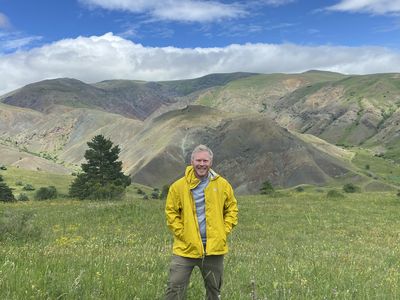
Abstract 339 - Transcriptome changes of peripheral blood related to delayed implantationin brown bears and polar bears
Asuka Nishijima, Hokkaido University StudentSalon 8/9
Asuka Nishijima, Yojiro Yanagawa, Naoya Matsumoto, Kyogo Hagino, Hideyuki
Sakamoto, Youichi Irie, Chihiro Sochi, Kanako Ushio, Hiroko Tanaka, Takashi Hayakawa
Mating and giving birth in a suitable condition is essential for mammals, those living in seasonal
areas. Embryonic diapause, which is known as delayed implantation in mammals, is a reversible
embryo dormancy before implantation. This interesting phenomenon allows mammals to
regulate the timing of mating and parturition. Ursids are one of the few families in which all
species are most likely to have delayed implantation. Ursids also have other unique
reproduction characteristics, such as pseudopregnancy, denning, and giving birth to unmatured
cubs. However, those unique reproduction characteristics make it difficult to detect their
pregnancy status. Our previous study showed that pregnant female brown bears’ peripheral
blood transcriptome was changed between estrus and delayed implantation period. In this
study, we collected peripheral blood from five individual male brown bears and three individual
pseudo-pregnant female brown bears in different periods. These bears’ peripheral blood
transcriptomes were compared with pregnant brown bears to identify pregnant female-specific
transcriptome changes. Pregnant brown bears’ peripheral blood transcriptome changes were
also compared with pregnant polar bears to verify those changes were common in other bear
species. Pregnant female-specific transcriptome changes related to delayed implantation could
be used as markers for an early pregnancy test in bears. Pregnancy test in bears could improve
their reproduction success in captives and contribute to ex-situ conservation.

Abstract 993 - Assessing the risk of climate maladaptation for Canadian polar bears
Ruth Rivkin, Polar Bears International and San Diego Zoo Wildlife Alliance ProfessionalSalon 8/9
Ruth Rivkin, Evan Richardson, Colin Garroway
The Arctic is warming four times faster than the rest of the world, threatening the persistence
of many Arctic species. It is uncertain if Arctic wildlife will have sufficient time to adapt to such
rapidly warming environments. We used genetic forecasting to measure the risk of
maladaptation to warming temperatures and sea ice loss in polar bears (Ursus maritimus)
sampled across the Canadian Arctic. We found evidence for local adaptation to sea ice
conditions and temperature. Forecasting of genome-environment mismatches for predicted
climate scenarios suggested that polar bears in the Canadian high Arctic had the greatest risk of
becoming maladapted to climate warming. While Canadian high Arctic bears may be the most
likely to become maladapted, all polar bears face potentially negative outcomes to climate
change. Given the importance of the sea ice habitat to polar bears, we expect that
maladaptation to future warming is already widespread across Canada.

Abstract 994 - Mapping Asian Bears — a Novel Approach for Large-scale Species Range Mapping to Inform Conservation
Chengcheng Zhang, Conservation Ecology Center, Smithsonian's National Zoo and Conservation Biology Institute; Sapienza University, Rome, Italy StudentSalon 8/9
Chengcheng Zhang, William McShea, David Garshelis, Dana Morin, Nina Santostasi
Mapping geographic ranges is an essential step in assessing species’ status and threats. The first
modern range maps for Asian bears were published by the Bear Specialist Group (BSG) in a
Conservation Action Plan in 1999, and updated at a BSG workshop in 2006. These maps were
created using an ad hoc process, melding scattered reports with “expert opinion” of BSG
members, and were published online with Red List accounts of each species. In 2016–2017, the
BSG updated these Red List maps, incorporating new information, and in some cases, computer
modelling. Lacking metadata and involving a mixture of processes, it has been difficult to assess
the reliability of these maps.We designed a new mapping approach, which, during 2024–2027,
will be used to revise the range maps for Asiatic black bears, sloth bears, sun bears, and brown
bears in Asia. We will involve BSG members as well as other individuals with local knowledge of
bear presence (or absence) in portions of each of the 33 bear range countries in Asia. This is not
a crowdsourcing effort, but rather targeted participation of people with familiarity of bear
presence. Contributors will draw polygons on a computer app, and may also submit “hard data”
in the form of presence points (e.g., camera trapping records). Each presence/absence polygon
and all presence points will be associated with metadata (who, when, how detected). This novel
method recognizes that people who spend significant time in an area often are aware of bears
even if they are not detected in formal surveys. Using this information helps ameliorate
deficiencies in hard data (e.g., clumped in selected habitats, targeted at other species), which
can cause computer models to produce misleading results (e.g., inclusion of good habitats
where bears have been extirpated; exclusion of marginal habitats where bears are known to
persist). The process will be fully transparent, yielding a revisable map, which can serve as a
valuable tool for assessing conservation status (e.g., identifying small isolated populations or
important corridors), and monitoring expansion or shrinkage of range. This project involves the
“Assess” component of the Species Conservation Cycle using large-scale “Networking”, and
eventually “Communicating” the results widely, so they can be put to use.

Abstract 995 - Assessing Changes in Distribution of Formosan Black Bears over the Past Decade
Mei-Hsiu Hwang, Institute of Wildlife Conservation, National Pingtung University of Science & Technology; Taiwan Black Bear Conservation Association; IUCN SSC Bear Specialist Group ProfessionalSalon 8/9
Mei-Hsiu Hwang, He-Jie Shu, Fan-Yi Chan, Chin-Hao Chang, Chia-Chi Wang
Spatial distribution is a key element in assessing the status of wild populations of threatened
species, and can be used to identify priority conservation areas, areas of fragmentation, and
areas of expansion or contraction. We employed the “Assess” component of the Species
Conservation Cycle to evaluate changes in distribution of the endemic, endangered Formosan
black bear (Ursus thibetanus formosanus) on the island of Taiwan. We aimed to compare a
distribution map for 2000–2010 to an updated map based on data collected during 2011–2023.
Since 2011, we collected 1,838 bear presence records (ranging from 202–3,524 m in elevation),
covering 706 1×1 km2 bear grids; 88% were located in natural forest areas, and 58% were
within the protected area system of the Central Mountain Range Conservation Corridor. Bear
presence data collected from camera traps (37%), sign (27%), and sighting reports (15%)
reports showed consistent, widely-distributed patterns; whereas GPS telemetry data (19%) and
bear rescue reports (2%) were limited to some specific areas. We used MaxEnt modeling, using
natural and anthropological variables, to develop the distribution map. The model predicted a
bear range encompassing one-third of the Taiwan area, mainly in the Central Mountain Range.
Distance to protected areas, elevation, and distance to roads were the three most important
factors predicting bear occurrence. Compared to the bear range during 2000–2010, recent data
seemed to indicate a slight expansion, but regional differences were observed. We detected no
recent bear presence or predicted distribution in the Coastal Mountain Range. Bear rescuing
reports (public reports of bears caught in snares near villages) occurred mainly in lower
elevations in a limited area, which may have caused the model to overestimate the range.
Likewise, reports of illegal hunting (a main threat to the population) occurred mainly near
villages, and may have had a similar effect on model predictions. We discuss relevant
conservation and population monitoring strategies stemming from these results.

Abstract 998 - Conservation Implications of the Reintroduction of Two Confiscated Himalayan Brown Bears in Pakistan
Fakhar-i-Abbas, IUCN SSC Bear Specialist Group ProfessionalSalon 8/9
Fakhar-i-Abbas
Some cultural practices, such as dancing bears in India and bear-baiting in Pakistan, typically
using wild-caught bears, have contributed to population declines. Successful conservation
programs have focused on eliminating the acceptability of these practices, targeting non-
compliant individuals, and confiscating captive bears. In such a program in Pakistan, some
confiscated bear cubs (both Asiatic black bears and brown bears) were deemed potentially
suitable for release. This project involved the “Act” component of the Species Conservation
Cycle, with repatriation of young rescued bears intended to improve conservation status by (1)
motivating more confiscations, and (2) helping restore some depleted wild populations. During
this program, aimed at ending bear baiting in Pakistan, two confiscated female Himalayan
brown bear cubs (rescued at ~2 months old) were considered suitable for reintroduction. They
were kept for 2 years, following a low-human contact protocol to prepare for a hard-release. In
2017, at the age of 26 months, the two females were released in Khunjerab National Park, a
remote area bordering China, with considerable media attention. The selection of a release site
was based on GIS-modeled habitat availability at a location between known brown bear
populations, but with no resident bears. The released bears were tracked by resightings made
possible by the open habitat in the region, and by identifiable physical markings (unlike
previous releases of Asiatic black bears, which were harder to see and identify). After their
initial release in the Uxcel valley at an elevation of 4500 m, they moved 20 – 70 km each year to
different valleys, but generally favored ~4700 m elevation. Over 7 years of monitoring, they
ultimately settled in a valley surrounded by snow-covered mountains and glaciers, but still with
no other brown bears. Visible weight gain over these years indicated sustained health. The
bears' experimental movements in diverse terrain emphasizes their resilience and adaptability,
as well as the importance of selecting sites with room to roam. The project appears successful
at this stage, but true success will be determined over time as we wait to see if the females
eventually reproduce.

Abstract 999 - Unravelling Intersecting Paths: Conflict, Livelihood, and Coexistence with Asiatic Black Bear in Diamer, Gilgit-Baltistan, Pakistan
Zeeshan Khalid, World Wide Fund for Nature- Pakistan (WWF-Pakistan) ProfessionalSalon 8/9
Zeeshan Khalida, Tehlu Singh Toorb and Muhammad Jamshed Iqbal Chaudhrya
Gilgit Baltistan (GB) is renowned for its biological and cultural diversity and covers an important
part of the Asiatic black bear (Ursus thibetanus) habitat in Pakistan. Human–black bear conflict
is an emerging issue in District Diamer, Western Himalaya, GB and the declining population
status has become vulnerable. This study investigated the extent of human-bear conflict in
district Diamer, GB (2021-2023) using semi-structured interviews and focus group discussions
(FGDs). Three primary conflict types were identified: crop damage (most frequent - 80%),
livestock depredation, and human injuries and the total estimated economic loss was
US$16,000. Crop damage peaked in summer (June-September) during peak bear activity and
crop production. We documented 12 human injuries (May-November), with a majority (55%)
occurring at dusk and in crop fields (60%) during summer (40%). Livestock depredation (10
cases) was less frequent and occurred mainly in winter. Negative attitudes towards bears
prevailed (65% actively disliked, 62.5% generally negative), especially among those residing
near bear habitat. Anthropogenic activities (hunting, deforestation, infrastructure expansion,
agricultural land conversion) were identified as primary conflict drivers. Participants expressed
dissatisfaction with current conflict mitigation policies and the lack of government
compensation schemes. Future research on population status, bear movement, and habitat use
is crucial for developing effective conservation strategies. Considering the significant role of the
Asiatic black bear in the GB region & ecosystem, we argue that more emphasis should be given
to the protection of prioritized bear populations.

Friday 20 Sep 2024
07:00
BREAKFAST
Edmonton Convention Centre, Assembly Foyer
08:00
Abstract 199 - Does Destroying Wildlife Reduce Human-Wildlife Conflict? Evidence from Black Bears in British Columbia
Felix Pretis, University of VictoriaHall C
Felix Pretis, Jason Hicks, Sara Wray Enns, Sumeet Gulati, Prasun Ghimire
The destruction of wildlife is a common intervention in response to human-wildlife conflict.
However, it is uncertain how effective such lethal interventions are in reducing future conflict.
Here we assess whether the destruction of wildlife reduces human-wildlife conflict by
assembling a novel dataset on all recorded human-black bear conflicts in British Columbia,
Canada from 2013 until 2021. The data spans more than 66,000 conflict events leading to more
than 3,000 bears having been destroyed. We estimate the response of conflict to destroyed
bears using panel regressions and local projections controlling for weather, settlement
density, seasonal effect, as well as salmon abundance. We find little evidence that the
destruction of black bears leads to significant long run reductions in future human-bear conflict.
Our results show a small temporary fall in conflict in response to destroyed bears, with a
rebound to pre-intervention levels of conflict after 12 months. These results are consistent with
human-black bear conflict being driven by circumstances rather than problematic bears and
cast doubt around the practice of destroying wildlife to reduce human-wildlife conflict.

Human-Bear Conflict & Coexistence - Session Chair Tom Smith
Hall C
08:15
Transition
08:20
Abstract 232 - A combination of aerial damage detection and in situ DNA sampling in crop fields for genetic monitoring of problem brown bears in Hokkaido, Japan.
Yuri Shirane, Hokkaido Research OrganizationHall C
Yuri Shirane, Mami Kondo, Hino Takafumi, Kazuki Miura, Tsutomu Mano, Hifumi
Tsuruga
Human-wildlife conflict in agricultural lands is a serious global issue that affects the survival of
wildlife populations and human safety. Previously, wildlife damage to crops has been
investigated by radio telemetry to track animal movements and measure habitat selection, and
by diet analysis using stable isotope analysis of biological samples. However, these methods are
difficult to obtain a profile of problem individuals involved in crop damage within an area and
to continuously survey damaged fields on a detailed spatial and temporal scale. Here, we
attempted to combine unmanned aerial survey and ground-based genetic sampling to
determine if a large number of bears in the vicinity of the agricultural lands were causing
damage or if the same individuals were causing damage repeatedly in brown bears of Hokkaido,
Japan. In Yakumo Town, located in southwestern Hokkaido, where dent corn is widely
cultivated every year, we conducted drone flights to take aerial photographs of cornfields. By
photographing for two to five consecutive days from late June to September in 2015–2019 and
2021–2022, fresh damaged patches of each field were identified based on the unique textural
characteristics of healthy and damaged patches in the field. Then, we visited each damaged
spatches to collect fresh genetic samples (e.g., hair, feces, and residual saliva on partially-
consumed corn) of brown bears, and examined 9 loci of microsatellites for individual
identification. Results revealed that most of the individuals causing damage are males, and that
same individuals repeatedly caused damage to the one corn field over multiple years. In
addition, some individuals were causing damage in a different corn field than the previous year.
Our individual-based methods for analyzing crop damage can be used to better understand the
relationship between the number of problem individuals, the area damaged, and the
landscape, leading to more efficient management to reduce human-bear conflict.

08:35
Transition
08:40
Abstract 306 - Bears, watch your step: a study of fine-scale individual bear movement through an urban landscape in Colorado.
Cassandre Venumière-Lefebvre, Colorado State University StudentHall C
Cassandre Venumière-Lefebvre, Heather Johnson, Mat Alldredge, Stewart Breck,
Kevin Crooks
For wildlife, developed areas can bring access to novel sources of food and increased mortality
risk. For American black bears, anthropogenic refuse in urban areas alters activity patterns and
time budgets and leads to increased rates of human-bear conflict. Reducing anthropomorphic
food sources reduces conflict, but it is unclear how this type of management strategy influences
bear ecology (e.g., their movement patterns). Colorado Parks and Wildlife, US Department of
Agriculture, the City of Durango, and Colorado State University collaborated on a large-scale
experiment that tested the effectiveness of wildlife-resistant garbage containers to reduce
human-bear conflict in Durango, Colorado. In 2010, an ordinance required residents to secure
attractants. In 2013, wildlife-resistant containers were distributed in two treatment areas, while
residents of two control areas continued to use mostly regular containers. Between 2011 and
2016, bears were captured around the city and fitted with GPS collars. The quantity of natural
foods available annually and the consistency of residents in properly locking their containers
were also monitored. We applied an integrated step-selection analysis to bear movements
through the area to investigate the efficacy of bear-resistant containers in modifying bear
behavior. Specifically, we examined the effect of treatment, resident compliance, and natural
food availability on bear resource selection and speed when moving through the urban
landscape. Our results inform whether bear-resistant containers can change how bears move
and use the landscape, and whether this strategy can be used to promote human-carnivore
coexistence.

08:55
Transition
09:00
Abstract 325 - Factors affecting forest road use in Eurasian Brown Bears
David Blount, University of Utah StudentHall C
David Blount, Mark Chynoweth, Josip Kusak, Cagan Sekercioglu
Of all anthropogenic disturbances, none are quite as ubiquitous as roads. Over 20% of all
Earth’s terrestrial landmass is located within 1 km of a road, and the remaining landmass
greatly fragmented (Ibisch et al. 2017). More developed continents, like Europe, have even
higher concentration of roads, with 50% of its land within 1.5km of a road (Torres et al., 2016).
Roads have been shown to be ecological traps for many carnivores, including brown bears,
offering food (Roever et al., 2008) and movement corridors (Roever, Boyce & Stenhouse 2010)
at a cost of increased mortality from cars and humans (Northrup et al. 2012). This relationship
is complex, and traffic volume may be more important than road density in determining how
bears use roads and their survival outcomes (Northrup et al. 2012). Roads with limited traffic
have actually been shown to be selected for in resource selection functions and used more
frequently (Northrup et al., 2012; Blount et al., in review). In this study we used 40 GPS collared
bears and camera traps on forest roads to understand what factors affect unpaved forest road
use in Eurasian brown bears in northeastern Türkiye. We measured brown bear activity across
the year using accelerometer data from GPS collars to understand when bears were active. We
then paired this data with a large camera trap array to understanding forest road use by bears
in relation to bear activity. Combining these techniques, we were able to understand when
bears use roads, how road use patterns change across seasons, and what factors may affect
forest road use. As brown bears colonize human populated areas across Europe, understanding
when and how bears use roads is vital to decreasing human caused mortality, and limiting
human-wildlife conflict.

09:15
Transition
09:20
Abstract 337 - Human-Bear Conflicts in Southwest Montana: Mapping Attractants and Prevention Efforts in Missoula and Ravalli Counties
Jessica Reyes, University of Montana, College of Forestry StudentHall C
Jessica Reyes, Carrie Hunt, Nils Pedersen, James Jonkel
This project evaluates the impact of human development on land cover changes in Missoula
and Ravalli Counties, MT (USA), and the influence it has had on the spatial and temporal
aspects of reported human-bear conflicts (conflicts) to Montana Fish Wildlife & Parks (MFWP)
from 2017-2022. Understanding the characteristics of conflicts is crucial for targeted and
proactive bear management and community development strategies as both grizzly bears and
human populations expand and will enhance safety for both bears and people while promoting
public acceptance of grizzly bears. These southwestern Montana counties consist of over 50%
of public lands and serve as critical linkage zones between the Grizzly Bear Recovery
Ecosystems for both Montana and Wyoming. Ravalli and Missoula Counties have large black
bear populations with chronic conflicts that are increasing. Documented grizzly bear
observations have been increasing in these counties in the last 5 years and subsequent grizzly
bear conflicts are predicted where black bear conflicts have previously been reported. This
project will produce maps detailing attractant types that lead to conflicts, conflict-reduction
infrastructure, and annual land use/land cover changes in each county respectively, and analyze
development growth patterns and geographical features that are correlated with reported
conflicts. Mapping results will be used to establish "bear buffer zones" as conflict mitigation
areas that promote safety for both bears and people in the wildland-urban interface in Ravalli
County and focus conflict prevention resources supporting “Bear Smart Community” initiatives
in both counties. These bear buffer zones will be designated on the map in collaboration with
James Jonkel (MFWP, R2), Wind River Bear Institute, and supporting organizations. This project
is an M.Sc. thesis at the University of Montana scheduled for defense in December 2024. These
maps will also be made available to the public through social media.
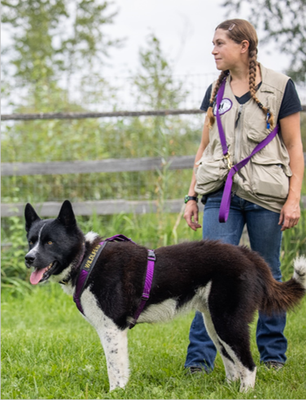
09:35
Transition
09:40
Abstract 341 - Characteristics of Grizzly Bear Observations in the North Slope Oilfields,Alaska
Nils Pedersen, Wind River Bear InstituteHall C
Nils Pedersen, Todd J. Brinkman, Richard T. Shideler, Mark S. Lindberg, Scott M.
Brainerd
Managing the risk of unsafe human-bear interactions in the North Slope oilfields of Alaska
(USA) requires an understanding of where they occur and how to prevent them. To reduce
negative interactions, oilfield operators prepared bear interaction plans that included
systematic collection of grizzly bear (Ursus arctos) observations. Between 1990 and 2014,
Oilfield Security Officers recorded 1,207 marked bear sightings using the Alaska Department of
Fish and Game’s (ADF&G) Grizzly Bear Sighting and Hazing Report (GBSHR) forms. Based on
previous research, ADF&G identified each marked bear and classified it as either food
conditioned (FC) or dependent on natural food (NF). Prior to deployment of bear-resistant
garbage containers around infrastructure between 1999 and 2001, bear access to food waste
was common within the area. We used spatial coordinates from GBSHRs to estimate changes in
mean distance between FC and NF bears and landscape features (facilities, roads, rivers,
landfill) before (1990–2000) and after (2001–2014) changes in waste management treatments.
Bear access to the landfill remained intermittent post treatment. We compared distances in
sightings between time periods using effect-size estimates and generated “hot spot” maps to
visualize changes in spatial distribution of sightings pre- and post-treatment. The waste
treatment increased the mean distance of bear sightings from facilities and roads and
concentrated FC-bear sightings around the landfill, where bear access to food waste persisted
post treatment. The treatment had a minimal effect on the mean distance of NF-bear sightings
near the landfill. Our study provides new information on the effects of waste management on
bear behavior and human-bear interactions within a large industrial complex. Our study also
demonstrates the utility of a systematic and active bear sighting report system for monitoring
bear activity in developed areas.

09:55
COFFEE BREAK
Edmonton Convention Centre
10:20
Abstract 317 - Bearing with it: impacts of human activities on American black bear space use and home range size in southeastern Oklahoma’s recolonizing population
Courtney Dotterweich, Oklahoma State University StudentHall C
Courtney Dotterweich and W. Sue Fairbanks
Once extirpated from eastern Oklahoma due to extensive overharvest and habitat loss,
American black bears are now recolonizing areas now altered by human activities and presence.
While human population density is rather low throughout southeastern Oklahoma (7.196
people/km2), this region is dominated by agriculture, timber plantations, and recreational
areas, all of which have been shown to contribute to shifts in bear movement. Understanding
this, the objective of this study is to identify the human, landcover, and temporal factors that
influence bear home range size and resource selection to better determine how these variables
influence recolonization in this region. We will utilize GPS data collected from 84 individual
female black bears from 2014 – 2023 to understand how human activities and areas of impact
influence black bear home range size and resource selection in a still recolonizing population.
Preliminary analyses using autocorrelated kernel density estimates (AKDE) to estimate home
range size indicated black bear home ranges varied widely within the study area and were
influenced by reproductive status, season, and contiguous forest cover. Future work will use
resource selection functions under a use versus availability design to identify whether bears
spatially or temporally avoid areas of human activity. This research can provide insights into the
recolonization potential for bears in this region, as well as identify the current impacts humans
have on this population.

10:35
Transition
10:40
Abstract 264 - Invitation to Participate: An experimental comparison of expert elicitation data and empirical data of American black bears
Darcy Doran-Myers, University of Florida StudentHall C
Darcy Doran-Myers and Conor McGowan
Expert elicitation is increasingly used in ecology to fill data gaps. The reliability of expert
elicitation as a source of data is seldom verified, but it is pivotal for credible research results.
This presentation is an invitation to participate in a USFWS-backed study designed to test the
accuracy and precision of expert judgments in ecology. The goal is to externally validate the
reliability of expert judgments and to investigate the factors affecting data accuracy. The
American black bear and its species experts is an ideal study system for this purpose because of
the bear's extensive range, decades of empirical research using consistent methods, and the
availability of numerous knowledgeable experts (you all!).
Invitation #1: I am compiling a large dataset of existing black bear genetic mark-recapture
datasets. I ask willing conference attendees to contribute data to this effort. By aggregating
existing datasets, I aim to generate comprehensive estimates of key parameters, such as
population abundance and survival rates, informed by various environmental factors. These
estimates will serve as a benchmark to evaluate the performance of expert judgments.
Invitation #2: I am recruiting black bear experts across the species range to serve on expert
panels. The call for participation extends to the broad spectrum of black bear specialists, at all
career levels, to ensure a diverse and representative sample. Experts will be asked to share
their expertise and provide estimates of local, regional, and range-wide parameters through an
initial survey, two rounds of online elicitation, and one round of online discussion.
Your participation will help to enhance our understanding of expert elicitation data in ecology,
thereby influencing the future of ecological research methods. You may personally benefit
through data acknowledgement, co-authorship where appropriate, and a better understanding
of black bear populations at large scales and your own species knowledge.
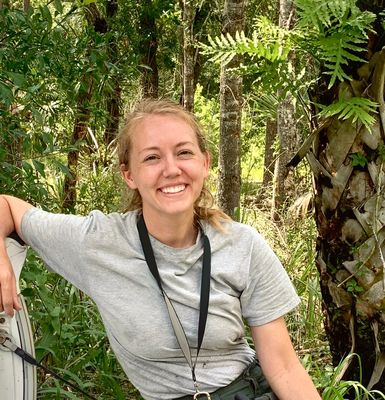
Demographics - Session Chair Kate Kendall
Hall C
10:55
Transition
11:00
Abstract 274 - Participatory assessment of Aklak (grizzly bear) abundance and distributionin the Kivalliq Region, Nunavut
Lauren Harding, University of Northern British ColumbiaHall C
Lauren Harding, Emil Arnalak, Russell Toolooktook, Malik Awan, Tayyab Shah,
Michaela Sidloski, Douglas Clark
Aklak (grizzly bear, Ursus arctos) are viewed by communities of the Kivalliq region, Nunavut, as
increasing in abundance. We used semi-structured interviews and participatory mapping
exercises in two communities, Arviat and Baker Lake (Qamani’tuaq), to elicit narratives of
encounters, estimates of spatial distribution and abundance, and knowledge of aklak ecology
from Inuit hunters and Elders. Inuit observations documented on maps during the interviews
were digitized and used along with reported harvest data (2008 to 2023) to estimate current
aklak abundance across the region using multiple spatial interpolation techniques. Validation
was conducted at workshops in each community in February 2023. Participants uniformly
emphasized an increase in the relative abundance of aklak across the Kivalliq region since the
beginning of the twentieth century, with rare encounters prior to the 1960s but frequent
encounters from the 1990s onward. Participants emphasize that aklak were not historically
abundant in the Kivalliq, suggesting a range expansion rather than a population recovering from
depletion. The distribution of aklak was primarily inland, with frequent encounters along lakes
and rivers, but with encounters in coastal areas increasing. Using Empirical Bayesian Kriging and
Inverse Distance Weighting to interpolate total aklak abundance based on the interview data,
we calculated a conservative density estimate of 2.91–4.07 aklak per 1000km2. The socio-
ecological context of the Kivalliq is not analogous to other regions in Canada, and study
participants emphasized that management policies and practices for aklak should be distinctive
to the region’s situation.

11:15
Transition
11:20
Abstract 277 - Demography of a poorly-known large carnivore population at the range edge: Andean bears in the equatorial dry forest of north-western Peru.
Alexander More, Spectacled Bear Conservation Society PeruHall C
Robyn Appleton, Alexander More, Mathias Tobler
We report for the first time estimated survival, reproduction, and population growth rates for
individually-identified Andean bears (Tremarctus ornatus) in equatorial dry forests of northern
Peru, an area recorgnized as a global biodiversity hotspot. We used 15 years of re-sighting data
to parameterize spatial capture-recapture (SCR) models and population viability analyses (PVA)
to identify the demographic rates most influential of population growth and extinction risk. To
do so, we collated 8,262 observations of 73 bears from 2008 to 2022 within our 350 km2 study
area, using camera trap grid to estimate density (SCR), and repreated observations at focal
waterholes and dens to estimate age-specific survival and fecundity. We estimated bear density
at 7.1 (± 1.3) / 100 km-2, and annual survival probabilities for cubs (<12 months) (0.40 ±),
juveniles (1-2 years) (0.72 ±) and subadults (2-3 years) (0.82 ± ), and adult (4 years) females
(0.88 ±), and adult males (0.90 ± ). Model estimates of lambda (0.88 ± ) and mean time ot
extinction (18.6 yrs ± ) therefore suggest an urgent need to enhance demographic performance
and/or facilitate continued immigration into this range-edge population. Sensitivity analyses
indicated that female survival had the largest influence on estimated population growth.
Because female and cub survival and reproductive success were low relative to other bear
populations globally, our results suggest population growth may be limited by the effects of
food quality or quantify on maternal condition and exacerbated by anthropogenic factors
limiting access to food resources in the dry season. Our findings underscore an urgent need for
landscape-level planning aimed at conserving and restoring habitats essential to the persistence
and movement of large carnivores in this global biodiversity hotspot.

11:35
Transition
11:40
Abstract 296 - Estimating bear density using non-invasive genetics: Importance of linking subsampling methods to modeling approaches
Nathan Hostetter, U.S. Geological Survey, North Carolina Cooperative Fish and Wildlife Research Unit, North Carolina State UniversitySalon 4
Nathan Hostetter, Caitlin K. Brett, Fabian Jimenez, Colleen Olfenbuttel, Daniel U.
Greene, Joseph D. Clark, Ben Augustine, Dana J. Morin
Non-invasive genetic sampling has revolutionized the collection of individual-level data to
investigate survival, abundance, and density of bear populations at large spatial scales. Non-
invasive genetic studies typically use mark-recapture study designs, where researchers place
multiple hair snares across a study area, then check and collect hair at regular intervals.
Subsequent genetic analysis of hair samples results in an encounter history for each individual
(i.e., where and when an individual was detected) that can be used for abundance and density
estimation. A large number of hair samples are often collected during these studies, which
creates a need to subsample and reduce the number hair samples for genotyping. Herein, we
investigate how different subsampling approaches lead to important modeling considerations
and inferences on density and spatial variation in density. Motivated by a large-scale study of
black bears in eastern North Carolina, USA, we use computer simulation studies to identify
conditions where subsampling methods can lead to biased density estimates and modeling
approaches to reduce those biases. Subsampling methods can include selecting a fixed number
of hair samples per site per occasion (e.g., 1 sample per site per week), random selection, and
selections weighted towards areas with greater samples; all of which can have a fixed total
number of samples for genotyping based on costs. Preliminary results indicate important
tradeoffs among subsampling methods that involve cost, statistical power, bias, and modeling
considerations. Importantly, selection of subsampling methods should consider study
objectives and inform the modelling approach. Results of this work provide important
information for researchers and managers interested in using non-invasive genetic sampling to
investigate landscape-scale abundance, density, and spatial variation in these processes.

12:00
LUNCH
Edmonton Convention Centre
13:30
Abstract 316 - Tales from a Polar Bear Genetic Mark-Recapture Survey in the Canadian Beaufort Sea
Faye d'Eon-Eggertson, Faye d'Eon- EggertsonHall C
Faye d'Eon-Eggertson, Steven Baryluk, Jodie Pongracz, Mike Suitor
Polar bears are a high-profile species of international concern, which are classified as
vulnerable due to sea ice habitat loss resulting from climate change. Of the 19 polar bear
subpopulations worldwide, 13 occur within Canada. These subpopulations are periodically
assessed to evaluate if there have been changes to their abundance, distribution, and
demographic parameters. The purpose of this study is to provide updated abundance estimates
for the Southern Beaufort Sea and Northern Beaufort Sea polar bear subpopulations, which
were last estimated in 2006 as having 1,215 and 1,291 bears respectively. This presentation
recaps four years of collaborative field efforts between 2019-2023, coordinated across the
Yukon, Nunavut, and Northwest Territories in Canada as well as Alaska in the United States.
Coordinating across jurisdictions should improve our population estimates of these highly
mobile animals. For this study, Canadian crews flew more than 95,000 km over the frozen
Beaufort Sea and conducted a genetic mark-recapture survey using biopsy darting. The data
from this survey will be combined with estimates of demographic and reproductive parameters,
spatiotemporal distribution, and environmental covariates into an integrated population model
to generate a population estimate for these subpopulations. The results of this study will
inform Inuit, governments and co-management partners about current population status and
trends of these subpopulations, which can help inform decisions about polar bear management
and ensure the long-term conservation of this species.

13:45
Transition
13:50
Abstract 329 - Demography of American black bears (Ursus americanus) in a semiarid environment
Brenden Orocu, Brigham Young University StudentHall C
Brenden Orocu, Cambria Armstrong, Janene Auger, Hal L. Black, Randy T. Larsen,
Brock R. McMillan, Mark C. Belk
American black bears (Ursus americanus) have a widespread distribution in North America.
However, demography of American black bears in semiarid environments, which compose a
significant portion of the geographic range, is poorly understood. Our objective was to
characterize fecundity and survival rates and to estimate population growth rate (λ), stable
stage distribution and reproductive value for black bears in semiarid environments, and to
compare these vital rates to populations in mesic environments where most of our current
understanding lies. We conducted a long-term mark-recapture study of black bears in semiarid
eastern Utah. We monitored fecundity and survival rates of 5 life stages (cub; yearling;
subadult, 2–4 years old; prime-aged adult, 4–14; and old adult, 15+) from 1991 to 2017. We
used a matrix transition model to estimate λ, reproductive value, and stable age distribution.
We performed sensitivity and elasticity analyses to determine which parameters were most
influential to λ. Average annual survival rate was 0.62 (95% CI: 0.54–0.70), 0.56 (0.46–0.66),
0.80 (0.68–0.92), 0.87 (0.79–0.95), 0.87 (0.69–1.0), for cub, yearling, subadult, prime-aged
adult, and old adult, respectively. Our estimate of λ was 0.96 (0.82–1.10), indicative of a stable
population and comparable to black bears in mesic areas. Cub and yearling survival are
relatively low and adult survival is relatively high compared to other populations. Adults make
up the majority of the population and have the highest reproductive value, and survival of
adults had the highest elasticity contribution to our estimated λ. Population dynamics of black
bears in our semiarid environment appear to function within the range of bears in other
ecozones, but bears in our study exhibit relatively higher survival of adults and greater longevity
compared to other populations. It is not clear if this pattern of adult dominance in the life
history is due to the semiarid environment or a different factor.

14:05
Transition
14:10
Abstract 331 - Spatiotemporal changes in genetic diversity and structure of Asian black bear (Ursus thibetanus) over 30 years in Nagano, Japan
Ririko Koido, University of Tsukuba StudentHall C
Ririko Koido, Misako Kuroe, Ryosuke Kishimoto, Yoshiaki Tsuda
As genetic structure of species is formed in space and time, it is important to evaluate
spatiotemporal patterns of genetic diversity not only for understanding the species’ distribution
and dispersal history but also to propose conservation management programs. However, since
most genetic diversity studies are conducted at a single time point, genetic monitoring of
species over time is crucial in conservation biology. In Japan, the highest number of human-
bear accidents and culling occurred in 2023, requiring bear monitoring and reliable
conservation management strategies. In order to monitor the bear populations and evaluate
the potential risk of management on genetic diversity, we conducted a spatiotemporal genetic
analysis of 617 black bears from 6 regions throughout Nagano, Japan. In particular, by collecting
not only genetic samples but also tooth samples and estimating the birth year for each
individual, we evaluated temporal patterns in spatial genetic structure based on individual’s
birth year over 30 years from 1986. Based on the analysis of 16 microsatellites and
mitochondrial DNA variations, although the STRUCTURE analysis detected 17 genetic clusters in
the 6 regions, clear temporal patterns were not detected in the cluster frequencies. The largest
genetic differentiation among 6 regions was maintained over 30 years across the Chikuma River
which is the longest river in Japan, acting as a genetic and geographic barrier. Only in
Yamanouchi town out of 6 regions, significant correlations between pairs of pairwise genetic
distance and birth year difference, and relatedness and geographic distance among individuals
were detected. Furthermore, although temporal change of genetic diversity was revealed, we
have not yet clarified the impact of current bear management on genetic diversity because of
the effect of spatiotemporal dispersal. This study demonstrated that combining genetic data
and age estimation can be useful for wildlife monitoring and management.

14:25
Transition
14:30
Abstract 282 - Metabolic rates of two co-existing Ursidae species: Asiatic black bears and sun bears
Zachary David, Old Dominion University StudentHall C
Zachary David, Megan Owen, Barbara Durrant, Vuthy Choun, Nev Broadis, Kirsty
Officer, Michael Griego, John Whiteman
Metabolic rate (MR) is a fundamental property that reflects the total energy demand for all
aspects of organismal function, from immune performance to reproduction. As a result,
understanding metabolic rate is a key aspect of bear conservation. Asiatic black bears (Ursus
thibetanus) and sun bears (Helarctos malayanus) are considered “Vulnerable”; however, little is
known about their metabolism. Resting metabolic rate (RMR) is a measurement of the total
amount of energy necessary for self-maintenance and therefore is an essential component of
field metabolic rate (FMR). We measured RMR of captive individuals at the Cambodian Bear
Sanctuary supported by Free the Bears and located within the Phnom Tamao Wildlife Rescue
Center, Cambodia. Using positive reinforcement, bears were trained to rest in a custom-built
metabolic chamber connected to sensors which continuously recorded O2, CO2, and water
vapor concentration. Measurements for sun bears in July were 0.55 – 0.78 ml O2 g-1 hr-1
(mean = 0.63) and in January/December were 0.42 - 1.24 ml O2 g-1 hr-1 (mean = 0.83). RMR for
Asiatic black bears in July ranged from 0.26 – 0.48 ml O2 g-1 hr-1 (mean = 0.35) and in
January/December ranged from 0.29 – 0.55 ml O2 g-1 hr-1 (mean = 0.35). Analysis is currently
ongoing to assess the influence of activity and nutritional state of measured individuals and
comparability to previously measured Ursidae species.

Captive Bears, Zoos, & Physiology - Session Chair Abbey Wilson
Hall C
14:45
COFFEE BREAK
Edmonton Convention Centre
15:10
Abstract 292 - Evaluating hemoglobin A1c for use as a nutritional and reproductive biomarker for free-ranging polar bears (Ursus maritimus)
Sarah Teman, University of Washington StudentHall C
Sarah Teman, Erin Curry, Todd Atwood, Emily Virgin, Karyn Rode, Louisa Rispoli,
Victoria Hope, Kristin Laidre
For polar bears (Ursus maritimus), access to prey is important for nutritional health and
reproductive success. Polar bears in Alaska and western Canada’s southern Beaufort Sea (SB)
have been adversely affected by the loss of sea ice habitat needed to hunt their seal prey.
Springtime foraging is critical for SB bears to gain mass prior to the summer sea-ice retreat,
when access to seals is reduced, and is especially significant for adult females (AF) with cubs-of-
the-year (COY), as they recently emerged from a maternal den and underwent a months-long
fast. During spring field research, it is visually difficult to discern whether a female observed
without cubs was nonreproductive or had denned and experienced litter loss (LL); however,
fasting can be used to infer LL. The current method to assess fasting, the urea-to-creatinine
(UC) ratio, references a temporal window of at least 1-2 weeks. By contrast, hemoglobin A1c
(HbA1c) is a measure of average blood glucose over recent months and may have value as a
longer-term indicator of fasting or nutritional stress. Our objective was to evaluate HbA1c in
fasted vs. non-fasted polar bears. We hypothesized that fasted AF would have greater HbA1c
due to insulin resistance during fasting. We validated a commercial ELISA kit (Human
Hemoglobin A1c: Abcam) using whole blood samples from zoo polar bears. Assay validation
included assessing parallelism between the sample and standard curve, linearity of dilution, and
spike-and-recovery. We compared HbA1c between SB bears that recently fasted (spring-
captured [SC] AF with COY; n=30) to those that did not fast (SC AF with 1- or 2-year-old cubs;
n=36). Preliminary results indicate no difference in HbA1c between the groups (non-fasted:
1.92x106 ± 9.7x104 ng/mL vs. fasted: 1.94x106 ± 1.3x105 ng/mL; Welch’s t-test: p= 0.90). To
our knowledge, this is the first validation of HbA1c for ursids. This study may enhance our
understanding of insulin resistance in fasting polar bears.

15:25
Transition
15:30
Abstract 110 - Humming of a captive polar bear cub in the maternity den
Homare Yamamoto, Osaka University StudentHall C
Homare Yamamoto, Yusuke Sano, Kenji Aburaya, Sakura Ito, Aoi Maruyama, Maki
Yamazaki, Noriko Katsu, Kazunori Yamada
Animals rear their young in a variety of places, some of which are challenging for researchers to
observe. Wild and captive polar bears (Ursus maritimus) rear their cubs in dens for about four
months after their birth. In zoos, keepers often set up cameras in the maternity den during this
period. However, the cubs are rarely seen on camera because the mother’s body hides them. It
is known that cubs produce humming when they are suckling on their mother’s nipples. We
examined developmental changes in humming to comprehend the growth of cubs in dens,
which were difficult to observe directly. The subjects were a polar bear mother and her female
cub at Tennoji Zoo, Japan. A camera was set up on the ceiling of the maternity den, and video
was continuously recorded for four months after birth. The total observation time was 720 h.
To investigate the acoustic structure, we analyzed the spectrogram. A pulse (< 0.1 s) was
produced in rapid succession, and pulses composed a pulse train (range: 1.0–8.0 s). A series
consisted of two or more pulse trains, with a short inhalation after each pulse train. We
compared the frequency, duration, and interval time of series among each cub's age in months.
The proportion of series (< 10 s) was significantly lower at ages 2 and 3 months than at ages 0
and 1 months (p < 0.01). The frequency of series per hour decreased significantly with age of
the month (p < 0.01). The inter-series time increased significantly with age of the month (p <
0.01). Polar bear’s humming changed with its development. In 2023, three polar bears were
born in Japan, but all of them died. We compare the humming of surviving and deceased cubs
and examine whether humming can be used as an indicator of the physical condition of the
cubs.

15:45
Transition
15:50
Abstract 311 - Death and all its friends: mortality-based monitoring of health status in Croatian part of Dinaric-Pindos brown bear population
Djuro Huber, Faculty of Veterinary Medicine, University of ZagrebHall C
Djuro Huber, Nikica Prvanović Babić, Doroteja Huber, Ewa Serwa, Joanna Macur,
Łukasz Paśko, Jerzy Wiater, Lana Pađen, Maja Lazarus, Bartosz Leszczyński, Slaven Reljić,
Agnieszka Sergiel
Free-living wildlife, including bears, in most cases go through disease and eventually die
without it being directly observed. Only the most obvious cases e.g., human-induced death
(hunting, traffic kills) are recorded. However, the bodies of dead animals may reveal a wide
spectrum of pathologies at different stages, and its careful examination might give an
important insight into population health status. We conducted a limited but intensive survey of
72 human-induced brown bear mortalities in Croatia from 2021 through 2023. Most of
mortalities (67) were the result of hunting, and the remaining five individuals were traffic-killed.
Each bear was measured, aged and necropsied. Most organs were inspected on site and
multiple samples taken for further laboratory analyses, including on fatty acids, trace elements,
stress and reproductive hormones concentration in tissues, and histopathology. Reproductive
organs were also examined for its activity and eventual pathologies. One case of bilateral
polycystic ovary syndrome was recorded (out of 24 females in the sampled cohort). The
histological analysis of stomach walls revealed gastritis at various stages (from mild to
moderate chronic) in nine of 24 samples analysed. In one individual (of nine analysed) we
recorded severe fibrosis of left ventricle affecting 40% of myocardium and extending into the
heart muscle, and multifocal, moderate areas of cartilage metaplasia. Additionally, in case of
three individuals, mild myocardial fibrosis was found. The adrenal glands exhibited unilateral
cortical micronodules in case of nine individuals (out of 71 examined) that is 12,67% of bears
under study. All these examples illustrate the importance of mortality surveys, the information
load they carry on population health and warn about short-term and long-term threats. We
also propose that consistent, systematic, and extensive monitoring of mortalities additionally
facilitates surveying of contaminants and diseases.

17:30
Banquet/Awards and IBA Student Group Silent Auction
Hall B